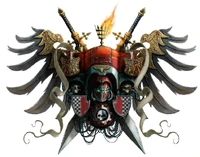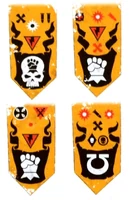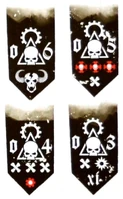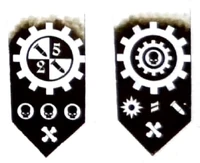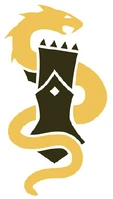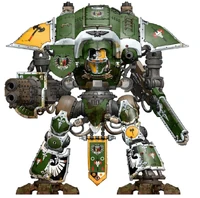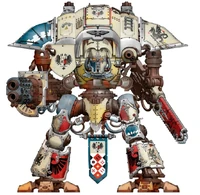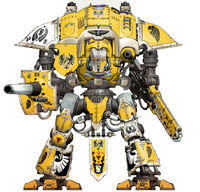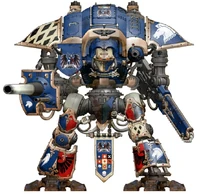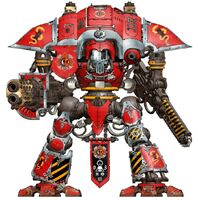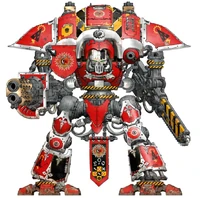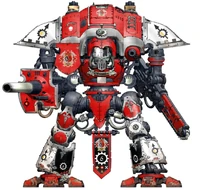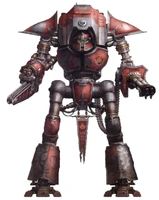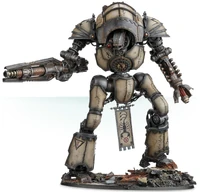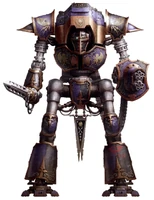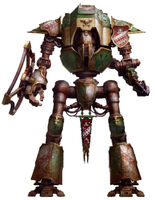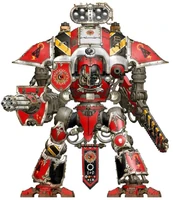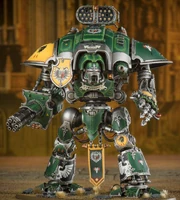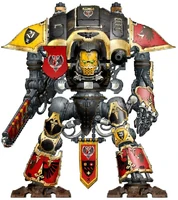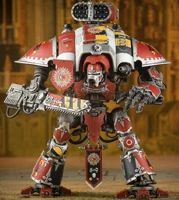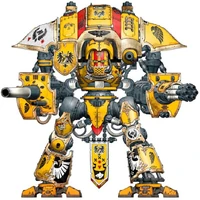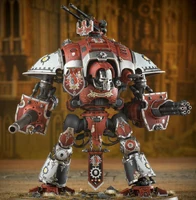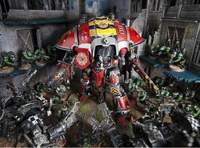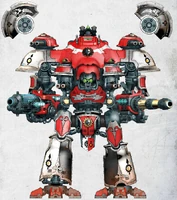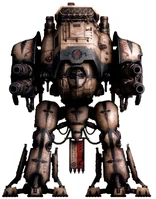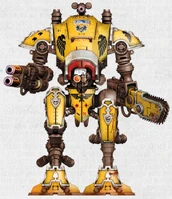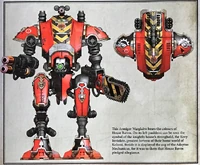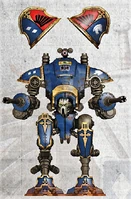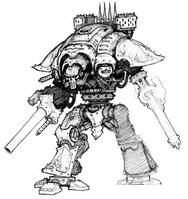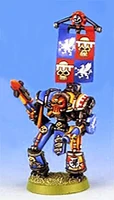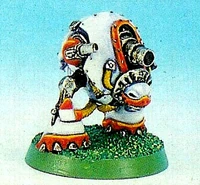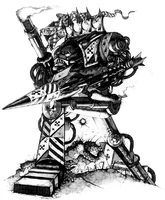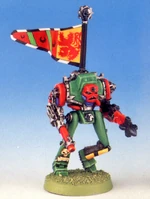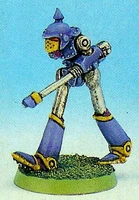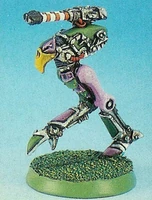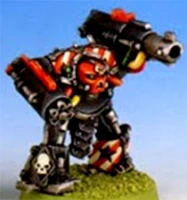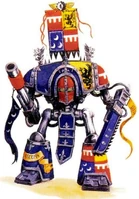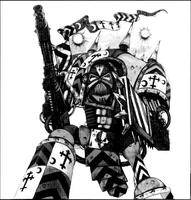"Let the power of your Knight flow through your veins. Let the ghosts of your throne whisper wisdom into your mind. Let steel be your sinews and fire be your fists. Become your Knight, as it becomes you, and through symbiosis ascend. So shall you become. So shall you protect your people and slaughter your foes."
- — Sixth Canticle of the Ritual of Becoming
The Imperial Knights, or Questor Imperialis in High Gothic, are piloted robotic combat walkers of small to medium size in the service of the Imperium and sometimes the Adeptus Mechanicus.
Each Knight is piloted by a single Human warrior drawn from an ancient feudal aristocratic culture that stretches across the galaxy.
However, a Knight is smaller and less capable in combat than even the smallest class of true Titan utilised by the Collegia Titanica, the Warhound-class Scout Titan. Knights normally deploy in squadrons comprised of several of these war machines.
These ancient battlesuits stand thirty to forty Terran feet (9 to 12 metres) tall, are protected by nearly impenetrable Ion Shields and armed with a devastating array of heavy weapons.
Imperial Knights are colossal war machines that tower over the battlefield. They are propelled into battle by powerful servos and have the power to kick over tanks and crush soldiers into red paste.
Vulnerable limbs and joints are protected by sweeping armour plates of adamantium and supported by an incorporated Ion Shield which responds to the thought-commands of its Noble pilot. The presence of just one of these towering engines of destruction is enough to change the course of a battle, and only the Titans of the Adeptus Mechanicus are more feared by the enemies of Mankind.
Knights are not mere war machines, but relics from a lost age, armoured giants from a forgotten era. One does not drive such an heirloom -- it must be bonded with. Only a Noble from an ancestral knightly house may have such an honour.
During a strange and terrible rite known as the Ritual of Becoming, the Noble fuses their mind with the Machine Spirit of the Knight -- a union of flesh and metal. Only then can the Noble truly occupy the Throne Mechanicum -- the seat of control from which they use his mind to command the towering Knight.
Thousands of standard years before the rise of the Imperium, Mankind reached out to the stars and settled many far away worlds. Among the apparatus of colonisation were formidable war machines known as "Knights," which existed to protect the settlers from any threat.
The strongholds constructed from the remains of ancient Terran colony starships are ruled by the descendants of the first Human settlers of those far-flung worlds, mighty fighters who go to war in their towering armoured battlesuits and who are sworn to protect and guard the Imperial citizens who now inhabit their worlds.
These proud and haughty warriors can trace their bloodlines back to Terra itself and are colloquially known as "Nobles" or "Scions" in Imperial society and as the Questoris Familia in formal High Gothic.
Over the millennia, the pilots of these massive war suits have established a rich culture, Noble houses each sworn to the defence of their homeworld, bound by oaths of fealty to the Golden Throne of Terra and the Adeptus Mechanicus of Mars.
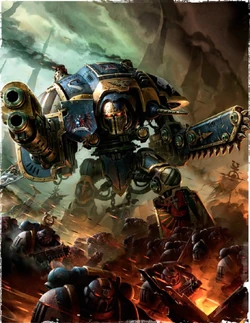
An Imperial Knight of House Terryn in combat.
Knight armour comes in a wide variety of forms, each with their own strengths and weaknesses. The two most commonly seen types are the Knight Paladin and the Knight Errant. These both use the same basic body form, but are fitted with different weapon arrays. Each is well-liked for its balanced and deadly combination of manoeuvrability, protection and firepower.
All Imperial Knights are protected by thick adamantium armour and are fitted with powerful weapon systems. Usually, this entails two primary weapons, one attached to each of its "arms," which will be supplemented by a number of secondary weapon systems fitted to its body and shoulders.
The hand-forged armour that protects each Knight was crafted long ago, and elements such as the individual armour plates, helm or crests can therefore vary considerably depending on the skill of the artisan who made them.
The armour is often lavishly detailed and adorned with complex heraldry that reveals the Knight's allegiances and the deeds he has accomplished in battle.
In addition to their weaponry, all Knights carry potent defensive field generators called Ion Shields. This ancient technology works by projecting an energy field across a narrow arc to the front of the Knight.
By quickly moving the position of the shield so that it intercepts enemy attacks, a Knight is able to survive even the heaviest fire, whilst still being able to fire its own weapons in return.
The exact setting and positioning of the shield is essential, as the Ion Shield is only designed to deflect and slow shots, rather than absorb them in the manner of the far more powerful void shields used on Imperial Titans. This means the effectiveness of the shield is partially dependent on the skill and experience of its operator.
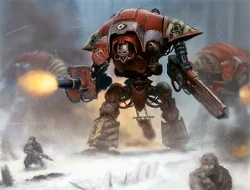
Imperial Knights in service to the Adeptus Mechanicus providing heavy fire support for troops of the Astra Militarum.
Both the Knight Paladin and Knight Errant are traditionally equipped with enormous melee weapons and are famed for their skill with them, charging into the enemy and delivering blows left and right with their massive Reaper Chainswords.
This impressive close combat capability is supported with powerful ranged weapons that can blast apart enemy vehicles, and Heavy Stubbers to mow down infantry targets.
Other, much rarer, types of Knight armour are used on some Knight Worlds. Amongst the heaviest types of Knight armour made by the Forge Worlds are the Crusader and the Castellan. Although slower than other suit types, these two benefit from substantially increased firepower and much thicker armour, and are instead used in a fire support role.
The Lancer is a faster version of a standard Knight suit. These agile machines are used to outflank the enemy, scout out their defences and distract hostile forces while slower units get into position to attack. This type of armour is sophisticated and extremely difficult to manufacture, and its use is therefore usually reserved for rulers of knightly houses, or for Nobles that have proven themselves worthy of it in the fires of victory.
However, while the Crusader, Castellan and Lancer are rightly revered, the Paladin and Errant's perfectly balanced combination of speed, firepower and armour make them the supreme examples of Knight design.
History
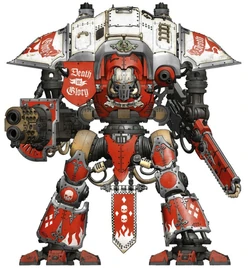
Freeblade Knight Errant Retribution Incarnate
Long before the rise of the Emperor and the birth of the Imperium, during the Age of Technology Humanity reached out to the stars, eager to occupy new worlds and expand its burgeoning interstellar empire.
Vast colonisation starships carried eager Human settlers, along with all the resources they might require, and landed on far-flung, often isolated worlds.
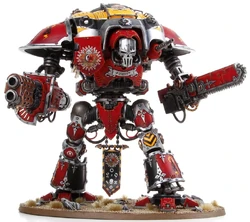
A Knight Errant of the Questor Mechanicus House Raven
The first Knight Worlds were founded at the very start of the Age of Technology, when scouts from Terra travelled far through the galaxy seeking planets to use as agricultural worlds to provide food for Mankind's burgeoning population, or as mining colonies to provide the materials needed to fuel their expansion across the stars.
Indeed, the Knight Worlds had already been established for thousands of standard years when the Imperium was first founded in the 30th Millennium.
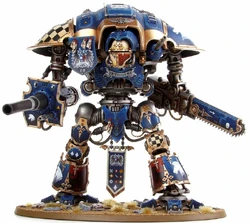
When those first Human scout ships discovered a suitable planet for colonisation, gigantic spacecraft were dispatched to settle them. These ships were part of Terra's Long March fleets, named after the duration of their voyage and their destination among the stars.
The name was apt; each of the Long March colony starships carried thousands of settlers on a solar decades-long journey to a far distant planet. Upon arrival, the colony ship would land and be immediately cannibalised by the colonists to provide the raw materials needed for their first settlements; there was no hope of return to Mankind's distant homeworld.
The struggle for survival on many of these worlds was grim. On some, the settlers found themselves the prey of vicious predators or were attacked by native alien races, which saw the Human settlers as invaders. On other worlds, extreme weather conditions or an unbreathable atmosphere made travel outside of domed habitat-zones next to impossible.
However, problems like these had been anticipated, and in order to deal with them, the settlers were supplied with Standard Template Construct (STC) databases and fabrication facilities that allowed them to build powered suits of exoarmour.
The pilots of these bipedal walking machines were protected by a hard shell of plasteel and armed with an array of military-grade heavy weapons. The suits proved invaluable: few, if any, natural predators or hostile alien warriors could stand against them, and they could travel through even the most dangerous environment with ease.
The towering armoured figures soon became a common sight on the colonies, where they were known as "Knights" by the settlers, after the legendary armoured warriors and protectors of ancient Terran history.
Compelled by the mind-altering effects instilled by the Thrones Mechanicum (a control platform that allows a pilot to interface with their Knight battlesuit), over the course of a few generations, these elite warriors gradually developed a society that evolved into the knightly houses.
The plasteel plates of the original exo-skeleton suits were slowly replaced with more ornate armour made from adamantium, providing better protection as well as a panoply befitting the wearer's prestige and rank in his society.
The more mundane duties that the Knights had once taken part in on the colony worlds -- logging with their mighty Reaper Chainswords, for example, or blasting apart rock ore with their rapid-fire Battle Cannons -- were delegated to those of lesser ranks, allowing the Knights to focus on the arts of war and governorship.
Dwelling in tall strongholds, the Nobles strove to protect the lives of their subjects (as they now saw the settlers they protected) and to bring order to the primeval maelstrom on the planets that were their homes.
The knightly houses proved to be highly successful at both of these things, and soon became a vital part of Human society during the Age of Technology.
Age of Strife
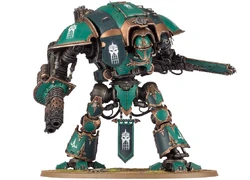
Knight Errant of Freeblade Garantius, the Forgotten Knight
Tragically, the Age of Technology was doomed to fall and devolve into a shadow of its former glory. Around the time of the 22nd Millennium AD, Mankind's vast galactic empire began to suffer a pandemic of terrible wars and massive invasions, caused, at least in part, by the emergence of the first Human psykers and the widespread use of sentient machines remembered in Human myth as the Men of Iron.
By the 25th Millennium, ferocious Warp Storms had largely isolated the widespread Human colonies, and the era that came to be known as the Age of Strife had well and truly begun.
During this lamentable era of Human history, also sometimes referred to as "Old Night," especially on Terra, interstellar travel to many of these Human-settled worlds was made impossible due to the massive Warp Storms caused by the slow gestation of the foul Chaos God Slaanesh in the days before the Fall of the Aeldari.
Although vast swathes of the Knight Worlds fell to the storm of death and destruction that defined the Age of Strife, some survived, aided considerably by the innate conservatism and resistance to change of the knightly houses.
Where other planets welcomed psykers into their midst, and revelled in the luxurious lifestyle that advanced thinking machines could provide, the knightly houses had largely shunned both, preferring to stick with the traditions and technology of the past.
Thus, when the violence that presaged the Age of Strife struck, hundreds of Knight Worlds were sidelined or ignored, and took little direct part in the terrible conflicts that tore the rest of Humanity apart.

An Imperial Knight Spearhead formation of House Terryn fights alongside the Ultramarines Chapter.
Cut off and alone, the knightly houses were quickly forgotten by the other Human colonies. Left to their own devices, the warrior aristocracy cemented their control and -- encouraged by the psychological manipulations caused by the process of imprinting their suits of Knight armour -- almost all of them enforced neo-feudal systems on their homeworlds.
During the latter years of this tumultuous age, the ancient Mechanicum of Mars began sending out many starships that made use of sublight drives to explore the galaxy in search of Standard Template Construct (STC) technologies on lost Human colony worlds.
In the course of their travels, these slow-moving exploratory expeditions discovered large clusters of Human-settled star systems that had once belonged to the ancient interstellar Human civilisation that had existed during the Age of Technology.
But these worlds had regressed during the Age of Strife to become Feudal Worlds possessed of a pre-industrial, feudal culture dominated by castes of warrior aristocrats.
The societies that evolved were built upon concepts of fealty, honour and duty; three things that all Knights hold in the greatest regard. All of the Nobles -- or Scions as they were sometimes known -- on a Knight World owed their allegiance to a knightly house, whose ruler could call upon them at any time to carry out his commands.
Each house could also field large numbers of men-at-arms, either mounted or on foot. The houses also had groups of artificers and technicians who maintained the suits of Knight armour as best they could, and over time, became an integral part of society on all of the Knight Worlds.
Sometimes the ruler of a knightly house would come from the same family for generation after generation, but more often than not, the death of an incumbent ruler would lead to a period of political manoeuvring or even outright warfare until a new monarch was selected.
Competition between different knightly houses on a planet was just as intense, and although full-scale battles were rare, all strove to outdo their rivals in any way they could, be it in the field of politics, ancient traditions, or contests of their skill at arms.
On the Knight World of Higroxias, for example, once every ten Terran years, the three major houses compete against each other in a series of trials known as the "Honour Games," the winner of which rules the Governing Council for the next solar decade.
As the Age of Strife stretched from standard centuries into millennia, the Knight Worlds became increasingly insular and inward-looking.
Each developed its own titles and terms, so that on one Knight World the ruler of a knightly house would be known as a "lord," while on another they might be called a "ritter" or "patriarch," and a Noble's stronghold could be known as their castle, fastness or mansion.
Without any outside contact, ritual and etiquette started to dominate daily life within the knightly houses, and the only escape from stultifying tradition lay in donning a suit of Knight armour and taking to the field of battle.
Coming of the Imperium
After five thousand Terran years, the Imperium of Mankind arose from the ruins of the Age of Strife. Under the guidance of the Emperor, Humanity returned to the stars and began the Great Crusade to reunite Mankind.
Nothing was able to stand in the way of the resurgent Imperial armies, and soon, Human colonies on planets all across the galaxy were brought within the fold of the newly formed Imperium.
When Rogue Trader Militant Jeffers rediscovered a Knight World, Chrysis, for the first time, he quickly realised the knightly houses could be valuable allies for the Emperor's armies.
In his reports, he pointed out the Knights' many virtues, and emphasised the world's value to the Imperium as a source of born and bred warriors.
The Administratum agreed with Jeffers' findings and set about finding the rest of the long-lost Knight Worlds. Although there were thousands of Knight Worlds at their height during the Age of Technology, the vast majority had been destroyed or died out during the Age of Strife. Now, only several hundred survive, scattered all across the galaxy.
Most of the Knight Worlds share certain features, hallmarks of the instructions followed by the original settlers. The Nobles themselves occupy sprawling walled strongholds, each a gothic, ancient structure of dusty, lifeless halls and corridors.
Many are built on the same location as the first Human settlements on the planet and include at their core parts of the giant colony sublight starships used to transport the first settlers to their new worlds. They can vary in size from small keeps to entire cities bordered by vast outer walls.
Huge farms or strip-mines surround the strongholds, providing foodstuffs and raw materials for local use and export across the galaxy; the colony ships' purpose was always to generate resources for Mankind.
It is in these settlements that the vast majority of Imperial citizens on Knight Worlds live, with few venturing more than a dozen kilometres from their place of birth.
In addition to these settlements, vast grazing herds of beasts wander through the wildernesses between the strongholds -- more often than not, these are huge reptilian creatures that were introduced to the planet as livestock in the Age of Technology.
Packs of local predators will often pursue the grazing herds or attack the farms surrounding a stronghold, and it is the duty of the Knights to fight to keep them at bay.
Even on planets with less ferocious flora and fauna, the Knights must be constantly vigilant in order to keep the herds and farms safe from alien raiders and rapacious pirates.
Forge Worlds
Most knightly houses, though by no means all, are associated with an Adeptus Mechanicus Forge World, and in return for fighting alongside that Forge World's Titan Legions, they gain access to advanced technology and knowledge that only the Adeptus Mechanicus possess.
The association between the knightly houses and the Adeptus Mechanicus dates back to the time of the Great Crusade. When the Knight Worlds were first discovered, the different Imperial organisations that made up the Great Crusade competed ferociously with each other to gain control of the valuable resource the Knights represented.
This Machiavellian political contest went on for solar decades, until the Mechanicum of Mars was finally able to establish their dominance in the right to exploit the Knight Worlds.
The Mechanicum were driven in this by a desire to gain control of the archeotech that could be found in abundance on the ancient Knight Worlds, but were also aware that the vast natural resources and military might of the knightly houses could make them a valuable asset.
To this end, once they had established their right to exploit the Knight Worlds, they set about making them dependent upon the Mechanicum for their continued survival.
At the time of the Great Crusade, the Tech-priests' space fleets found an anarchic galaxy where the ancient civilisation of interdependent Human planets no longer existed. The surviving Knight Worlds that were discovered had not retained all of their old technology and had devolved into feudal states ruled by aristocrats, the "Nobles" or "Scions" of their elite dynasties.
The Tech-priests settled amongst these feudal empires, founding many Forge Worlds, and established contacts with the knightly houses, trading with their worlds and investigating the ancient ruins where surviving technology could still sometimes be found.
The ferocious warrior Knights proved invaluable in combating enemies such as marauding Orks and land-hungry Aeldari Exodites. In return, the Tech-priests promised technical expertise and helped the Nobles to rebuild their planets to the Imperial standard of technology.
The most important thing that the Tech-priests brought to the Knight Worlds was the knowledge and technology needed to maintain the Nobles' suits of battle armour. Over the course of the Age of Strife, much of the expertise needed to keep the complex Knight armour working had been lost.
Local technicians and artificers did their best to maintain the suits, but in many cases, they simply did not have the necessary technical ability.
When the Knight Worlds were rediscovered, most had only a handful of operational suits remaining, and even these were in a poor state of repair. The Mechanicum promised to remedy this situation by inducting the local technicians that had been caring for the armour into the Cult Mechanicus, teaching them the skills they needed to keep the Knight armour in good repair.
Because of this, nearly all suits of Knight armour now bear the mark of the Cult Mechanicus as a reminder of the debt of gratitude they owe to Mars.
Over the millennia, the Forge Worlds have grown powerful, with the Knight Worlds flourishing alongside them. Year-long, the Knights battle and patrol until the great cargo ships arrive from a Forge World, bringing new Knight suits, weapons, tools and mining machinery. They leave with their holds packed with ores and food.
The Tech-priests and the Knights are now mutually dependent, and many Forge Worlds form the hub of a tiny empire consisting of a Forge World and its surrounding Knight Worlds.
In return, the Knights have gained much from the Tech-priests, their worlds gradually returning to being technically sophisticated cultures.
However, the relationship between Forge World and Knight World is not always an easy one, and nowhere is this more true than in the fraught relationship that exists between the Nobles who pilot the Knights and the Sacristans trained by the Adeptus Mechanicus to maintain their armour.
Horus Heresy

An Imperial Knight fighting against a Chaos Knight during the Horus Heresy.
The golden age of the Great Crusade was to be cut short by the supreme act of betrayal known as the Horus Heresy, during which the galaxy was gripped by the most bitter civil war Humanity had ever seen.
Across the nascent Imperium, rebels clashed with Loyalists for the fate of Mankind. Space Marines fought Space Marines, Titans fought Titans and, alongside them, Imperial Knights fought Imperial Knights.
In those dark days, nobody was to be trusted and treachery was as much a part of warfare as bolter shells, Volcano Cannons and Drop Pods. One of the most horrific betrayals of that great civil war occurred during the infamous Battle of Molech.
As the Warmaster Horus led his armies to Terra, he left a trail of destruction in his wake hundreds of light years wide. His forces seemed unstoppable as garrison after garrison fell before his might, or changed allegiance and sided with the traitorous commander.
It was on the planet of Molech that one of the most determined stands was to be made. Loyalist Titan Legions and over a hundred Imperial Army regiments and knightly houses stood ready to bear the brunt of the Warmaster's attack in an attempt to halt his inexorable advance. When it came, it was like a hurricane unleashed upon the verdant world.
Horus' initial assault devastated many cities and strongholds, and amongst the victims were Molech's rulers -- House Devine. Dispossessed and unable to fight back, the knightly house slowly succumbed to the temptations of Chaos.
Over the following solar months, the insidious whisper of Slaanesh -- Dark Prince of Chaos and god of indulgence and excess -- spread through their depleted ranks. Their officers became lethargic, interested only in their sports, using their mighty Knight suits to hunt the towering reptilian beasts that stalked Molech's lush jungles.
The seductive grip of Slaanesh grew stronger, as the Prince of Pleasure bent the force of its will to corrupting the Noble Devines.
Soon, they met in secret cabals, performing depraved rites and ceremonies within the heart of the Loyalist camp. No act was too shameful or disgusting; the sensations of the moment became their only desire.
When Horus launched a massive offensive, the Knights of House Devine committed an act of brazen treachery and turned on the troops who remained loyal to the Emperor.
The Imperial forces found themselves caught in a trap, with advancing Traitor Titans to the front and Chaos Knights attacking their ranks from behind. This treachery allowed the Chaos host to punch through the Imperial defences, leaving them with no line of retreat.
They were totally defeated, so brutally that only one in a hundred of the troops of the Imperial Army survived the campaign.
Since that first betrayal, only a handful of knightly houses have been corrupted by Chaos, even when the Forge Worlds to which they owed fealty became part of the Dark Mechanicum.
A Legacy of Honour
For millennia the Imperial Knights have woven tales of heroism and chivalry across the stars. They have been the shield and the sword, defending Humanity and slaying the monsters that would threaten its reign.
Though the darkness has closed in around them time and again, always the Knights drive it back, lighting the void with their courage and valour.
The history of the Knights is the tale of Mankind, from that race's birth upon the world of Terra to its dominion of the stars beyond. Since their creation, the Knights have left an indelible footprint upon each era of Mankind's development.
Age of Honour and Vengeance, M1-M32
- Age of Terra (M1-M15) - A combination of an enormous boom in population and Terra's rapidly-diminishing natural resources in the 3rd Millennium leaves Humanity's birth planet on the brink of anarchy. As these problems increase in severity, Mankind begins to look farther afield -- towards the stars. Mars is the first planet to be terraformed and settled. Colonial expeditions to explore space beyond the boundaries of the Sol System meet with success. However, the settlements furthest from Terra are forced to become increasingly self-sufficient due to the limitations of sublight interstellar travel.
- Age of Technology (M15-M25) - STC technology is mastered by some of the greatest scientific minds in Mankind's history and heralds a golden era of discovery, innovation and expansion. By harnessing the other-worldy gifts of the Human mutant psykers known as Navigators, Warp travel is developed, enabling starfaring ships to swiftly travel enormous distances across space. STC systems transform the way that new colony worlds are settled. The first Knight Worlds are established as Human colonies by the Long March colonists and begin to flourish on more than a million worlds across the galaxy. Towards the end of this remarkable era, the ever-increasing number of Human psykers and an over-reliance on advanced technology ultimately leads to the downfall of Mankind's glorious expansion, which descends into turmoil, anarchy and war.
- The Long March (ca. M15) - Generational Long March colony ships depart from Terra, making centuries-long voyages to settle the planets of distant star systems using sublight reaction drives. Some of the pioneer groups take with them STCs capable of creating Knight suits, and from them the first Knight houses are born.
- A Chivalrous Code (ca. M15) - As the Noble houses that rule the Knight Worlds are established, so too do the principles of duty and obedience become synonymous with the mighty war engines. Though the cultures that develop on disparate Knight Worlds are as varied as their environments, each adopts strikingly similar notions of virtue that would, in later millennia, come to be known as the "Code Chivalric."
- The Knights Stand Alone (ca. M23) - Influenced by the Thrones Mechanicum of their Knight suits, the aristocracy of the feudal societies established on each Knight World remain conservative and most are instinctively mistrustful of any psykers in their midst. As a result, many of the Knight Worlds resist the madness that grips so many other Human colonies at the dawn of the Age of Strife. Though daemonic possessions and devastating psychic backlashes do indeed threaten many Knight Worlds, the military strength of the Knights and their rigid societal organisations largely serve to protect them. The ancient records of many knightly houses bear reference to this troubled time, of Knights duelling gigantic Warp entities or battling knee-deep against an endless tide of Daemons from beyond the veil of reality.
- Age of Strife (M25-M30) - Human worlds throughout the galaxy are isolated by Warp Storms of terrible ferocity. A disastrous age of suspicion and dread begins as internecine conflict tears Human civilisation apart. Fear and superstition lead to a regression in Mankind's mastery of science and many technological marvels of the previous age are lost to paranoia and war. Aliens and Daemons alike prey on Humanity's vulnerability, and although many planets are subjugated or lost, the surviving Knight Worlds continue to stand firm through this turbulent time -- however, none do so without earning scars that linger to this day.
- The Emperor Arrives on Mars (ca. M30) - Knight Taymon Verticorda, of House Taranis, is the first representative of the ancient Mechanicum to encounter the Emperor of Mankind on His arrival on Mars. In His guise as the promised Omnissiah, the Emperor forges an auspicious alliance between Mars and the newly unified Terra that forms the backbone of his fledgling Imperium. This pact between the Emperor and the fabricator-general of the Red Planet becomes known as the Treaty of Mars, otherwise known as the Treaty of Olympus Mons to the Mechanicum. Preparations are made for a great undertaking to reunite the lost worlds of Mankind.
- Great Crusade Begins (798.M30) - The Emperor leads His long-planned undertaking to reunite the lost worlds of Mankind. The Emperor's fleets spread out across the galaxy, uniting Human worlds one by one and annihilating all who pose opposition to His rule. Those Knight Worlds that are discovered are quick to swear oaths of allegiance to the expanding Imperium of Man, with the Noble houses pledging their fealty to various Explorator fleets and Titan Legions of the Mechanicum. The Knights themselves become invaluable warriors in the Great Crusade, and by their indomitable power countless other planets are humbled. Yet in the vastness of the galaxy there are Knight Worlds upon which the Emperor's envoys never arrive. These planets continue to cleave to their traditions of old, watching the skies for the incoming threats that have hounded them during the long Age of Strife.
- First of Many (ca. 850.M30) - The Knight World of Chrysis is rediscovered. The Mechanicum uses its influence to claim exclusive trading rights with many of the Knight Worlds that are later found. Forge Worlds are established near mineral-rich Knight Worlds, and bonds of mutual respect and military support become commonplace between the Mechanicum and the knightly houses. As the Emperor's crusading fleets sweep out across the galaxy, uniting Humanity's scattered worlds one by one, numerous knightly households are with them. It is a time of restoration and glory, in which many houses form strong ties to the Explorator fleets and Titan Legions of the Mechanicum. Others pledge their allegiance and strength to particular primarchs or Imperial commanders. The Knights prove stalwart allies, the devastation they wreak more than compensating for their sometimes stilted or prickly ways, and it seems as though they will play an instrumental part in establishing the Imperium's dominance across the stars.
- Lust of the Mechanicum (ca. M30) - With unseemly fervour, the Mechanicum uses its influence to claim exclusive trading rights with many of the newly discovered Knight Worlds. New Forge Worlds are established near the most mineral-rich planets.
- Great Expansion (ca. M30-M31) - Over a hundred knightly houses are discovered and welcomed into the fold of Mankind. Because of the psychological manipulations of the Throne Mechanicum, all of these planets are feudal societies, politically conservative and dominated by the concepts of honour and fealty that characterise their rulers.
- Horus Heresy (005-014.M31) - In an act of staggering treason, the Warmaster Horus declares himself the rightful ruler of Mankind after being corrupted by the Chaos Gods. The base treachery of the Emperor's favoured son shatters the newly-founded Imperium and sets the galaxy aflame. Brother fights brother as fully half of the Space Marine Legions side with the Arch-traitor Horus, alongside numerous Titan Legions and countless regiments of the Imperial Army. Some knightly houses join the Traitors, either compelled by unbreakable oaths of fealty or tainted by the touch of Chaos. Many more Noble houses fight hard for the Imperium, winning one victory after another against the turncoat forces. On both sides, the bloodlines of a number of Noble houses are brought to an end during the incredibly fierce fighting, their lives callously expended in the name of victory.
- Battle of Beta-Garmon, The Titandeath (006-013.M31) - Numerous Traitor Titan Legions engage in battle with their Loyalist counterparts throughout the Beta-Garmon star cluster. Knight houses fight on both sides of the sprawling conflict, upholding oaths to follow the god-machines into the fray. Whole households are lost in the war zone, their once-mighty god-engines reduced to flaming wreckage alongside the metallic carcasses of annihilated Titans. House Vextrix, having marched dutifully alongside the Titans of the Legio Mortis, take severe casualties. Those Vextrix Knights who had expressed even the slightest reservation in siding with their bond-lieges against the Imperium are placed on the front lines, where they suffer the greatest losses. The conflict therefore becomes known amongst the nobility of the world of Daxos Gemini as the "Great Cull."
- Battle of Molech (009.M31) - On the planet of Molech, the sudden defection of House Devine proves to be the pivotal factor in the defeat of the Loyalist forces seeking to halt Horus' relentless advance on Terra. As the Warmaster unleashes a massive coordinated assault, the planet's defenders are thrown into disarray when the plasma reactor of the Imperator Titan, Paragon of Terra, is destroyed. Thousands of Loyalists are immolated in a blinding flash as a miniature sun erupts from the Titan's core to leave a smoking crater half a kilometre wide. In the wake of the catastrophic blast, a spearhead of Traitor Titans marches through the gap in the Imperial lines. Caught between the treacherous Knights of House Devine and Horus' rampant forces, the shattered remnants of Molech's Loyalist defenders are slaughtered without mercy.
- Great Scouring (ca. 014.M31) - Horus lies dead at the hands of the Emperor following the Siege of Terra. But so high is the cost of victory that many seek solace in hounding the fleeing Traitors across the stars rather than face the task of rebuilding the shattered Imperium. This campaign of vengeance is known as the "Great Scouring." The surviving knightly houses with the strength to fight unanimously join in this crusade of retribution. Knights are at the forefront of many such campaigns, venting their disgust, hatred and outrage upon those Nobles that betrayed them. A higher number of Freeblades join the fighting, exacting revenge for houses lost and homeworlds destroyed. Believing the honour of the many to be stained by the treachery of the few, the Imperial Knights hunt down the knightly houses that sided with Horus with extreme prejudice, seeking to redeem their tarnished reputation. Filled with righteous indignation, a combined strike force of Knights from Houses Cadmus, Terryn and Borgius annihilates the turncoats of House Devine as Imperial forces reclaim the Fallen Knight World of Molech.
Age of Banners Raised, M32-M40
- Defiance on Vorinth (544.M32) - An Ork WAAAGH! of unprecedented scale sweeps into Imperial space. Hundreds of worlds are devastated before the Ork menace is finally defeated. Lying directly in the path of the enormous Greenskin armada, the Knight World of Vorinth is one of the first planets to fall. Though they fight bravely, the Knights of Houses Illius and Nero are impossibly outnumbered and die to the last in combat with the all-conquering Orks. With the main Greenskin host advancing on Adamant Keep -- the stronghold of House Illius -- the surviving Knights of both houses gather for one last charge. The Orks are totally unprepared for the sudden ferocity of the Knights' counterattack and suffer heavy losses as the Battle Cannons of the Knight Paladins blast smoking holes in the Ork lines. The Knights Errant take advantage of the stalling Ork assault to crash into their crude vehicle squadrons and carve them to ruin. Only when a mob of twenty Stompas rampages into the fray are the Knights finally overwhelmed. Twice, the solemn tolling of the Bell of Lost Souls is heard as Terra mourns the passing of the rulers of Houses Illius and Nero.
- Daemon Tide (529.M33) - Three Imperial sectors are overrun by a vast army of the Immaterium referred fearfully to as the "Daemon Tide." Deploying into the Daemons' path, five knightly houses -- led by the renowned Nobles of House Terryn -- form an adamant bastion to halt the rampage. Using swift-loping packs of Armiger Helverins and Warglaives, High Queen Desmadara Terryn channels the Daemons through the shattered valleys of Godsmote. As the Warp-born creatures spill onto the Hollow Plain they are subjected to thunderous bombardment by two dozen Knights Castellan. The Daemons' casualties are phenomenal, yet with no concept of fear they surge onward to exact revenge. Over six hundred Questoris-class Knights storm out to meet them, enduring barrages of sorcery, flame and filth that send towering Knight suits toppling in ruin. With Queen Desmadara and her Exalted Court at the lance-point, the Knights slam into the still-vast daemonic horde. They carve a path of annihilation to its heart, the ground shaking beneath their tread, unclean ichor drenching their legs. Though empyric fiends and coruscating Warp energies tear down one Knight after another, their momentum is unstoppable. At last, with Reaper Chainswords howling and Thunderstrike Gauntlets crackling, the Exalted Courts of three knightly houses engage the masters of the Daemon Tide. The battle that follows is so grandiose and cataclysmic that it spawns a hundred songs, tales and tapestries. Several heroic Knights are slain by the enormous Great Unclean One Bolothrax, before the Knights Valiant known as Master of Iron and Fellbreaker successfully pinion the foul abomination with their Thundercoil Harpoons. With their quarry unable to move, the Knights hack the mighty Daemon apart. Bolothrax's banishment spells the end for the Daemon Tide, though they wreak much more destruction before they finally fade back into the Warp. It is on that day that Bolothrax's unending grudge against House Terryn and all its descendants is born.
- Aphex Wars (369.M34)
- A Long-Awaited Return (784.M34) - After more than a Terran century of self-imposed exile as a Freeblade household detachment, the Agaron brothers return to the Knight World of Silverdawn after the death of their father. The siblings are welcomed back as heroes after the disastrous reign of their sire. Basilio, the eldest of the three, re-establishes trade with the nearby Forge Worlds of Estaban III and VII.
- War of Recovery (104.M36) - Twelve full houses of Imperial Knights accompany an expedition led by the Adeptus Mechanicus into the system of planets known as the Mortuam Chain. Despite the fighting against the region's xenos overseers dragging on for more than a standard century, the campaign is ultimately a resounding success. Many Human colonies are freed from alien servitude. This is an irrelevance to the Adeptus Mechanicus, compared to the priceless fragments of STC archeotech that are recovered.
- Betrayal (550.M37) - The Occlusiad War, also known simply as the Occlusiad, is a major conflict that begins in 550.M37 on the northwestern fringe of the Segmentum Obscurus between the Imperium of Man and the Heretek known as the Blind King. For the first time in thousands of Terran years, a knightly house betrays its oaths of loyalty, joining the Apostles of the Blind King to cause ruinous destruction across the northwestern fringe. Though the Blind King's rogue Tech-priests are eventually defeated, the traitorous Knights of House Drakon remain unaccounted for.
- Hunt for Andronicus
- Justice (986.M38) - More than a thousand standard years after betraying their oaths of loyalty to the Imperium, the Traitor Knights of House Drakon re-emerge at the head of a twisted host of Daemon machines created by the Dark Mechanicum. The Warp-forged monstrosities are finally defeated amid the desecrated ruins of the Forge World of Solemnium, after the Iron Hands Space Marine Chapter brings them to battle. However, it is the actions of a single Freeblade Knight that travels with the Space Marines that determine the course of the war. Known only as Justice, the Freeblade displays an incredible aptitude for destroying the Chaos Knights, earning seven confirmed kills during the course of the war. Rumours abound in the wake of the conflict of quite how the lone Knight achieved such a mastery of combat against others of his kind. Of their enigmatic ally's past, however, the Iron Hands would not speak. Despite some of House Drakon's Knights escaping Imperial reprisal, their strength is now greatly diminished.
- Red Harvest of Dalanthe (888.M39) - When a harvest moon hangs in the skies above Dalanthe, the agri-workers put the children's stories of the Gorehaunter to the back of their minds. Though many citizens deride him for it, the Freeblade Knight known as Vigilantus stands on silent guard at Dalanthe's High Templus for three long solar months. When a Warp breach opens during a riot in Executioner's Square, a goliath of brass and bone rampages out through the populace. It is met in battle by Vigilantus. Though the Knight is torn limb from limb, his last act is to decapitate the raging Lord of Skulls with a blast from his Thermal Cannon, banishing it back to the Warp for another thousand Terran years.
Age of Braced Gates, M40-M41
- The Many Quests of Theodric the Wanderer (853-999.M40)
- Not Even in Death (854.M40) - A trio of Knights from House Krast join Space Marines from the Ultramarines Chapter to defend the Mining World of Gorvax against a host of Asuryani Ghost Warriors from the Iyanden craftworld. A Knight suit's Throne Mechanicum takes control after its pilot is slain by a xenos sniper, the echoes of spirits long dead guiding the unmanned Knight into battle once more. The Knight carves its way through countless wraithbone constructs before two Wraithknights, the largest and mightiest of the xenos walkers, finally bring it down in an epic duel of giant war machines. Though the Craftworld Aeldari are eventually defeated, victory on Gorvax does not belong to the living.
- First Contact with Kragh (112.M41) - The Imperium makes first contact with the Knight World of Kragh after a localised Warp storm, which has been raging for over twenty millennia, finally abates. Though much of the planet's surviving technology is revealed to be incredibly archaic, the Knight suits remain in remarkable condition thanks to a long-lost piece of STC technology. Initial attempts to integrate Kragh into the Imperial fold are met with open hostility as the planet's two knightly houses react to the perceived threat with deadly force. Peace is finally brokered by Baron Jakobus, a venerable Knight Seneschal greatly respected by both houses -- but the fragile ceasefire is jeopardised almost immediately as a trio of Tech-adepts attempt to recover the priceless STC archeotech and return it to Mars.
- Unexpected Silence from Hawkshroud (131.M41) - Facing bloody cult uprisings across the mining worlds of the Taurian Belt, Imperial Fists Captain Lynator calls upon the Knights of House Hawkshroud to lend their aid. To his shock, they fail to answer, one of only three times in recorded history and the first in three standard millennia that such a thing has happened.
- Sport for Commorragh (154.M41) - A Drukhari raid captures a House Cadmus Knight for bloody sport in the arenas of Commorragh. He bravely duels the creations of the Haemonculi for thirty solar days before eventually being rendered down by three Engines of Pain.
- Duel of the Crimson Glaives (178.M41) - The Craftworld Aeldari assault the agri-moon of Tarvel III, destroying hab-complexes in the search for ancient artefacts. Three Freeblades band together to defend the beleaguered citizens and become known as the Crimson Glaives. As soon as the last Aeldari raider is driven from the moon, the Knights vanish without trace.
- Tarsok Incursion (230.M41) - Knights of House Taranis battle a daemonic incursion on the world of Tarsok V, taking the fight to the towering Great Unclean One that leads the daemonic horde. Wading through a tide of Plaguebearers, Seneschal Halver's Knights advance on the corpulent horror while billowing clouds of flies sizzle against their Ion Shields and form drifts about their feet. The daemonic lord drowns one Knight in a tide of bile, and crushes two more beneath its weeping bulk. Yet the Knights' Reaper Chainswords carve through its rancid flesh and with a final, gurgling roar the Great Unclean One is banished. The remaining Daemons fade slowly from view, leaving the planet's surviving defenders to count the cost.
- Slaughter on the Fireplains (246.M41) - Knights of House Raven crush WAAAGH! Smogbelcha on the Fireplains of Voth amid geysers of geothermal flame, despite suffering heavy losses of their own.
- War of Six Crowns (249.M41) - In a convoluted War of Honour, the high kings of six different Noble Great Houses fight amongst themselves to establish which might claim the title of Lord of the Sextant Stars. Although warned by the High Lords of Terra to desist from such senseless and internecine madness, the headstrong Knights persist in their ancient traditions despite all the sanctions the Imperium dare apply.
- Lost Alliance (301.M41)
- The Demigod of Damaskull Falls (353.M41)
- Triumph of House Blackskull (559.M41) - The major knightly houses of the planet Scuptium VII are all but destroyed in the initial stages of a vast Greenskin invasion. Only the heroics of the world's least favoured house, Blackskull, prevent their entire sub-continent from being overrun. Eventually the last twelve Knights of the ruined house retake their entire planet.
- Crushing the Mecha-WAAAGH! (572.M41) - Led by House Raven, five different knightly houses, along with no less than a dozen Freeblades, halt the mechanised hordes of WAAAGH! Gluttok. Across several star systems, the Imperial Knights are able to counter the armoured columns of Battlewagons and looted tanks employed by the wily Gluttok. It is on the factory planet of Blastoom that the Warboss' Stompa Mob is at last brought to final battle. Leading his Exalted Court into the thick of the fighting, Grevan, the Iron Duke, smashes into a wall of Ork walkers and uses his Reaper Chainsword to rip apart Gluttok's Stompa. It is later said that the Stompa's head was taken for display in the Keep Inviolate.
- Disaster on Nalibraxis II (632.M41) - During the Yoladrian Crusade, detachments from House Cadmus land upon the swamp world of Nalibraxis II. Marching in support of Catachan Jungle Fighters infantry regiments, the Knights are caught in a sorcerous ambush by forces of the Thousand Sons Traitor Legion. With the Catachans dead or devolved into mindless Chaos Spawn, the remaining handful of Knights resolve to fight their way back to their extraction point. Power-armoured automata and scuttling Daemon Engines surround them, yet the surviving Nobles fight their way to freedom. After the battle, House Cadmus vows revenge upon the forces of the Thousand Sons, determined to expunge this stain upon their honour and spends the next three solar decades exacting it.
- The Hole in Reality (666.M41)
- Grim Tide War (742.M41)
- Shadows Over Icnarus (784.M41) - An ancient evil awakens on the Frontier World of Icnarus, Human settlements vanishing one after another. Panic-stricken, its citizens retreat to the coastal city of Inmoran and a riot erupts around the planet's only spaceport. Rising from the sea, rusted metal warriors march into Inmoran killing all in their path, a blazing god of light at their fore. Just as all seems lost, a lone Imperial Knight appears. In a titanic struggle, the unknown Knight drives the invaders back into the sea and shatters the bindings of their god, sending it screaming into the ether.
- Battle of Hellstones (991.879.M41)
- On The Trail of Traitors (883.M41) - Three entire knightly houses join forces with the renowned tank ace, Commander Pask, and his Cadian 423rd Regiment to exterminate a Renegade Titan Legion. All of the Knights at Pask's disposal are deployed in one of the largest armoured conflicts in the Imperium's history. Knight Anthonis, of House Cadmus, wins much honour during the final battle, preventing Pask's Leman Russ Tank from being crushed beneath the mighty tread of the Traitor Warlord-class Titan, Endless Hate, by blasting apart the war engine's descending leg scant moments before impact. Pask survives to lead his force to a great Imperial victory.
- Reawakening (975.M41) - In the Vidar Sector, the Knight World of Avarris is almost overrun by Necrons from the Sautekh Dynasty. Reawakening from their long slumber deep below the planet's surface, the Necron legions emerge and immediately begin a campaign of mass genocide against the planet's interloping Human population. It is only the skill of the Knights, and the effectiveness of their Ion Shields at repelling the deadly firepower of the advanced Necron weaponry, that brings the massacres to a halt. Though many are slain in the fighting, Avarris' three knightly houses slowly gain the upper hand in the conflict. As the bitter fighting grinds on, embattled household detachments of Imperial Knights gradually begin to drive the Necron forces back to their tomb complexes, and set about destroying them in their lairs.
- The Dragon Slain (993.M41) - Segmentum Command dispatches a relief force to evacuate Yorvith before it can be overrun by Hive Fleet Kraken. At their head ride a lance of Knights Errant from House Griffith, whose thunderous charge scatters the xenos swarms around Solartis spaceport. As battle rages and refugees flood aboard the evacuation ships, a Trygon erupts from the ground and winds itself around Sir Brannach's Knight. The noble Knight wrestles with the mighty bio-horror amid showers of sparks, before jamming his Thermal Cannon between its jaws and vapourising its skull in a spray of ichor. The evacuation craft take to the skies just solar minutes later, Griffith's Knights limping aboard the last ship moments before its ramp slams shut.
- Battle of Burning Skies (998.M41) - A tendril of Hive Fleet Leviathan falls upon the Agri-world of Eireius, xenos bio-horrors rampaging across its floating jungles and vapour islands. A detachment of House Raven Knights are the first Imperial reinforcements to reach the planet, rallying the beleaguered defenders around the towering Eirebian spire-cities. In the micro-gravity of Eireius the Knights leap hundreds of metres from one spire to the next, their guns hammering Harpies and Hive Crones from the sky. Even the might of the Imperial Knights cannot save the planet, although their bravery buys time for its population to escape into the void.
- Lone Guardian (Unknown Date.M41) - Sir Yannil of House Derthos swears an oath to stand guard over the beset mining colonies on the moon of Tandosa. Enthroned within Tower of Strength, his Knight Castellan, Yannil sees off repeated attacks by Drukhari pirates. Outraged at the intervention by Yannil and his ironclad behemoth, the leaders of the Drukhari raiding parties send a force of swift gunships and agile fighter craft to eliminate the impediment once and for all. Engaging his airborne tormentors as best he can, Yannil sends a missive to House Derthos for aid, then digs in and vows to hold his ground until he is relieved. It is a solar week later that Knights of House Derthos reach Tandosa. They find Tower of Strength still standing, ravaged by energy blasts and explosives, its pilot clinging to life by a thread. Around him are scattered the wrecks of the Drukhari vessels, eliminated to the last.
- An Error of Judgment (Unknown Date.M41) - The Genestealer Cult of the Withering Worm attempt to infiltrate the Noble bloodline of House Belligerus. They quickly learn the magnitude of their mistake when the conditioning of the Nobles' Thrones Mechanicum aids them in resisting the Broodmind, though not without great struggle. In a single night of fire and violence, the cult cells are driven into the open and exterminated like vermin by Belligerus' Knights.
- The Red WAAAGH! (443.998.M41) - Warlord Grukk of the Red WAAAGH! ploughs into the densely populated Sanctus Reach, his green crusade's juggernaut momentum smashing past the Space Marine homeworld of Obstiria to plunder the planets beyond. The Imperium prepares to make a stand upon Alaric Prime, a Knight World of linked archipelagos and crumbling gaols. When a flotilla of Ork rust-ships make planetfall, the knightly houses of Alaric lead their Cadian allies in a worldwide counterattack. Warlord Grukk's bullish tactics take a heavy toll on the Human defenders before the legendary Freeblade known as Gerantius, the Forgotten Knight, joins the conflict, tipping the war into a new phase of desperate battle. With the aid of the ferocious battle-brothers of the Space Wolves Chapter, Alaric Prime defeats the Greenskin hordes of the Red WAAAGH! The price of victory is steep, however, and a veil of Inquisitorial secrecy is drawn over the dire events that mark the war's culmination.
- Donatos War (Unknown Date.M41) - The knightly houses of Adrastapol launch a crusade to save the Industrial World of Donatos Primus from Heretic forces. Five Noble houses deploy their lances, led by High King Tolwyn of House Draconis, yet disaster strikes after Houses Chimaeros and Wyvorn -- their Thrones Mechanicum tainted through Chaos witchery -- turn upon their allies in a bloody betrayal. With the high king dead and the knightly forces in disarray, it falls to the young Sire Danial Tan Draconis to rally Houses Draconis, Pegasson and Minotos. Uniting the planet's scattered Imperial forces, the Knights launch a determined fight back, seeking vengeance upon the traitorous Nobles and the Word Bearers both, eventually reclaiming the world for Imperial arms.
- Fall of Phodiam (Unknown Date.M41) - A tendril of Hive Fleet Leviathan engulfs the Hive World of Phodiam. Due to Warp Storm activity, the Imperial relief force is lost, leaving Phodiam defenceless. Into the breach steps a company of Freeblades calling themselves the "Tarnished Shield," seven exiled warriors led by Ferrum Magnificat. Through selfless sacrifice and heroic effort, the Freeblades hold the Tyranid swarms at bay long enough for over a third of the planet's populace to evacuate successfully.
- Diamor Campaign (999.M41) - The Diamor System is plunged into anarchy when a combined force of the Black Legion, Crimson Slaughter and Word Bearers launch a concerted attack. Though their invasion is system-wide, the true objective of the Chaos hosts is the Adeptus Mechanicus dig site on the world of Amethal which has discovered an ancient artefact that serves as a prison for daemonic entities. A huge army of Imperial Knights, drawn from House Raven and many of the lesser houses that owe it fealty, fights in the Imperial counter-assault, over one hundred towering war engines facing off against Heretic Astartes and Renegade Titans. Though they suffer heavy casualties, the Nobles of House Raven remain undaunted. Empowered by their wrath, they storm the Chaos lines during the campaign's final battle, and are instrumental in bringing down the enemy's Titans and driving the Black Legion from Amethal for good. In the war's wake, House Raven strengthen their bonds of allegiance with both the Tech-priests of Forge World Metalica and the Blood Angels Chapter.
- A Blade in the Void (512.999.M41) - A Chaos wolf pack attacks the Imperial heavy transport Penitent Blade while en route to the war zones of Heloeum. When the vessel is boarded, the Nobles of House Krast mount their Knight suits and prepare to repel the Traitor Marines. In the vast vaulted cargo halls of the ship, the Knights crush the Traitors underfoot and blast apart their vanguard of Terminators and Helbrutes. When a fresh wave of Chaos boarders are sent against the Penitent Blade, the Nobles order the cargo hall doors opened, so they might engage the incoming assault boats. Their craft scattered and destroyed, the Traitors retreat into the void.
- Fall of Agrellan (757.999.M41) - The T'au Empire's Third Sphere Expansion surges through the Damocles Gulf before striking hard and fast upon the Hive World of Agrellan. Though the Imperial forces are hard-pressed to counter the brilliant tactics employed by Commander Shadowsun, the timely arrival of several household detachments of Knights from House Terryn soon stems the tide. Time and again, the Knights sally forth from the hive city of Agrellan Prime, breaking through the xenos lines to take a heavy toll on formations of Broadside Battlesuits and Hammerhead gunships, using their Ion Shields to counter the devastating impacts of the T'au's rail weaponry. Only the mass deployment of prototype XV104 Riptide Battlesuits forces the Knights to cease these attacks, a course of action that ultimately changes the course of the war.
- 13th Black Crusade (995.999.M41) - Warp Storms rage across the galaxy. Houses Krast and Arokon join the Imperial forces rushing to reinforce the Cadian Gate against the Chaos hordes spewing forth from the Eye of Terror. The inbound Knights of House Arokon are feared lost amid the fierce etheric tides of Warp Storm Baphomael. However, news soon filters back to the Imperium that four household detachments of Knights bearing Arokon's colours have been seen taking the fight to the forces of Chaos, shattering two large formations of Iron Warriors siege tanks with righteous fury. All told, a dozen knightly houses rush to reinforce the Cadian Gate, Taranis and Raven foremost amongst them, but even their might is not enough to prevent Cadia's fall to the forces of Abaddon the Despoiler. House astropaths cry out in horror at the omens of impending doom. Bastion fleets are recalled to their parent Knight Worlds, racing for safe anchorage before the storm hits. Everywhere the Nobles see signs of Old Night's return, bracing against the opening of the Great Rift and the appalling carnage that follows...
Age of Honour Enduring, M41-M42
- Indomitus (999.M41 - ca. 111.M42) - As the Astronomican flares back to life on Terra after the end of the local period of the Noctis Aeterna, it illuminates a riven and beset Imperium. The resurrected Primarch Roboute Guilliman declares his Indomitus Crusade, setting out to pierce the darkness of the Imperium Nihilus and drive back the resurgent forces of Chaos. House Taranis proudly pledges all but a fraction of its fighting strength to the endeavour, waking their oldest Knight suits from slumber and deploying their greatest relics of archeotech to aid in the fight.
- The Great Cull (Unknown Date.M42) - On Raisa, the number of mutants lurking in the forests explodes exponentially beneath the baleful light of the Great Rift, locally called "the Siren's Storm." As the heretical hordes swell they spill across the land, destroying agriplexes and settlements at will. Baron Roland declares a cull to end all culls, marching out from Swinford Hall at the head of his entire household. Solar weeks of slaughter follow, and the lives of many proud Knights and courageous Sacristans are lost before the mutants are finally driven back. They leave behind mountains of dead so high that the pall from blazing corpse pyres shrouds Raisa in smoke. House Cadmus raises new fortifications to overlook the deepest woodlands, even more wary now of the dangers that lurk beneath their boughs.
- Iron and Fire (Unknown Date.M42) - The Knights of Tanika march to the aid of the Iron Hands Chapter on Medusa. Led by the matriarchal huntresses of House Thorne, they battle against the Renegade Titans of the Legio Abominator and buy time for the Iron Hands' clan companies to rally and fight back. Forging steely chains of allegiance and loyalty, the Iron Hands and Tanikan Knights drive the Heretic invaders back.
- Rise of the Chainbreaker (Unknown Date.M42) - Surging from amidst the storms of the Great Rift, Warsmith Ghanshor's Iron Warriors subjugate the Knight World of Randoryn Alpha. Amidst the horrors of the occupation, the Knight suit known as Canis Rex stirs to life and frees its Noble pilot, Sir Hekhtur, from imprisonment. As the last surviving loyal warrior of House Cerberan, Hekhtur swears the Freeblade oath before setting about rescuing as many enslaved Randorynians as he can. Sir Hekhtur and Canis Rex escape the world alive, and the Noble vows to wage an endless war of vengeance against the forces of Chaos.
- War on Every Front (Unknown Date.M42) - Cries for help pour into the astropathic relays of Kolossi. With stoic determination, the rulers of House Raven despatch one lance after another, sending their Noble warriors out into the void aboard Adeptus Mechanicus Explorator ships and war barges, many never to return. The house's Sacristans cogitate that, at the current rate of deployment, Raven will have fully emptied the Vault Transcendent within one anno-cycle.
- Xenostorm (Unknown Date.M42) - House Mortan recall their questing lances as word reaches them of a vast Ork WAAAGH! on a collision course with their homeworld of Kimdaria. Rather than wait for WAAAGH! Ragrat to fall upon them, the Knights of Mortan elect to hunt the Greenskin horde as they would a single monstrous beast. So begins a bloody war across three star systems, with lances of Mortan Knights bolstering planetary garrisons and attempting to bait, slow and divide the Orks until they can be wiped out once and for all.
- Daemonic Vengeance (Unknown Date.M42) - Amidst the swirling fury of the Damocles Gulf, High King Tybalt leads the Knights of House Terryn in their latest push against the T'au invaders. They strike at the recently reclaimed T'au colony world of Shans'et, formerly an Imperial-held planet known as Gossamehr. Initially, the Terryn offensive progresses well. The Knights are supported by a force of Raven Guard Space Marines, who scout ahead of their advance and repeatedly negate the xenos enemy's rapid-manoeuvre tactics. The battle takes an unexpected turn, however, as the skies curdle into matted filth and black rain falls, rotting all that it touches. From the sucking morass rise the Daemons of Nurgle, led by the bloated abomination that is Bolothrax the Great Unclean One. In the vicious conflict that follows, House Terryn sustains terrible losses, while the vengeful Bolothrax wounds High King Tybalt sorely and fells the Knights of three of his closest blood relatives. It is only when the Raven Guard lure the T'au forces into contact with the daemonic host that Tybalt's Exalted Court are able to spearhead a breakout. The mauled Imperial forces stage a fighting retreat to their extraction point, battling droning plague creatures all the way. They leave Shans'et to the frustrated Daemons, who waste no time in making the T'au suffer.
- Malefica Crusade (Unknown Date.M42) - The fanatically pious House Thale empty the keeps of their homeworld, Glorifica, to launch a witch-hunting crusade across the Segmentum Pacificus.
- Saviours' Hunt (Unknown Date.M42) - Amidst the darkness of the Imperium Nihilus, the factory world of Drakkatoria is struck by a reality disjunction after the affect of the Great Rift damages the Webway. Tides of horrifying shadow-spawn crawl from the nether-realm of Aelindrach in the Dark City of Commorragh and infest every city on the globe. Perpetual night falls, and murderous Mandrakes and wraith-creatures hunt the terrified populace through the dark, led by the fiendish Kheradruakh the Decapitator. Drakkatoria's astropaths scream their minds bloody as they cry out for aid. Though it costs them their lives, their pleas do not go unanswered. The bastion ships of House Griffith arrive in orbit. Their heavy landers surge down through the shadow-choked atmosphere, disgorging hunting lances by the dozen into Drakkatoria's nightmarish urban sprawl. The campaign that follows is a vicious affair. Griffith Armigers sweep through the industrial ruins, banishing the shadows with their hull-lumen and using their weapons to flush out packs of Mandrakes into the guns of the larger Knights. Hissing nightmares emerge impossibly within the cockpits of Knight suits, knifing screaming Nobles to death in frenzies of violence. Brave Sacristans pilot their landers into the darkest zones, lighting vast brazier circles to drive back the shadows and the terrors that lurk within them. The tide finally turns when a trio of Griffith Dominus-class Knights manage to forge a path to the shattered Webway spar that began the madness, and subject it to sustained bombardment. Sensing the link to their dark dimension closing, those shadow creatures still able to retreat do so, returning to Aelindrach. Those that cannot slink into the darkest depths they can find, fleeing the return of dawn on Drakkatoria. House Griffith claim victory over the battered ruins of the industrial cities, though the planet's populace will never sleep soundly again.
- Against the Storm (Unknown Date.M42) - Hastoria II faces a daemonic apocalypse as the coils of Warp Storm Baphomet engulf it. Yet the planet's Novamarines and Cadian defenders receive aid unlooked for when the Freeblade known as the Stormwalker arrives. Supported by the Knight Castellan's massive guns, protected by its crackling shields, the Imperial forces stage a determined stand that at last halts the Daemons before the Shrine of Saint Hastus.
- A Time for Vengeance (Unknown Date.M42) - Far from being dismayed at the sudden ascendancy of Chaos, House Krast relishes this chance to take revenge upon their hated foes. No less than six Crusades of Vengeance are launched from Krast's home Knight World of Chrysis, spearing through the void towards the Forge Worlds of Voss, Phaeton, Urdesh, Stygies VIII, Artemia Majoris and distant Graia. As they link up with Adeptus Mechanicus forces, Krast's bloodthirsty crusades gather pace, driving the Traitors before them.
- Debts Long Owed (Unknown Date.M42) - Already stretched dangerously thin, House Hawkshroud find themselves in deadly peril as the Orks of WAAAGH! Zagsmasha descend upon their homeworld of Krastellan. Cries for help are sent, debts long owed called in at last from the many allies that Hawkshroud have so selflessly aided over the millennia. Most fall upon deaf ears, but on Baal, Valhalla and Dragon's End, relief forces begin to muster, while in the Empyrean, the Primaris Space Marines of the Valiant Blades turn their ships' helms towards Krastellan. Whether these reinforcements will arrive before the homeworld of House Hawkshroud is overrun remains to be seen.
- Here Be Dragons (Unknown Date.M42) - The Questor Mechanicus world of Altevfor is ravaged by fire-breathing packs of Heldrakes that swoop through its polluted atmosphere and wreak havoc amongst its manufactoria. Princeps Adalace orders the attacks ended, and her Sacristans use their macro-cogitators to determine that the Heldrakes are striking from the mountaintop forge-temple of Gammapeak. Princeps Adalace mobilises her Exalted Court and the vast majority of her world's Knights, and leads a determined attack up the slopes of the mountain. The Knights discover hundreds of mechanical Chaos dragons roosting amidst the ruined forge-temple, and for solar days the smog clouds that wreathe the mountain are lit by flame and gunfire. When finally the princeps and her much reduced knightly lances march back down the mountainside, the Heldrakes are no more.
- War of Death's Welcome (Unknown Date.M42) - A splinter fleet of Hive Fleet Hydra ploughs down upon the Knight World of Death's Welcome. Morbid nihilists who worship the Emperor as the harbinger of war and ending, the houses of Death's Welcome greet the Tyranid invasion not with terror, but sombre rituals of celebration. Marching out in Knight suits of sable and bone, singing dirges from beneath their chain mail veils, the Knights of Houses Drudge, Fervans and Scythe prepare to meet their long-foretold end. The war is spectacularly violent, with tidal waves of Tyranid beasts crashing against the Knights' lines. The Nobles' guns reap thousands of xenos by the solar minute, only for the next wave to scramble atop the bodies of the fallen and hurl themselves at the Knights in turn. Rippers slither in rivers up the legs of Knight suits to gnaw through hydraulic cables and clog workings with their corpses. Hormagaunts and Termagants erode the Knights' armour plating through sheer weight of bioshot and claw, and then tear and stab at vital systems. All across the battlefield Knights are lost, falling into an endless writhing sea of xenos creatures. Yet still the Knights of Death's Welcome fight on, their hymnals growing ever louder and more fervent as the end approaches. Against all expectation, the surviving Nobles find the Tyranid tide ebbing, then drying up altogether. Hydra's bio-ships flee orbit, their reserves of biomass dangerously spent. Just eighteen Nobles remain alive from a starting force of over four hundred yet through their survival, Death's Welcome also endures.
- A Claim Denied (Unknown Date.M42) - Craftworld Aeldari raiders from Alaitoc launch a sudden, shocking assault upon Voltoris, the homeworld of House Terryn. The cause of this aggression is unclear, but the response is swift. Alongside the famous Chainbreaker and Canis Rex, the Knights of House Terryn fight to drive the xenos from their world. Casualties are heavy on both sides, but it is the will of the Aeldari that breaks first.
- For the Omnissiah (Unknown Date.M42) - Though they are of Imperial alignment, the knightly houses of Avarris launch a stinging assault across the Vidar Sector to relieve the heretical siege of Forge World Triplex Phall.
- The Necrons Awaken (Unknown Date.M42) - What begins as an isolated conflict between the Adeptus Mechanicus and the Necrons on the Quarry World of Amontep II over the strategic mineral known as blackstone becomes a galaxy-wide war. Across the planets of both the Adeptus Mechanicus and the Knights, Necron presence is suddenly and startlingly revealed. The mountains of Auros IV rumble with tectonic tremors as Necron tombs awaken beneath the surface of House Vulker's fiefdoms. On Voltoris, the recently healed High King Tybalt of House Terryn recalls swathes of his house's Knights from the Eastern Fringe, jeopardising their chances of winning an ongoing war against the T'au Empire to counter an emergent Necron threat upon Terryn's homeworld. Dozens of Forge Worlds issue calls for reinforcement from their satellite Knight Worlds as Necron tombs stir to life beneath their foundations, yet the Noble houses are equally beset. Many believe that the Necron awakening has accelerated as a response to the birth of the Great Rift, but whatever the truth of the matter, well over half of all the Imperium's Forge and Knight Worlds are now besieged by the ancient race.
- Renegades of Dharrovar (Unknown Date.M42) - Sir Drantar of House Taranis is sent to hunt down, once and for all, the lunatic Knight known as Litany of Destruction. Drantar and his Knight Red Might follow the trail of auto-infectious madness that spreads in the Litany's wake, their hunt taking them to the Nachmund Gauntlet, and the contested world of Dharrovar. The world is home to the traitorous Knights of House Mandrakor, and it is there, amidst constant Knight wars, that Red Might and the Litany of Destruction clash at last...
Knight Worlds
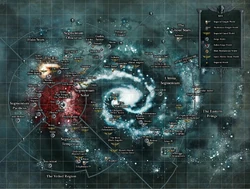
The Knight Worlds of the Imperium, ca. 999.M41
There are many hundreds of Knight Worlds scattered throughout the vast empire of Mankind. The bold explorers of Humanity's first expansion travelled far and wide into the galactic wilderness seeking habitable worlds or planets that could otherwise be terraformed to sustain Human life.
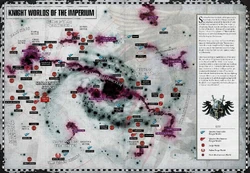
The Knight Worlds of the Imperium after the formation of the Great Rift in 999.M41.
Many of these exploratory fleets were equipped with Knight STC technology, enabling them to protect the colonies they established. More than fifteen Terran millennia after their ancient ancestors set out into the stars, the distant descendants of these colonists dwell still on Knight Worlds across the Imperium.
Though many knightly houses have risen and fallen over the ages, those that remain can trace their heritage back to a time before the birth of the Imperium, and are justifiably proud of their ancestry. Thus is every Knight World heavy with the weight of the past, regardless of its galactic location or level of technological advancement.

The locations of the surviving Forge Worlds and Adeptus Mechanicus-aligned Knight Worlds after the formation of the Great Rift in 999.M41.
The knightly houses found on each of the Knight Worlds are affiliated broadly with either the Imperium of Man as one of the Questor Imperialis or more directly with the Adeptus Mechanicus as one of the Questor Mechanicus. The Knight Worlds aligned with the Imperium are expected to adhere to the Imperial Tithe as does any other planet, but still trade with the Adeptus Mechanicus to keep their Knight suits operational.
The Knight Worlds with direct ties to the Adeptus Mechanicus are often found near to the parent Forge World with which they are associated. This is no mere coincidence, for many of these Forge Worlds were specifically founded near to already extant Knight Worlds in order to harvest their natural resources.
The Titan Legions that set forth from these Forge Worlds to battle the enemies of Mankind often do so in the company of their allies from the Knight Worlds. A partnership between both Forge and Knight World is mutually advantageous to both factions, their military strength great enough to shatter cities and conquer worlds.
Notable Knight Worlds
- Stryken System - Situated far in the galactic northwest, the Stryken System's principal planet is the smoke-wreathed Forge World of Stryken Primus. The system's industrial heart is protected by a ring of three Knight Worlds in close proximity -- Stryken II, IV and V -- and each is home to several knightly houses. These verdant planets were once Maiden Worlds of the Aeldari. The ancient tribes of Exodites that dwelt there, herding the many different species of giant reptiles and bipedal carnivores, were ruthlessly driven from these worlds by the knightly houses that were established shortly after Mankind's arrival. With the combined might of no less than eleven knightly houses to call upon, including such luminaries as Houses Arokon and Dorath, the Forge World of Stryken Primus has no Titan Legion stationed upon its surface. The planet instead focuses on supplying munitions in enormous quantities for the Imperial forces defending the Cadian Gate. A standing guard of Knights -- the "Order of Iron" -- is always present on the surface of the Forge World to ensure its protection. Drawn from amongst the greatest and most capable Nobles from each house, competition to be accepted into the Order of Iron is fierce, and it is considered a great honour to join their ranks. The head of the order is given the honorific title of "forge warden," and leads the Knights in battle as if they were a ruler of their own knightly house.
- Alaric Prime - Located in the Sanctus Reach on the edges of the Segmentum Obscurus lies Alaric Prime, an ancient and hidebound world of toiling peasants and haughty Nobles. It is covered mostly in sulphurous seas, viscous chemical tides and currents devoid of all but the hardiest of lifeforms. Dotted across the burning acidic oceans, the planet is made up of islands strung together in hemisphere-spanning chains or standing alone thousands of kilometres from the nearest foreign shore. Unlike many Knight Worlds, Alaric Prime boasts numerous knightly houses, each masters of a different region of the planet. Technology is limited on Alaric Prime as the result of ancient law, and most souls live simple lives of hard labour, scratching at the ground with tools of wood and iron. At the centre of the biggest landmass is Sacred Mountain, a blessed peak that rises from the heart of Alaric Prime's largest island. Beneath the mountain there is rumoured to be a vault of archeotech and lost lore, over which the notable Freeblade known as Gerantius the Forgotten Knight stands guard. Ancient and mysterious, Gerantius has defended the vault, and the world of Alaric Prime, since time immemorial. Whenever the planet is threatened the Forgotten Knight will rise form his tomb, and march upon the enemies of Alaric.
- Avarris - Just beyond the far eastern reaches of the Ultima Segmentum lies the war-torn Vidar Sector. The barren Knight World of Avarris can be found within this system, founded unwittingly by its first Human settlers on a planet once belonging to the Necron Sautekh Dynasty. Thus, it was a great surprise to the knightly houses established on Avarris when, in 975.M41, legions of reawakened xenos machines emerged from their stasis tomb complexes far beneath the planet's surface to assail them without warning. Fortunately, the Gauss Weaponry of the Necrons, normally so mercilessly efficient at eliminating armoured targets, was somewhat confounded by the Ion Shields of the Knight suits. With no less than three knightly houses present on Avarris, Imperial forces were able to respond to the sudden Necron attack with immediate and brutal effect. War still rages on Avarris, but the Imperial Knights have already made several successful forays into the vast underground tomb fortresses of the Necrons. Indeed, the rulers of the three knightly houses are confident that the xenos threat on Avarris will soon be overcome, and they will be able to lend their aid to the other Imperial forces fighting throughout the sector as part of the defence against the undying machine warriors.
- Chrysis - House Krast hails from the Knight World of Chrysis, and was the first of its kind to be rediscovered at the outset of the Great Crusade. The proximity of Chrysis to the Sol System saw it quickly fall under the jurisdiction of Mars. However, Krast was the only knightly house on Chrysis to survive the calamitous events of the Horus Heresy, forcing its ruler to rely heavily on the Forge World’s support to recover his losses. Thankfully, Mars was happy to oblige, for it was desperate for resources and Chrysis still had them in abundance.
- Dragon's End - The volcanic Knight World of Dragon's End is named for the reptilian winged drakes that, millennia ago, soared on the thermals and preyed on the vast megasaur herds that grazed in the valleys before they were hunted to extinction. It was the arrival of the planet's first Human settlers, and the foundation of House Griffith soon thereafter, that saw irrevocable changes made to the planet's primordial ecosystem. The colonists brought with them a huge number of Terran horses, and the Nobles that would eventually go on to found House Griffith became adept riders. But as their colony expanded, the Humans sought to claim dominance over the megasaur herds, leading to inevitable confrontation with the dragons that fed upon the giant creatures. Before the first Knight suits were completed, the Nobles took to fighting the dragons on horseback, clad in baroque armour crafted from locally-mined obsidian. Against such terrible creatures, the Nobles were forced to become great warriors in order to overcome them. The mightiest of their number was Nathaniel, who slew three dragons with his dragonbone lance before eventually becoming House Griffith's inaugural ruler. Even though the Knight suits enabled the Nobles to finally overcome the dragons, they never forgot the skills they had mastered. To this day, Griffith's Knights are amongst the very deadliest in battle.
- Dutonis - The Knight World of Dutonis is an acrid, volcanic world that sits in the galactic northeast of the Segmentum Obscurus. Ever tinged with the bitter taste of sulphur on the wind, it is a world of great material value to the Imperium, for it is ripe with mineral ore and rich veins of adamantium fork throughout the planet's mountainous crust. Despite being bitter rivals, two knightly houses –- Navaros and Borgius –- have long protected Dutonis from those who would seek to claim this priceless metal for themselves. In this task, they have fought against both alien and Traitor alike, for it would be unthinkable should such quantities of this invaluable ore fall into the wrong hands.
- Kolossi - The Fortress World of Kolossi is the homeworld of the Adeptus Mechanicus-aligned House Raven. This world is ruled by the Iron Duke of Kolossi, Lord Grevan Raven, fourth of his name, where he sits upon the Adamantium Throne of the Keep Inviolate, greatest of the knightly fortresses and capital city of House Raven's homeworld. Thousands of standard years ago Kolossi was a virgin world of verdant plains and forested mountains. However, the early Human settlers built legions of Knights, their industries strip-mining the Koliss continents for materials. In time, the society of Kolossi stratified and House Raven rose to prominence among the settlers. By the time House Raven made its enduring alliance with the Forge World of Metalica, Kolossi had been reduced to open pits, towering slag heaps and smog-wreathed manufactoria lit only by guttering promethium flares from soot-stained chimneys. This degradation of Kolossi has only worsened through the millennia. In addition to House Raven's own mineral needs, Metalica has added their own demands upon Kolossi. Only a handful of cities remain on the planet, islands of steel and smoke amid the deep-core shafts and strip-mine canyons.
- Krastellan - Located in the northern reaches of the Ultima Segmentum close to the Blood Angels Chapter's homeworld of Baal lies the Knight World of Krastellan. An eerie, haunted place, its desolate moors and black hills stretch in all directions under skies heavy with freezing rain. The Krastellian villages huddle from their perpetual miserable weather in windswept valleys and broken shorelines and their people eek out a life from herding docile heath-cattle or fishing the edges of the foaming, storm-tossed sea. On craggy, rain-slick rocks ancient stone keeps are home to the Nobles of Krastellan, where their households and families live in drafty, dripping rooms by the sputtering light of open fires. While other Knight Worlds embrace a degree of advanced technology, the Nobles of Krastellan see anything more than is required for the continued operation of their Knights as an extravagance and the first step on the road to weakness. This bleak and harsh world is home to House Hawkshroud, a proud and noble Knight House that has cultivated an impeccable reputation for honouring its debts and keeping its word regardless of the personal cost.
- Molech - The former Knight World of Molech was home to the traitorous House Devine. When the golden age of the Great Crusade was cut short by the supreme act of betrayal known as the Horus Heresy, across the nascent Imperium, Loyalist clashed with Traitor forces. In those dark days, nobody was to be trusted and treachery became all too commonplace. Dispossessed and unable to fight back, the knightly house slowly succumbed to the temptations of Chaos. Over the following solar months, the insidious whisper of Slaanesh -- Dark Prince of Chaos and god of indulgence and excess -- spread through their depleted ranks. Their officers became lethargic, interested only in their sports, using their mighty Knight suits to hunt the towering reptilian beasts that stalked Molech's lush jungles. The seductive grip of Slaanesh grew stronger, as the Prince of Pleasure bent the force of its will to corrupting the Noble Devines. Soon, they met in secret cabals, performing depraved rites and ceremonies within the heart of the Loyalist camp. No act was too shameful or disgusting; the sensations of the moment became their only desire. When Horus launched a massive offensive that climaxed in the Battle of Molech, the Knights of House Devine committed an act of brazen treachery and turned on the troops who remained loyal to the Emperor. The Imperial forces found themselves caught in a trap, with advancing enemy Titans to the front and Chaos Knights attacking their ranks from behind. This treachery allowed the Chaos host to punch through the Imperial defences, leaving them with no line of retreat. They were totally defeated, so brutally that only one in a hundred of the Imperial army survived the campaign.
- Raisa - Far to the galactic south lies the heavily forested Knight World of Raisa. The native flora of this lush world grows with such virility that only the vast plateaus that pierce the evergreen canopy are free from their touch. From atop the largest of these highland plains rises the towering stronghold of House Cadmus, Golem Keep. This monolithic edifice was named after the mighty native fauna known as "elementals" that once haunted the planet's wildernesses, before they were hunted to extinction by the first Imperial Knights to settle on Raisa many thousands of Terran years ago. Now, the only sentient creatures to stalk the murky, overgrown trails beneath the forest boughs are an unstable strain of barbaric Abhumans. Though the Knights of House Cadmus could effortlessly slaughter the wild tribes descended from their ancient forebears, they choose not to. But it is by no means a misguided sense of loyalty to these pitiable creatures that stays their hand; it is in fact tradition. Instead, the Knights take part in an annual event known as "the Cull" to keep the mutants' numbers in check and provide an opportunity to hone their hunting skills.
- Rapture - The paradisiacal Knight World of Rapture was once the shining jewel of the Reductus Sector -- but the terrible aftermath of an attack by a tendril of Hive Fleet Leviathan left the planet a near-lifeless husk. Rapture is now a Dead World, uninhabitable by Human life anywhere outside of the last surviving hab-dome. Though the fateful Tyranid assault on Rapture was ultimately defeated, the cost to the Imperium was dear. The stalwart survivors of House Aramos, however, refuse to abandon their ruined world, unwilling to sully the memory of their ancestors, who first settled Rapture some fifteen standard millennia ago. From their stronghold of Auric Keep, the Knights of Aramos launch daily sorties beyond the walls of the hab-dome to hunt the persistent Tyranid broods that were able to endure the Imperium's vengeful purge in the wake of the Leviathan's defeat.
- Voltoris - Out in the Eastern Fringe lies the tranquil world of Voltoris, home to the mighty Knights of House Terryn. Vast green oceans surround tropical islands the size of continents. Bat-winged monstrosities hunt beneath the jungle eaves, and the giant amphibious predators that are similarly commonplace offer the Knights ample opportunity to perfect their hunting skills. But despite the planet's solitary location having spared this idyllic paradise from many of the terrible events that have beset the Imperium over the millennia, the Knights that dwell there are nonetheless amongst the most warlike of their kind. These Knights commonly travel across the galaxy to defend the Imperium in far-flung campaigns, in a bid to find foes worthy of their skills. In more recent centuries, however, the Knights of House Terryn have been forced to fight ever closer to home. The dual threats posed by Hive Fleet Leviathan and the rapidly expanding T'au Empire ensure that Terryn's Knights remain on a constant war footing, lest Voltoris itself be threatened. Unfortunately for their enemies, these warriors relish any excuse for battle.
Questoris Familia
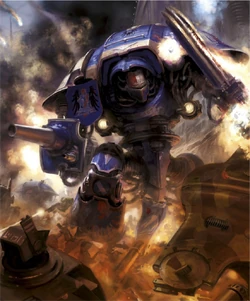
An Imperial Knight Paladin in battle.
The descendants of the early Human pioneers who settled their respective worlds were found in the knightly houses of the Imperial Knights. Known formally in High Gothic as the Questoris Familia, these dynasties of Imperial nobility evolved from the need to protect the early Human settlers of the Knight Worlds from indigenous species discovered on their alien planets.
When the original settlers arrived on distant worlds they cannibalised their sublight colony spacecraft, using the parts for the raw materials of survival. The Imperial Knights now dwell in massive strongholds, foreboding martial structures, the heart of which contains advanced technologies taken from these ancient colonisation vessels.
The formal, functionary roles of protector and castellan present on many of these worlds developed over time into the structure of the Noble houses that was old when the Imperium of Man was in its infancy. The curious fact that the knightly houses are often uncannily alike in culture and structure despite their far-flung nature is explained, at least in part, by the union of Noble pilot and their suit of Knight armour, known as the Ritual of Becoming.
Connecting at a neural level with the War Spirit (artificial intelligence) of a suit of Knight armour has a profound effect on the consciousness of the pilot. The joining of Human mind and War Spirit has helped to create cultures which appear uncannily similar across the galaxy, despite evolving on worlds that are far apart, possess entirely different environments and have never shared formal communication.
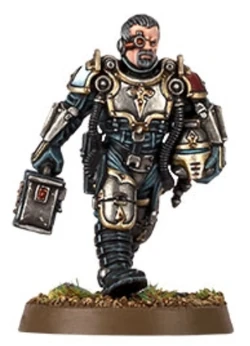
A Noble of the Questoris Familia preparing to board his Knight and pilot it into battle.
The Imperial Knights are characterised by their independence. They are bound to the Imperium, and in many cases to the Adeptus Mechanicus by oaths of fealty, but they are not subjects in any true sense of the word.
Their culture and society predates the Imperium by thousands of Terran years, way back before even the Age of Technology began in many cases, and it is informed far more by the bonds between a Noble pilot and their Knight suit than any outside influence.
Theirs is a culture of relentless, formalised ritual. It is a society that exists around a stultifying observance to apparently pointless ceremony and endless courtly mundanity.
Against this tableau of formalised ritual are the Knight pilots. They are a breed of warriors who find their only joy in battle, and they yearn constantly to escape the oppressive dullness of courtly life and ride their Knight suits to war. The thrill of battle and the risk of death is an infinitely preferable experience for them to the monotony of life within their fortresses.
These are warriors born to their calling and raised for nothing other than war. They spend every moment they can preparing, training and planning for battle -- the alternative is simply too dull for them to even contemplate.
Great Houses
There are many hundreds of Knight houses in the Imperium, each with its own unique heritage. Of all the knightly houses, there are some that stand as giants amongst their peers.
Having attained their esteemed position by performing legendary deeds, or perhaps earning the favour of one of the Imperium's great institutions, these "Great Houses," as they are known, are the mightiest of all knightly houses.
Listed below are some of the most notable Great Houses of both the Questor Mechanicus, who have sworn their primary fealty to the Priesthood of Mars, and the Questor Imperialis, those houses that serve the Imperium directly.
Questor Mechanicus
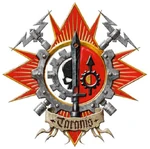
House Taranis heraldry
- House Taranis - The first of the knightly houses to be established was that of House Taranis. This truly ancient house predates any other by many hundreds of standard years, for it was first founded on Mars during the Age of Terra. As the industries of the Red Planet developed into a vast metropolis of advanced technological mastery, so too did it evolve to become the first and foremost of the Forge Worlds, and the Knights of House Taranis were its guardians. The STC technology supplied to many of the expeditionary fleets during Mankind's first expansion across the stars included designs for armoured suits of exo-armour based on those first developed to be used by the Knights of Taranis. When the Knight Worlds were first rediscovered during the Imperium's Great Crusade many thousands of years later, it is likely that the ancient Mechanicum used their intimate knowledge of the Knight suits worn by House Taranis to help win the loyalty of those worlds.
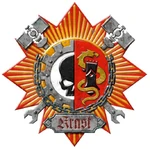
House Krast heraldry
- House Krast - The Knight World of Chrysis was the first to be rediscovered at the outset of the Great Crusade by Rogue Trader Militant Jeffers. Its proximity to Mars meant that the knightly houses of Chrysis were able to swiftly resupply their Knights with new weapons and equipment. Foremost amongst these knightly houses was Krast, and their strength at arms was bolstered further still by their new alliance with the ancient Mechanicum. Gladly did the full might of House Krast set forth at the bidding of Mars to fight in the Emperor's wars, leaving the lesser houses to consolidate the alliance with the Mechanicum on Chrysis. However, the Knight World's proximity to Mars was to ultimately prove its undoing when the full might of Horus' Traitor forces descended upon Chrysis as he carved a bloody path across the galaxy towards Terra. The Knights of House Krast returned to their planet only to find it devastated and its lesser houses all but erased from existence. Ever since the Horus Heresy, the Knights of House Krast have vowed that whenever the threat of Chaos rears its malformed head, they will be there to sever it at the neck.
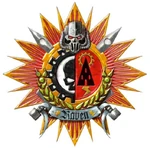
House Raven heraldry
- House Raven - Of all the knightly houses in the Imperium, House Raven is the largest by far. Indeed, Raven's Knights number in the hundreds, with dozens of households ready to answer the summons of the Adeptus Mechanicus should they be called to war. Quite why there are so many Knight suits available to House Raven is something of a mystery. However, ancient records dating back to when their world, Kolossi, was first settled refer to a piece of STC archeotech that long ago fell into disrepair and was lost. Whether this STC system and Kolossi's natural resources served as the perfect combination for producing Knight suits, or if the first Human settlers merely prioritised the creation of Knight suits above all else, remains an enigma. House Raven first allied itself with the nearby Forge World of Metalica during the Great Crusade in the late 30th Millennium. Lord Gregor Raven, House Raven's ruler at that time, struck a deal with the tech-adepts of Metalica to ensure that his house would have sufficient Sacristans to service his full host of Knights. In return, Gregor swore eternal fealty to the ancient Mechanicum of Metalica -- a pact that remains to this day with the Adeptus Mechanicus faction of that Forge World.
Questor Imperialis
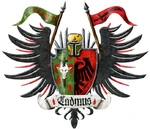
House Cadmus heraldry
- House Cadmus - For thousands of standard years, the Knights of House Cadmus have gathered every midsummer's eve to prepare for an annual hunt to keep the mutant numbers of their forested world of Raisa in check. This much-celebrated event is known as "the Cull." Bio-reading cogitators are attached to their Knight suits before every Cull, enabling each Knight to track the number of savages they have slain during the course of the standard-day-long hunt. The Knight who claims the greatest number of kills is the winner of this macabre tourney, and will rule the affairs of the house for the next Terran year. So has the leadership of House Cadmus changed hands with far greater frequency than any other knightly house over the centuries. However, the current ruler, Baron Roland of Swinford Hall, has retained command for the last thirty-two standard years, such is his incredible run of victories in the Cull. It is well that a leader of such experience still rules, for the fighting strength of House Cadmus has suffered greatly in defence of the nearby Forge World of Gryphonne IV after it was overwhelmed by Hive Fleet Leviathan. A grim future yet awaits House Cadmus if the Tyranid menace cannot be defeated.
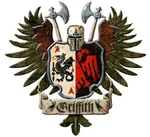
House Griffith heraldry
- House Griffith - The Knights of House Griffith are a fierce and proud warrior caste who value courage and skill at arms above all else. Duels of honour are commonplace amongst Griffith's hot-headed Knights. A regular jousting tourney, the Field of Adamantium, dictates the standings of each family in society; a Knight can be preeminent one day, but overshadowed the next, should one of his rivals emerge triumphant. The Knights of House Griffith use Knight Errant armour almost exclusively, the exo-suit's powerful Thermal Cannon befitting these close-range specialists. Such is their aggressive nature, however, that many of Griffith's Knights eschew the use of ranged weaponry in battle unless absolutely necessary, preferring instead to charge forwards and strike down their foes with Reaper Chainswords in glorious combat.
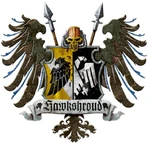
House Hawkshroud heraldry
- House Hawkshroud - To the noble Knights of Hawkshroud, honour is the single most important virtue of all. So essential to their way of life is the esteem and reputation of their house that Hawkshroud's Knights will honour any call to arms from those that have earned their loyalty or respect. It is for this reason that, at any given time, almost all of House Hawkshroud's Knights are away on campaigns to uphold past alliances. Though he would never admit it, the ruler of House Hawkshroud, Viscount Tudon, fears the day that his homeworld of Krastellan comes under attack. With so many Knights scattered across the galaxy, his skeleton force would need significant support to defend Krastellan against a determined enemy. But would Hawkshroud's allies come to their aid as readily to honour past bonds of friendship?
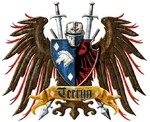
House Terryn heraldry
- House Terryn - Hailing from the tranquil world of Voltoris, the Knights of House Terryn have earned countless battle honours over the ages. Their house's storied history is replete with tales of valour, strength and glory in battles fought from one side of the galaxy to the other. But it is said that the tedium of their daily life at their stronghold of Furion Peak only encourages them to campaign so far away from their peaceful home planet. Some may jest at such a notion, yet there is undoubtedly a kernel of truth behind this -- after all, House Terryn is famed almost as much for the laborious ceremonies they stringently adhere to as they are for the magnificent skills their Knights display in battle. The daily intonation known as the "Thousand Canticles of War Long Awaited" is one such ritual, and lasts nearly three solar hours.
Lesser Houses
There are hundreds of lesser knightly houses scattered across the Imperium whose deeds, no less impressive than those of the Great Houses, are not as well known beyond the boundaries of their own planetary systems.
There are the houses of Mortan, Althalos and Thalmus, who saved more than 100 billion lives by defending the Hive World of Hexis Alpha when a Warp rift spawned a tide of Daemons across the planet.
House Dorath's valiant Knights have ever dominated the ranks of the mighty Order of Iron -- the elite guardians of the Forge World Stryken Primus.
The ebon Knights of House Winterveil have thwarted dozens of Drukhari raids in the systems surrounding their homeworld, earning bitter enmity from the scions of Commorragh.
Sacristans
Tech-priests refer to the Knight World artificers and technicians that are inducted into the Cult Mechanicus as "Sacristans," and this quickly became what they were known as in the knightly houses too.
Whenever a cargo ship arrives from a Forge World to collect food and resources, it will also take a small party of apprentices from the Knight World.
These apprentices are drawn from all levels of society and could be the third son of a Noble, or the offspring of a lowly farmer. Over the course of their solar-decade-long apprenticeship on the Forge World, they are trained in the skills needed to maintain suits of Knight armour and then returned to their planet of origin as a fully trained Sacristan.
Unbeknownst to the Imperial Knights, however, the trainees are also indoctrinated into the Cult Mechanicus, providing a network of agents who can further the interests of the tech-priests.
The local artificers that maintained the Knight armours during the Age of Strife had already established themselves as a vitally important part of each knightly house, and the training they have received from the Adeptus Mechanicus has only served to increase their status.
From their first foundation, the Sacristans quickly styled themselves as a priesthood for the half-forgotten mysteries of the technology that they knew, and as their political power grew, the relationship between them and the knightly houses shifted and changed.
Where in the past, the technicians were seen as mere subjects or vassals, the Sacristans soon began to speak with one voice, and by threatening to remove their services from any house that would not heed their advice, they soon became almost as influential in knightly society as the Nobles themselves.
In general, this has benefited the knightly houses, for the Sacristans act as something of a counterpoint to the natural arrogance and warlike tendencies of the Knights, and have often been able to arbitrate between different houses to ensure they do not wipe one another out in bitter feuds.
However, this political might is also an important tool for the Adeptus Mechanicus, which the Tech-priests use to try and bend the Knight Worlds to their will.
More often than not, however, the Knights' ingrained sense of honour and duty often drives them to follow a course of action that the ruling magi of the Adeptus Mechanicus would far rather they ignore.
House Rivalries
It is mercifully rare for relations between knightly houses to deteriorate to the point of war, though it is far from unheard of. For instance, Houses Navaros and Borgius are fierce rivals that have been embroiled in a bitter feud dating back several standard millennia.
The troubles on their shared Knight World of Dutonis started when the matriarch of House Borgius was accused of seducing the count of Navaros' firstborn son, then poisoning him after he spurned her advances.
Relations have regularly soured between the houses since then to the point of open war. The Sacristans have, on occasion, even had to request forces from the nearby Forge World of Lucius to intervene in order to prevent the fighting from halting production at the planet's adamantium mining facilities.
So fierce was the civil war in 156.M41 that the Tech-adepts of Lucius authorised the deployment of a demi-legion of Titans from the Legio Astorum to quell the infighting.
Tradition and Ritual
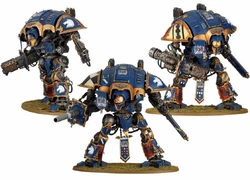
An Imperial Knight household spearhead of House Terryn
Since the dark days of the Horus Heresy, the Knight Worlds have continued to establish themselves as an important and loyal part of the Imperium.
Feared in battle, and almost unswayable once they have given their word, they are welcomed as powerful allies by Imperial commanders whenever their services are available.
It is only the relative scarcity of the surviving Knight Worlds, and the rigid, hidebound society they have developed, that limits the impact the Imperial Knights have on the galaxy.
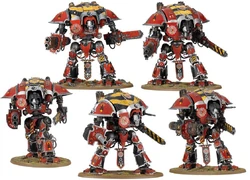
An Iron Brotherhood of House Raven
Daily life within the Knights' strongholds is bound by ancient traditions and rituals that can date back, unchanged, more than ten thousand standard years, and which the Imperial Knights feel themselves honour-bound to adhere to.
This immense awareness of tradition manifests itself in rituals that can dominate and suffocate all other aspects of life within the stronghold.
Days are almost wholly consumed tending to the obscure and esoteric tenets of tradition and with honouring household traditions or important ancestors from thousands of standard years ago.
For example, in House Hasburg, at the dawn of every day the entire court must gather to hear the reading of the names and deeds of every ruler of the house, dating back to its foundation millennia before; there are hundreds of names, and the process takes up most of the local day.
The only escape from the smothering ennui of courtly life lies in conflict; both the heroic challenge of the field of battle as an Imperial Knight, and the more ignoble but no less enthralling political contests that take place between the knightly houses.
The first of these is solely the preserve of the first or second sons of the aristocracy, for only they are allowed to pilot suits of Knight armour.
It is difficult to imagine the sheer freedom and sense of power that donning a suit of Knight armour brings to its wearer. At court, the Noble's every move and action is dictated by ancient traditions and rigid social rules; once the armour is donned, all that is forgotten; they are free to act as they see fit, unconstrained by anything but their own moral compass.
This being the case, it comes as no surprise that Imperial Knights fight with such ruthless and joyful ferocity, or that they are willing to endlessly practice the techniques of battle such that their prowess is only matched by the Adeptus Astartes.
When unable to justify wearing their armour for training or battle, Nobles organise contests between themselves to prove who is the bravest and most skilled, and in truth they are only truly content when arrayed for battle and piloting their armour.
However, there is also a darker side to the character of the Imperial Knights, one which drives another form of behaviour that allows for an escape from the traditions and rituals of courtly life. The same mental conditioning wrought through their neural link to their Thrones Mechanicum that imposes a strong respect for hierarchy and fealty upon the Nobles has the side-effect of making them endlessly ambitious.
In short, they are all compelled to outdo their peers and be acknowledged as the mightiest of all. In part, this drives the Nobles' obsession with contests of skill, but it also reveals itself in an equally intense obsession with political intrigue.
The courts of the knightly houses are riven with political factions, each trying to outdo the others in any way possible. These political intrigues are not the sole purview of the Nobles themselves.
All Nobles have a high-born consort, it being considered vital that the Noble has sons to inherit their name and titles, and daughters to marry as consorts to other knightly families in order to cement political alliances.
A Noble's consort can have considerable influence, and political intrigue offers them just about their only escape from the drudgery of courtly life.
Many a Noble has risen to high power thanks to the intelligence, cunning and ruthless ambition of his consort, while the Noble himself has found his pleasures on the field of battle.
The result is that plots and schemes abound among the highest ranks of a Knight World's society; often these will be inconsequential and only result in one faction or another gaining prestige over their rivals, but at times, such as when the ruler of a knightly house dies, they can become deadly serious.
It is not unknown for factions to come to blows, or even to arrange the assassination of a particularly hated opponent.
Most infamously, on the planet Patronis, a dispute about which rituals should be carried out when members of the different houses visited each other escalated into a centuries-long conflict that devastated the planet and eventually led to the demise of both houses.
Mottoes of the Questor Mechanicus Great Houses
For thousands of Terran years, loyalty and tradition have been ingrained into the rulers of the Knight Worlds via the mental manipulations of the Throne Mechanicum.
To this end, it is no surprise that many millennia later, honour, tradition and ceremony are paramount on such planets.
Every knightly household has distinct heraldry, history and rites, many of which are known to every citizen, from powerful barons to lowly worker-serfs.
Following are some of the mottoes of the best-known Great Houses aligned beneath the Adeptus Mechanicus.
- House Taranis - HONOUR THY FORGE, HONOUR THE PRIMUS ORDINUS.
- House Krast - CRUSH THE SERPENT.
- House Vulker - FOR THE GILDED GLORY OF THE OMNISSIAH.
- House Raven - HONOUR INVIOLATE, KOLOSSI ETERNAL!
- House Adamant - UNYIELDING, UNRELENTING.
- House Durbach - STRENGTH IN FAITH, STRENGTH IN STEEL.
Imperial Knights at War
Great Crusade and Horus Heresy Eras
Each Noble within a Knight house, referred to during the Great Crusade and Horus Heresy eras heraldically as a "Scion," is a warrior with their own Chronicle of Battle and the traditions and glories of their forebears to uphold.
Each house's bloodline ranges from the "Scions Aspirant," freshly raised up to command their armour in battle and wreathed in dreams of would-be glory, to the "Scions Martial," the experienced fighters who make up their house's line of battle, to the upper echelons of the house who hold the traditional ranks of the household's command and who have already writ their own legends in battle.
In times of open war, when a Knight house takes to the field en masse, each will have their own roles to play, roles founded as much in ancient tradition as in the individual record and reputation of the Knight armour and the warrior piloting it. Unleashed, such a tide of iron and fire is a force few powers in the galaxy can withstand.
Horus Heresy Era Questoris Familia Ranks
Headquarters Ranks
Seneschal
The martial traditions and aristocratic rule of the Knight households demand a rigid hierarchy in battle and at the apex of this order is the seneschal. Commonly, this august title is conferred on either the head of a particular household's mustered forces in the field or on the master of a particular fortified keep on the Knight Worlds themselves.
In both cases it is heavy not only with symbolic authority but also might, as to have attained such a rank, a Knight must have proved their worth both in personal combat and tactical command, as well as the more subtle but no less dangerous battlefield of political and dynastic struggle.
Lord Scion
The term "lord scion" here is used as a collective term that encompasses the upper echelons of a Questoris Knight Great Crusade force, be they in fact titled baron, margrave, siridar count, thane or one of a number of local sub-variations in peerage and rank, and ordered below the supreme authority of a seneschal on the battlefield.
They are each a war-tempered veteran whose position has not simply been bought with age and lineage, but with blood and fire upon the battlefield. A lord scion's mettle and record are known to all under their command, just as it is blazoned by the heraldry that adorns their Knight armour; an open challenge to any who would oppose them.
Elites Ranks
Preceptor
It is unusual, but not unknown, for a Scion to display a particular facility for technology, sometimes even serving time observing and learning from their household's Sacristans, although always retaining their distinction and rank.
These Scions, once they have become veterans of warfare in their own right, also make for the most able instructors of the household's aspirants, able to impart not only the lore of arms but also to teach a deeper understanding of the Knight armour, its scope of operations and the division of machine and man, earning themselves the honoured title of "preceptor" within the household.
The preceptor's lore can be put to use on the battlefield, allowing them to use advanced augury and auspex equipment which would be beyond those without their learning, and serve the role of tactical co-ordination and communications for their household in battle.
Aucteller
The aucteller is an archaic rank whose traditions flourished in ancient days when Knight houses battled bloodily for supremacy with one another. Though on many Knight Worlds feuds and affairs of honour were settled through highly ritualised and formalised duels, when the matter was pressed, either with bitter wrath or pure desperation of survival, mass battle was inevitable.
In such warfare the aucteller served not as a champion, but as a forlorn hope, oath-sworn to strike down the foe's greatest warriors at the cost of their own lives if needs be. In the age of the Great Crusade such desperate tactics were suppressed, but there were still houses that bore this bitter tradition well, and as the desperate wars of the Horus Heresy unfolded, the need for such sacrifices was born again.
Legendary Freeblade
Drawn out from the ranks of their former households, either willingly owing to the lure of adventure or the unquenchable lust for battle, or unwillingly as outcast, renegade or last survivor, Freeblades are Knights Mendicant, owing no alliance and no fealty to any house.
Of these, many were drawn to the Great Crusade, lured by the thirst for glory or the unceasing clamour of war on the frontier, joining the Questoris Crusade forces and fighting on countless worlds in support of the Emperor's great work.
Troop Ranks
Scion Martial
The Scions of the Knights Martial, also known in common parlance as the household's "banners," form the main strength of the Knights' battleline; experienced in warfare and expert in the use of the powerful war machines they command.
Scion Aspirant
The Knight households are not simply a military force but also hereditary bloodlines of war, a bloodline whose sons and daughters must be tempered in the fires of battle from a young age. Such an apprenticeship is a dangerous one, but vital to the sustenance of a household's strength across the generations.
Only the most desperate of battles would force a house to endanger all of its aspirants at once however, and so competition among the youth of fighting age to be picked to join their kin in the field is fierce.
Fast Attack Ranks
Scion Dolorous
A title bestowed upon the most famed beast-killers and slayers among the Knights of the house, the epithet "Dolorous," from the ancient tongue encoded into the great Long March colony arks which bore the the first Knights to their founding worlds during the Age of Technology, means "grievous" or "mournful" in its true form.
But within the society of the Knights it has since grown to have a double-edged meaning; of Scions who have proved themselves time and again against the mega-predators which populate many of the Knight Worlds, gaining for themselves a tally of trophies and kills worth the envy of their peers. It also implies one perhaps to whom battle and slaughter have become an addiction to the exclusion of all else, and for whom life beyond the confines of their Knight armour is a pale and hollow thing, and mortal danger their only wine and meat.
Such Knights often seek to be deployed in the forefront of battle and will often charge ahead irrespective of any orders to the contrary. While their actions in combat by some are judged to be little more than the madness of a death wish, the power of their battlelust is a devastating force in combat. Those who survive long enough after falling into the strange malady that afflicts the Scions Dolorous learn to temper their fury but not the restless desire for continuous battle, and many will become Freeblades, should they not fall in battle first.
Scion Uhlan
The Uhlan tradition is one followed by the most hot-blooded and impetuous Knights, both off and on the field of battle. In war they seek above all the glory of rapid victory and delight in high speed manoeuvre, destroying their foes in a fury of close-range fire and swift assault. Caution is to them an anathema and valour lies only in the close press of battle.
Within the Questoris Knight Crusade forces, the Scions Uhlan were used by the wiser house commanders as advanced scouts, raiders and reavers, either to form the front skirmish line of the household in the open field or as flanking forces to encircle a foe and run down an enemy once it breaks. As a result of their preferred tactics, many Scions Uhlan coveted the use of the less-common Cerastus Pattern Knights, owing to their superior battle speed.
Heavy Support Ranks
Scion Arbalester
An arbalester excels at dealing death and destruction at a distance, utilising their Knight's firepower to its fullest and most devastating effect. Skilled gunners, while some of their more impetuous or glory-hungry brethren may scorn their tactics as unworthy, they undertake a vital role in the household's battleline, identifying and destroying enemy heavy weapons emplacements to screen their comrades' advance and he!p shield their fellows from aerial attack.
Scion Implacable
An epithet applied to a household Knight who has shown a particular aptitude for siege warfare, an "implacable" is an invaluable warrior in such situations as heavy assault against fortified positions and a!so in the desperate maelstrom of cityscape warfare.
In situations such as these, a Knight armour, despite its power, might become undone if unexpectedly surrounded and swarmed by an enemy, but not so the Scion Implacable, who though they may be marked as far more cautious than their brethren in battle, is adept at crushing infantry like vermin.
41st Millennium Questoris Familia Ranks
Call to Battle
When battle calls, each knightly house rouses their great war machines. A lone Knight is a one-man army, more than capable of turning back a raiding xenos warband or a herd of rampaging beasts.
For larger threats, detachments or entire households of Knights march forth -- a sight as stirring and glorious for its allies to behold as it is terrifying for its foes.
When a high king of a Knight World calls for war, his knightly house and all others who owe him fealty are duty-bound to obey. Failure to honour such commitments brings great shame upon a house, a stain of infamy that will never be forgotten, either by the house itself, its peers, or its rivals.
However, such is the hold of duty and honour upon the Nobles that it is a rare day indeed when a Knight fails to answer a summons.
Beyond the defence of home and hearth, a high king can muster his detachments of Knights to take part in off-world campaigns.
This happens most frequently at the behest of the Imperium -- a call for aid from a Lord Commander of the Astra Militarum or a Space Marine Chapter Master -- but the least slight that besmirches a Knight's reputation is cause enough to mount a quest for vengeance.
The motive behind a War of Honour might be easily understood, such as hunting down a foe that invaded territory under the high king's protection.
However, so tightly wound is the Code Chivalric that governs the behaviour of Nobles, to the exasperation of the Departmento Munitorum, entire campaigns have been declared for perceived discourtesies such as the failure to address a baron with the proper title.
The exact number of Knights in a household detachment varies considerably. However, any Knight marching to war is accompanied by a full fanfare -- the blaring of trumpets and the cheering of the citizenry -- as the machine strides from its stronghold's gates.
This dazzling panoply increases exponentially for a baron, and even more should the high king and his full Exalted Court march out to battle.
Structure of a Questor Imperialis House

The standard organisation of a Questor Imperialis Knight house
At the head of every Knight house allied directly to the Imperium, the true "Questor Imperialis," is a high king. Directly beneath the high king in rank are his barons. Depending upon the size of the knightly house, there may be any number of additional barons, each a Noble lord in his own right, owning some stronghold or key territory of a Knight World.
All barons owe allegiance to their high king, but not all barons are politically equal. Although each Knight World maintains their own rituals and hierarchy, the highest-ranking barons are those the high king has selected to join his Exalted Court. These are the most loyal and war-experienced of his Nobles, and typically rule the largest swathes of territory.
The baronial rank of "kingsward" protects his liege on the field and at court. A pair of crossed swords signify the rank of kingsward.
Beneath each baron is their fiefdom -- the lands that owe them tribute. Those Nobles beneath them are their vassals and can be summoned to war at their call.
The Knights themselves fight individually or in formations usually called "lances." However, Knights may be summoned to war by their high king, his Exalted Court or an individual baron, and in most cases lances are made up of the vassal Knights of different barons, according to each member's individual talents, renown and determination.
Questor Mechanicus Knights at War
Through mutual oaths and unbreakable vows, the Adeptus Mechanicus have forged alliances with many Knight Worlds.
In return for technical aid and reciprocal protection, these houses of the "Questor Mechanicus," as they are now known, send forth their adamantine Knight suits to honour any request made by their allies.
Knightly houses closely aligned to the Adeptus Mechanicus are often called upon by the Priesthood of Mars to uphold their ancient pacts. Most often, the Tech-priests request military contingents from Knight Worlds to accompany the Titan Legions into battle.
The chosen Nobles are tasked with fighting directly in support of the Legion's larger Battle Titans or are asked to operate independently as scouts to protect the flanks of the slower-moving war machines.
The Adeptus Mechanicus also petitions for Knights to join Explorator fleets, for they add invaluable firepower to missions sent out to seize lost archeotech.
When a threat is deemed sufficient, Knights are also asked to help defend key planets -- especially endangered Forge Worlds or Quarry Worlds. In return for such military aid, the Knight Worlds receive greater technological resources.
To honour minor requests, a knightly house might send a single Knight, one of the honoured barons and an escort of his knightly vassals or perhaps a lance made up of Knights selected for the task in question. Occasionally, the Adeptus Mechanicus will decree that such seconded detachments must remain with a Titan Legion permanently; in these cases, the Nobles change their vows of allegiance and heraldry to reflect the Legio they now serve.
When a knightly house is faced with the most severe of threats, a princeps will march out in person with his Exalted Court, these heroes leading forth their entire household. These events are times of great fanfare, but given the increasingly hostile nature of the galaxy, such sights occur with ever greater frequency.
Structure of a Questor Mechanicus House
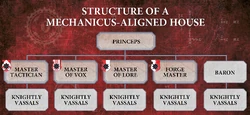
The standard organisation of a Questor Mechanicus Knight house
Those knightly houses aligned directly as vassals to the Adeptus Mechanicus, known as the Questor Mechanicus, are also feudal, and are organised in a manner similar to their Imperial cousins.
The ruler of the household is known as a "princeps," just like the commander of a Mechanicus Titan, and their decree is final. The rank below princeps is that of baron, and positions within this rank are still hierarchical, based on the individual barons' political influence and battle experience.
For their ruling council -- also called an "Exalted Court" -- the princeps will promote four barons. Known as "Barons Prime," these individuals are second in power only to the princeps themselves.
Each baron will have a number of vassals beneath them, and it is their duty to muster should they be called to battle. The number and exact organisation of these knightly vassals varies wildly from house to house, depending upon the size and power of the knightly house itself.
Regardless, when the summons to war is received, lances, groups of oathsworn Knights and entire household detachments will be drawn from the entire house's strength; only in unusual circumstances will the princeps, or one acting in his stead, choose to select only from a single baron's vassals.
To honour minor requests of the Mechanicus, a knightly house might send a single Knight, or perhaps a lance made up of Knights selected for the task in question.
Occasionally, the Adeptus Mechanicus will decree that such seconded detachments must remain with one of its Titan Legions permanently; in these cases, the Nobles change their vows of allegiance and heraldry to reflect the Legio they now serve.
When faced with a severe threat, a princeps of a Questor Mechanicus house will march out with their Exalted Court, these heroes leading forth their entire household.
These events are times of great fanfare, but given the increasingly hostile nature of the galaxy after the opening of the Great Rift, they occur with ever greater frequency.
41st Millennium Knight Ranks
Headquarters Ranks
High King
The high king, and more rarely "high queen" if female, is the ruler of a Questor Imperialis Knight house or Knight World in the case of those worlds with multiple Knight houses all owing fealty to a ruling house.
Princeps
The title given to the ruler of a Questor Mechanicus Knight house or Knight World.
Kingsward
The title given to the veteran Noble who serves as the high king's or princeps' primary protector, most trusted advisor and body guard. The kingsward is expected to give their own life if necessary to protect that of their lord, and often commands a larger force of elite Knights that serve as the house ruler's Exalted Court.
Baron
A lord in their own right, all barons owe allegiance to their high king or princeps, but not all barons are equal, as positions within this rank are still hierarchical, based on the individual barons' influence and battle experience.
The most experienced barons in an Imperial-aligned knightly house make up a high king's Exalted Court.
The barons of a Mechanicus-aligned knightly house are known as "Barons Prime," second only in power to the princeps themselves.
Elites Ranks
Knight Warlord
When fielding an army where the primary detachment is made up of Imperial Knights, one Knight is nominated as the Knight Warlord. A Knight Warlord always also holds the more archaic rank of seneschal.
Seneschal
Some veteran Knights who prove themselves worthy in the fires of battle, either through countless martial triumphs or by one truly heroic act, are awarded the rank of seneschal, and are paragons of their house who often command its forces in battle as the Knight Warlord.
Troop Ranks
Knight
These are the Noble warriors who have proven themselves in battle, and form the bulk of each knightly house's household detachments. The ranks of the Knights include many types of warriors, from the freshly blooded hotheaded youngling to the solid veteran experienced with dozens of engagements; but all will proudly and steadfastly represent their house at war.
Knight Apparent
After undergoing the Ritual of Becoming, in itself a praiseworthy feat, a young Knight pilot begins their career as a Knight Apparent. They will retain this title until they have been blooded in their first full-scale battle, after which the supplemental title of "Apparent" is dropped and they are accepted by their peers as a full-fledged Imperial Knight.
Knight Formations
Exalted Court
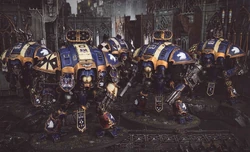
Exalted Court of House Terryn
The "Exalted Court" is nothing less than the ruler of the knightly house and their hand-selected entourage of officers and top-ranking Nobles. Beyond doubt, this is the most powerful formation a house can field, representing the pinnacle of its leadership and martial prowess.
When the Exalted Court marches out to war, it does so with full fanfare -- trumpets blare and the ground shakes. Striding forth in the full panoply of war, the Knights of the Exalted Court have power enough to level cities or smash entire armies to ruin.
The titles of each member in the Exalted Court vary between Adeptus Mechanicus- and Imperium-aligned houses, and the hierarchy and subsidiary roles of each position are different for every knightly house.
However, one fact remains the same -- when the Exalted Court takes to the battlefield, they carry with them the full pride and might of their house.
Baronial Court
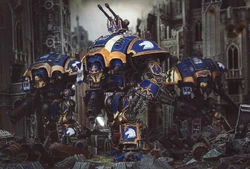
Baronial Court of House Terryn
A Baronial Court is an army-crushing formation that crosses battlefields like an adamantine avalanche, a ground-churning charge of near-titanic proportions.
On their own initiative, or at the summons of their high king or princeps, a baron will muster a bodyguard from those household Knights who are pledged to aid their fief.
This formation is classified as a Baronial Court, although some knightly houses refer to it as a "Baronial Escort" or "Cavalier Spearhead."
Forming a nigh-impenetrable ionic shieldwall, the Knights march abreast, closing with the foe while their own massed firepower rains down death.
Here strides the unbridled power of the Knights, a force that has defeated Humanity's enemies since before the birth of the Imperium.
Tripartite Lance
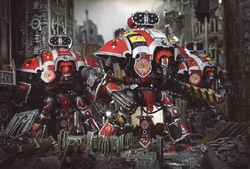
Tripartite Lance of House Raven
The Tripartite Lance formation was developed by the Adeptus Mechanicus-aligned House Vulker, and later adopted by all other houses.
This formation consists of three Knights -- one each of the Warden, Gallant, and Crusader classes -- fighting together as one.
Co-ordinating these huge machines to fight as a single unit, however, requires not only relentless combat drills, but an ability to predict the actions of the other Knights that borders on prescience.
Through their Thrones Mechanicum, each towering Knight anticipates the movement of its lance-mates, triangulating their firepower and close combat actions as a single unit.
Thanks to their thrones' bond, the Knights of the lance also move with a grace and ease of motion that belie their massive size and crushing weight, allowing the adamantine giants to work in close formation.
Fighting thus, the whole is greater than the sum of its parts, as many foes have found out to their cost.
Gallant Lance
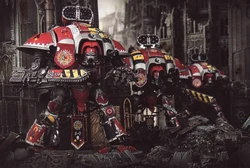
Gallant Lance of House Raven
With more momentum than a runaway mag-train, a Gallant Lance hits with such ground-shaking impact that shockwaves can be felt kilometres away.
Even a Battle Titan must fear such a collision, for each of the three Knights Gallant that make up the Gallant Lance formation is, in its own right, a formidable killing machine.
Given enough time, such a tsunami of hurtling adamantine armour, swinging reaper blades and lightning-wreathed Thunderstrike Gauntlets could completely stave in an Imperial Navy battleship.
Gallant Lances charging full tilt have even been known to crack open the reinforced ferrocrete walls of traitorous hive cities -- once within, their murderous prowess is such that the previously confident foe will flee their stronghold rather than face the Knights in combat.
Skyreaper Lance
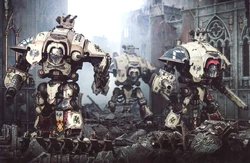
Skyreaper Lance of House Griffith
When Sacristans fit a twin-linked Icarus Autocannon atop a Knight's carapace they give that enormous walker the ability to command the sky, bringing down winged creatures or turning swooping aircraft into hurtling fireballs that spin crazily into the ground.
When a formation of three Imperial Knights so armed work in concert they can crisscross the sky with stitched patterns of tracer fire, casting a deadly net of anti-air fire into the heavens.
Known as a "Skyreaper Lance," such a formation can bring down entire flying squadrons, making it rain with exploded aircraft parts or the bloody chunks of flying beasts.
It is always possible to tell where a Skyreaper Lance was stationed on a battlefield, for the surrounding ground is littered with furrowed wrecks and spattered gore.
Honorifics and Titles
Although all Knight Worlds have similar feudal societies, local factors and other external influences meant that the exact nature of these emergent cultures varied somewhat between worlds.
Nowhere is this more evident than in the names utilised by the knightly houses for their ranks, battle formations and even their strongholds. The ruler of House Griffith, for example, bears the rather pretentious honorific of "grand master of the lance."
None, however, would dare claim that Griffith's current ruler, Grand Master Bryce, does not merit such a grandiose title, for his skill in battle is legend across the galaxy.
Similarly, by long tradition the Nobles of House Skandos are known as "jarls," and their household detachments as"jarlhosts," while the largest stronghold of all the Knight Worlds is that of House Raven, which is known as the Keep Inviolate.
This titanic edifice is large enough to accommodate each and every one of the many hundreds of Knight suits belonging to the Nobles of House Raven and is one of the mightiest fortifications in the Imperium.
Oaths of Allegiance
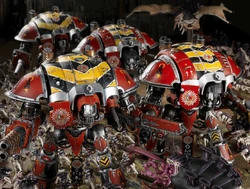
An Iron Brotherhood of House Raven Knight Errants hold the line against the horrors of the Tyranids.
When Mankind rediscovered the feudal domains of the Knight houses, they quickly found common cause, exchanging oaths of loyalty.
The knightly houses found on each of the Knight Worlds are affiliated with either the Imperium generally or serve as direct vassals of the Adeptus Mechanicus.
The Knight Worlds of the Questor Imperialis are expected to adhere to the Imperial Tithe as does any other planet, but still trade with the Adeptus Mechanicus to keep their Knight suits operational.
Many Knight houses see the Imperium as their equal partner, and support it militarily out of mutual advantage. Although these houses trade openly with the Imperium, and march to war alongside their armies, they retain a fierce independence.
Other houses found common cause specifically with the ancient Mechanicum, who in turn courted the Knight houses with unseemly eagerness. These Questor Mechanicus houses, as they are now known, have forged alliances of reciprocal protection and betterment.
The Knight Worlds of the Questor Mechanicus are often found near to the parent Forge World with which they are associated. This is no mere coincidence, for many of these Forge Worlds were specifically founded near to Knight Worlds in order to harvest their natural resources.
The Titan Legions that set forth from these Forge Worlds to battle the enemies of Mankind often do so in the company of their allies from the Knight Worlds.
A partnership between both Forge and Knight World is mutually advantageous to both factions, as their combined military strength is great enough to shatter cities and conquer worlds.
Those who look at the fealty of the knightly houses towards the Adeptus Mechanicus often wonder at whether the relationship is not in fact based on jealousy, for the tech-priests of Mars covet the pre-Imperial technology that lies within the mighty citadels of each Knight house.
For their part, the Questor Mechanicus houses seem not to care, since they receive the full resources of the affiliated Forge Worlds from their allies.
While the overwhelming majority of Imperial Knights belong to houses (such as Houses Terryn, Hawkshroud and Cadmus) who are aligned to the Imperium, some houses (such as Taranis and Raven) are sworn to the service of the Adeptus Mechanicus.
Each house has its own proud traditions that span thousands of standard years, and will have fought in countless battles on behalf of Humanity.
Freeblade Knights
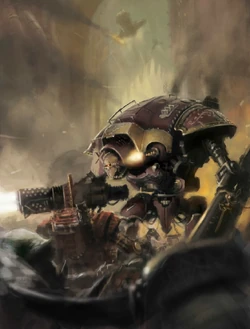
Some Knights, for one reason or another, forsake the succour of a Noble house. These Knights owe no allegiance to any house, and forge their own destiny as "Freeblade Knights" or "Freeblades."
The ancient tradition of the Freeblade harkens back over ten standard millennia ago, during the Great Crusade and Horus Heresy eras.
Known as "Legendary Freeblades," these were Scions of that time who were drawn out from the ranks of their former households, either willingly owing to the lure of adventure or the unquenchable lust for battle, or unwillingly as outcast, renegade or last survivor.

The Freeblade known as the Obsidian Knight fights against the forces of the T'au Empire.
These Freeblades were Knights Mendicant, owing no alliance and no fealty. Of these, many were drawn to the Great Crusade, lured by the thirst for glory or the unceasing clamour of war on the frontier, joining the Questoris Knight Great Crusade forces and fighting on countless worlds in support of the Emperor's great work.
Since that bygone era, the tradition has continued to be upheld by the knightly houses of the Questoris Familia.
Ancient tradition ensures that every Noble pilot has the right to leave their knightly house and strike out on their own. These Freeblade Knights are tragic heroes, driven to leave their houses to pursue a cause of their own, continuing to fight for Mankind, but call no man master.
The reasons that a Knight becomes a Freeblade are many and varied. In some cases, they simply cannot bear the idea of returning to the crushing rituals of the court, and instead set off alone, rarely removing their suits of armour and living only for battle.
Other Freeblade Knights have made a personal oath or pact to carry out a certain task that requires they travel across the galaxy in order to fulfil it.
Most commonly, though, a Freeblade Knight is simply the last surviving member of their house, left without a liege lord and with no option but to travel across the galaxy until they find a new master or die in the attempt.
In all these cases, and many more, a Freeblade Knight is no longer a member of the house they once belonged to. If they are the last surviving member of the house, they may retain their former heraldry as a mark of respect, but usually a Freeblade will change the colour of their armour and the markings upon it and take on a new name to mark the change in their status.
The names of some Freeblades, such as the Knight of Dark Shadows, who fought in the Reign of Blood, and Retribution Incarnate, who travelled alongside the Lord Commander Solar Macharius during his conquests, are revered as dedicated warriors that would never admit defeat, no matter what odds were arrayed against them.
Freeblades either set out on their own, wandering the stars in search of a worthy cause, or else they settle in further isolation, offering their protection to those who need it.
They tend to travel alone, or with a small group of retainers and Sacristans, but sometimes circumstances will result in small groups of Freeblades banding together, fighting in much the same manner as a household detachment, but with a bond forged in battle rather than inherited through blood.
Not belonging to a Knight house does nothing to reduce the effect of a Freeblade's psychological conditioning. Freeblade Knights still place great significance on acts of honour and duty, perhaps even more so than before.
Once they have given their word or set their mind on a task, they will follow it through, come what may, even at the cost of their own lives. They also feel it is their responsibility to protect those that are unable to protect themselves, and to punish those that prey on the weak.
They carry out such tasks with a brutal efficiency, leaving only death in their wake and then moving on. This has meant that the Freeblade Knights have gained an almost legendary reputation amongst the ordinary citizens of the Imperium.
Such glory, however, means nothing to these lonely, battle-hardened warriors. They are not interested in either praise or reward from those they defend, and their only comforts are found in their long, endless journey and the hot adrenaline rush of battle.
Knight Armour

The six major classes of Knight deployed by the Imperium of Man in the late 41st Millennium -- the Knight Preceptor, Knight Warden, Knight Gallant, Knight Crusader, Knight Errant and Knight Paladin.
The war machines utilised by the Imperial Knights were orginally built with the intention of helping with the work of Human interstellar colonisation.
That inherent practicality was communicated in many of the aspects of their current design. For example, the Reaper Chainsword, considered such a fearsome weapon on the battlefield, was clearly once intended for clearing huge areas of vegetation for the early settlers.
Each of the weapons has heavy-duty lifting hooks attached to it, and one can imagine the original practical colonists hooking up digging or lifting apparatus just as easily as they could remove a powerful Battle Cannon out of stores to fend off marauding Orks or Aeldari.
Many of the practical elements of the original endoskeleton of the Knights' war machines are now hidden under the sloped armour plates and heraldry of the Imperial Knight.
If one were able to penetrate beneath the heavy layers of thick protective armour plates, the war machine would resemble the functional STC construction machines of the past when the colonists first used them to defend their early settlements.
Knight armour comes in a wide variety of forms, each with their own strengths and weaknesses. Their are three broader classes of Knights, ranging from lightest and smallest to largest and heaviest. These include the Armiger Pattern Knights, Questoris Pattern Knights and Dominus Pattern Knights.
The two most commonly seen classes within these patterns are both Questoris Knights, including the Knight Paladin and the Knight Errant. These both use the same basic body form, but are fitted with different weapon arrays. Each is well-liked for its balanced and deadly combination of manoeuvrability, protection and firepower.
All Imperial Knights are protected by thick adamantium armour and are fitted with powerful weapon systems. Usually, this entails two primary weapons, one attached to each of its "arms", which will be supplemented by a number of secondary weapon systems fitted to its torso and shoulders.
The hand-forged armour that protects each Knight was crafted long ago, and elements such as the individual armour plates, helm or crests can therefore vary considerably depending on the skill of the artisan who made them.
The armour is often lavishly detailed and adorned with complex heraldry that reveals the Knight's allegiances and the deeds he has accomplished in battle.
Notable Knight Patterns
- Knight Paladin - The Knight Paladin is the archetypal Imperial Knight combat walker, usually armed with a large calibre Rapid-Fire Battle Cannon and a giant Knight-sized Reaper Chainsword. For long-ranged devastation, there are few weapons that can match or best the Knight Paladin's battle cannon. This massive barrelled weapon is equally adept at blasting apart massed hordes of enemy infantry, gunning down entire squadrons of light vehicles, or duelling a foe's artillery at long range. The Battle Cannon is even capable of piercing even a true Titan's armour. Incoming firepower is blunted as the pilot shifts the directional ion shield towards the approaching shots. With its long strides, the Knight Paladin can reposition quickly, firing as it manoeuvres to give maximum fire support. Should enemies approach too closely, a pair of Heavy Stubbers can mow them down. In close combat, the Reaper Chainsword or Thunderstrike Gauntlet the Knight Paladin carries makes it virtually unstoppable, able to disregard any enemy armour with impunity. The Reaper Chainswords used by Knight Paladins are described as being easily as destructive as the close combat weapons used by the larger Warhound-class Scout Titans, capable of harming even an Imperator's armour plating.
- Knight Errant - The Knight Errant is based on the same body as the Knight Paladin, but serves a more specialised purpose. The Errant class Knight can charge and destroy a tank battalion, for it is a colossal ionshield-protected war machine capable of immense close-ranged destruction. The main armament of the Knight Errant is the Thermal Cannon, a weapon whose blasts can immolate plasteel bunkers or turn a battle tank into molten slag. Armed with this potent weapon, it is highly suited to attacking large targets such as Chaos Titans and even Mega-Gargants, vaporising steel and flesh with equal ease. The Knight Errant's close combat weapon -- either a Reaper Chainsword or Thunderstrike Gauntlet -- is perhaps more deadly still. When powered by the Knight's mighty servo-engines, either of these weapons can topple even the most monstrous xenos creature with a single strike. Fitted into the Knight Errant's armoured carapace is a Heavy Stubber to scythe down enemy infantry, and its armour-plated feet are more than capable of crushing units beneath its awesome weight.
- Knight Gallant - The Nobles that pilot Knights Gallant are aggressive and short-tempered, their minds constantly occupied with proving themselves in glorious combat. Armed with a Thunderstrike Gauntlet and Reaper Chainsword, they eschew the use of long-ranged cannons in favour of wargear that can pummel, shred and tear their foes apart in combat. Difficult to restrain with tactics and logic, they will often spearhead an assault in search of renown. An Ion Shield and thick armour help ensure the bipedal colossus reaches its target, while a Heavy Stubber enables the Knight to scythe down any counter-attacking infantry.
- Knight Preceptor - The Knight Preceptor is a Questoris-class close-ranged powerhouse. Its design is intended to exemplify the core tenets of the Code Chivalric in battle: close with the enemy to an honourable range, engage them with sufficient force to show respect for their fortitude, and kill them quickly and cleanly in the Emperor’s name. To this end, the Knight Preceptor is armed with a roaring Reaper Chainsword or crackling Thunderstrike Gauntlet, and the rare and terrifying laser cannon known as the Las-Impulsor. These weapons are best wielded at such close quarters that a Noble can look their enemy in the eye even as they slay them. The las-impulsor is a ferociously powerful gun that, while comparatively short ranged for such sizeable ordnance, is more than capable of bringing a heretic fortress down in ruins or scything the leg from under an enemy Titan with a single concentrated salvo.
- Knight Crusader - The Knight Crusader pattern armour carries more firepower than a tank squadron. In stark contrast to the bellicose pilots of the Knights Gallant, those Nobles given the honour of commander a Knight Crusader are thoughtful, tactically-aware warriors. Armed with enough guns to quell a rebellion, they stride at the rear of a Knight lance, laying down a hail of bullets and battle cannon shells in support of the advance. Continued fire from a Crusader can reduce entire formations to steaming gore and ruined metal in minutes. In total, the Imperial Knight Crusader carries four ranged weapons: the Thermal Cannon the Avenger Gatling Cannon, a Heavy Stubber and Heavy Flamer. Alternatively, they can have as many as six weapons mounted upon it.
- Knight Castellan - The Knight Castellan is a super-heavy Imperial Knight that makes use of the Dominus-class chassis. It is used primarily as a long-range artillery platform and is capable of striking the enemy from extreme range. Although slower than other Knights, this pattern benefits from substantially increased firepower and much thicker armour than its smaller counterparts. The Knight Castellan is one of the two most commonly deployed patterns of the super-heavy Dominus-class chassis, the other being the Knight Valiant. With its dual plasma core sending energy surging through its huge frame, the Castellan can mount a frightening array of weapons systems while maintaining its Ion Shield against incoming fire. The arsenal of the Knight Castellan is legendary. On one arm they carry a Plasma Decimator, a huge and obliterative Knight-grade Plasma Weapon capable of bathing swathes of the battlefield in searing energies and reducing the enemy to glowing ashes. The Castellan's other armament is the Volcano Lance. Possessing massive range and stopping power, this massive laser cannon is the bane of super-heavy war engines and beasts. It can core out a lumbering Squiggoth or behead an enemy Titan, and when several Knights Castellan open fire at once, the effect is commensurate with the lance batteries of an Imperial Navy warship. Upon the Castellan's broad shoulders are mounted twin Siegebreaker Cannons and Shieldbreaker Missile Racks. The former are unsubtle gun turrets, fired by Servitor-brain sub-arrays slaved to the pilot's targeting systems. They are capable of laying down a pounding bombardment of heavy ordnance to entirely carpet an area in flame and shrapnel. Shieldbreaker Missiles, meanwhile, are an ancient variant of the redoubtable Hunter-Killer Missile. These warheads incorporate Raptoris Machine Spirits (artificial intelligences) and empyric cascade micro-generators that allow them to disrupt and pass through enemy shields by skipping like hurled stones across the skin of reality, dipping minutely in and out of the Warp in micro-second flickers. They are employed to punish those dishonourable enemies who cower behind veils of arcane energy or the massed ranks of lesser warriors. After all, as the pilots of the Knights Castellan are fond of saying, there is no escape from the Emperor's wrath.
- Knight Valiant - The Knight Valiant is a super-heavy Imperial Knight that makes use of the Dominus-class chassis. It employs the simple principle of applying overwhelming firepower at close proximity. Marching relentlessly into the fight, gunfire scattering uselessly from its ion shield, the Valiant unleashes such devastating punishment against its targets in so short a space of time that they can neither fight back nor endure. Even a single Knight Valiant can break the back of an onrushing enemy horde, or shatter the centre of the foe's battle line like a battering ram smashing through a castle gate. When an entire lance of these fearsome war engines strides into battle, they can snap apart an enemy army like matchwood. The Knight Valiant's primary armament is the Conflagration Cannon, a magnificently unsubtle weapon, comprising three enormous Flamers linked together and fed from armoured Promethium reservoirs. When triggered, the conflagration cannon spews forth an inescapable firestorm that washes over everything in range and reduces all to blakened ash. Its other primary armament is the Thundercoil Harpoon. A rather unusual weapon, it is comprised of a huge spear of Adamantium fitted with pneumatic grapnels and attached by thick chains to an electrothaumic generator, allowing it to be fired then reeled back in time and again. Not only does it impal mass gouge massive wounds in larger targets while crushing smaller victims outright, the Valiant's Noble pilot can send a massive electrical charge through the chain, cooking monstrous beasts from the inside and overloading the circuitry and power supplies of war engines. Combined with the pummelling fire of its Siegebreaker Cannons and the inescapable detonations of its Shieldbreaker Missiles, it is not hard to see how many enemy forces soon disintegrate when the Valiant turns its wrath upon them.
- Knight Armiger - A Knight Armiger, also known as an Armiger Pattern Knight, is a small Imperial Knight combat walker usually piloted by Nobles who are of lesser lineage than other Knights. Armigers are long-legged walkers designed to strike hard and fast at critical targets. Nimbler than the primary Imperial Knight patterns, these engines of war carry heavy weaponry powerful enough to break a battle line. The Armiger Warglaive in particular is known for the sheer punch it can bring to bear at close quarters. Sprinting into the fray at a shocking pace, it levels a lance-like beam of superheated directed energy from its Thermal Spear that can reduce a rockcrete bunker wall to a pool of bubbling lava. Those met by the ensuring charge are struck with an expert sweep of the Armiger's Reaper Chain-cleaver, a saw-toothed weapon that mangles metal and gnaws flesh to ruin with each shuddering impact. The Warglaives' counterpart, the Armiger Helverin, is a fast-moving weapons platform designed to lay down blistering hails of heavy weapons fire while running rings around the enemy's forces. In place of the close-ranged armaments of the Warglaive, each Helverin bears a pair of Armiger Autocannons. Capable of firing hundreds of armour piercing shells per minute, even a single such weapon can swiftly whittle down infantry ranks or shred lightly armoured vehicles. With Helverings mounting two of these formidable weapons each, and hunting in packs up to three Knights strong, their withering fusillades can rapidly break an army's flank or blunt the foe's assault well before it can hit home. Many Helverins favour Heavy Stubbers for their simple application. However, other Bondsmen will choose - or have their betters choose for them - to mount carapace Meltaguns on their Helverins, thus providing them with short-range punch should the enemy's armour or elite infantry move in too close. The lesser orders of Imperial Knight, the fast-striding Armigers among them, are often piloted by the distant relatives or faithful retainers and men-at-arms of the Nobles seated within the larger Knights that lead them to war. There is a deep-running loyalty between each host of titanic walkers, a bond of love and duty that even disaster cannot diminish.
Note: The next pattern of Knight, the Knight Warden, originally only appeared in a single source containing information that had been rendered partially obsolete. But recently, it has been reintroduced by Games Workshop. See the Canon Conflict section for more information.
- Knight Warden - The Knight Warden excels at storming strongholds and battles in claustrophobic confines. Undaunted in the face of enemy fire, they often mastermind attacks on enemy barricades and bunkers. With its ion shield to the fore, the Knight Warden can close upon a foe quickly, its immense stride simply bypassing tank barricades and easily manoeuvring through narrow hive city streets or amidst the twisted boughs of alien forests. On one arm they carry an Avenger Gatling Cannon; on the other a Reaper Chainsword or Thunderstrike Gauntlet, both more than capable of ripping a tank, monstrous alien creature or armoured fortification to pieces. The Knight Warden can be further equipped with a shoulder-mounted Meltagun and carapace-mounted support weapon. Should the Warden expect to encounter enemy tanks, the Stormspear Rocket Pod is the ideal solution, while the Icarus Autocannons are perfect for dealing with aircraft. The Avenger Gatling Cannon hisses as it whirs, spitting out a wall of shots -- a high volume of large calibre shells that can tear apart armour and mow down squads of infantry. A Heavy Stubber adds to the firepower while a Heavy Flamer built into the main gun's shield ensures that even foes in cover cannot escape the Knight Warden's wrath. When it reaches its destination, the mighty close combat weapon in its other arm can rip apart or crush any enemy foolish enough to have stood before its oncoming doom.
Cerastus Type Knight Armours
Cerastus type Knight armours are highly sophisticated chassis whose speed and agility far exceed the clumsier Errant and Paladin types.
The Cerastus type Knights appear to have been designed solely for war, not as protectors but as bloody-handed conquerors and tools of destruction, a legacy of the violence that marked the beginning of the Age of Strife.
Below is a selection of the most common types of Cerastus Pattern Knight armours fielded by the Knight houses:
- Cerastus Knight-Acheron - The devastation wrought by a Cerastus Knight-Acheron is terrifying to behold. Armed with a fearsome Reaper Chainfist, twin-linked Heavy Bolters and an Acheron Pattern Flame Cannon, it is employed as a weapon of extermination and to inspire fear in the Imperium's foes. Nothing will sway its attack until the enemy is utterly crushed, never to rise again from the flame-scoured ruins of their strongholds.
- Cerastus Knight-Atrapos - One of the rarest and most potent Knights, the Knight-Atrapos is a unique variant type of the Cerastus pattern. Bearing particularly rare and potent weaponry of annihilation, the Cerastus Knight-Atrapos was created solely to destroy heretek engines and xenos war machines whose very nature and existence were considered a blasphemy to the Omnissiah. The machine spirits of the Knight-Atrapos are said to carry with them a cold and all-destroying hunger, and for the scion who bonds with them, madness is a constant risk. But for such storied honour, however dark the outcome, this may be a price worth paying. The Cerastus Knight-Atrapos carries arcane and devastating weapons into battle; the focussed and deadly Atrapos lascutter, that sees duty as both a ranged and close combat weapon, and the violently destructive, but potentially unstable, graviton singularity cannon. With the speed and shielding of the Cerastus chassis, and the Knight-Atrapos' Marco-extinction Targeting Protocols, the Cerastus Knight-Atrapos is an uncommonly destructive weapon of war.
- Cerastus Knight-Castigator - Armed with the fearsome Castigator Pattern Bolt Cannon, the Cerastus Knight-Castigator is favoured by those Knight houses faced with hordes of lesser foes that might otherwise overwhelm even a mighty Knight through sheer numbers. Capable of obliterating infantry formations in a thunderous rain of mass-reactive explosions and whirling power blade, or carving apart light vehicles with ease, the Castigator is a formidable opponent.
- Cerastus Knight-Lancer - One of the more uncommon but also most highly valued Knight-class walkers fielded by the Knight houses, the Cerastus Knight-Lancer is a first strike weapon, attuned to rapid assault tactics and lethal outflanking charges against a foe. It is justly renowned for its speed and its power, as well as for the temperamental and restive nature of the Machine Spirits (artificial intelligences) which dwell as anima within its colossal frame. Because of this reputation, the most impetuous and glory-hungry of the Knight households are driven to bond with these war machines, their own souls a match for the fury caged within their mounts. The greatest of these pairings will go on to create martial legends among their lineage. This Knight-Lancer has a Cerastus Shock Lance mounted as its primary weapon -- a magneto-hydraulic power spear of prodigious size, whose disruption field may also be projected as a powerful electromagnetic plasma blast over short ranges. An Ion Gauntlet Shield generator is mounted in the Cerastus' right gauntlet assembly and is more concentrated than the directional Ion Shield mounted on the Knight Paladin class, but lacks its tactical flexibility.
Rare Knight Armours
- Questoris Knight Magaera - The Questoris Knight Magaera is a type of Knight that is most often used as a shock assault unit, breaching the most heavily defended enemy positions, while shrugging off heavy weapons fire and self-repairing even devastating weapon strikes in a few minutes. To aid in this role it is armed with a complex Lightning Cannon, using focussed electromagnetic beams to vaporise infantry and blast apart armour.
- Questoris Knight Styrix - Housing Machine Spirits which some say became too accustomed to wholesale slaughter during the Age of Strife and the Great Crusade that followed it, many of the more conservative houses consider the Questoris Knight Styrix to be a dark and malevolent pattern of armour, the wanton slaughter it unleashes being beneath a true Knight. Other households hold no such reservations however, and often loose entire formations of Styrix Knights to mercilessly annihilate their foes. Armed with a devastating Volkite Chieorovile and backed up with a Graviton Gun and twin-linked Rad Cleanser, the Questoris Knight Styrix is easily able to eliminate large numbers of infantry at range. In close combat, its immensely powerful Hekaton Siege Claw can smash vehicles and tear buildings asunder with ease, making the Knight a powerful addition to any army.
- Acastus Knight Porphyrion - One of the most heavily armed and armoured of all Knight chassis in service with the Imperium's forces, few Knight households are able to muster Porphyrion armours, which are seen as symbols of favour by the lords of the Omnissiah's cult, and even the greatest households such as House Raven or House Vymar do not claim more than a handful each as part of their arsenals. The Porphyrion serves not only as one of the most powerful war machines of its kind, but also often as the supreme enforcer of the rule and dominion of a Knight household over its own Scions, many carrying the unique heraldic symbol of the shrouded urn; a dread charge given only to a Knight which has destroyed one of its own brothers in sacred and sanctioned trial by combat over some great issue of honour or malfeasance. There are those within the ranks of the Scions and Seneschals of the Knight households however, who do not agree with the otherwise universal regard in which these rare armours are held. For some of its bulk, and the selection of a purely ranged armament -- no matter its magnitude -- is a drawback as it undermines the armour's adaptability and prevents it from indulging in the glories of hand-to-hand combat, while others stress the size and power of the Porphyrion, which rivals that of a Scout Titan. This Knight represents the outer limits of what a single Human mind can interface with, creating phenomenal strain upon even the strongest willed Scion pilot.
- Acastus Knight Asterius - The Acastus Knight Asterius was a massive, super-heavy pattern of Imperial Knight deployed during the Great Crusade and Horus Heresy eras. This pattern of Knight was specialised for long-range firepower and destroying fortifications. Of the gigantic Acastus Pattern Knights, some of the largest such war machines still in existence, the Asterius is among the most rare. Like its more common cousin, the Acastus Knight Porphyrion, it boasts an armoured hide near impervious to weapons fire, striding across the battlefield like an angry giant beset by insects, and also wields a pair of twin ancient Conversion Beam Cannons. These weapons are irreplaceable relics of a lost technology, each capable of sundering the walls of mighty fortresses and laying low powerful foes in a single blast. The Asterius is even more immense than most other Knight classes, standing almost as tall as a Scout Titan. Its bulky frame was home to an impressive array of long-ranged firepower, which allowed it to lay waste to the Emperor's enemies from afar.
Obsolete Knight Armour Types
Note: The following patterns of Knight -- the Knight Baron, Knight Castellan and Knight Lancer -- are no longer considered canon, but have been included below for completeness.
- Knight Baron - The Knight Baron is piloted by a superior warrior with razor-sharp combat and Knight-handling skills. A Baron Knight usually leads a Knight squadron into battle. As a sign of their command and societal status, every Baron uses a Knight custom-built to their exact specifications. This Knight pattern's armour plating is thick and resilient, and heavily decorated with house symbols and fluttering pennants in the colours of the Baron's estates. A Knight Baron is usually armed with a Battle Cannon and the destructive Power Lance, usually only found on Knight Lancers -- which also means that despite its exceptional sturdiness, the Knight Baron's armour is light enough to allow the machine to move fast enough to generate the charge necessary to operate the weapon, and to keep up with the charging Knight Lancers. In battle, the Knight Baron leads the assaults of his kinsmen, crashing through enemy lines like a bolt of lightning with his followers hacking into the foe around him with redoubled pride and fervour.
- Knight Lancer - The Knight Lancer is a variant of the standard Knight suit that has been designed for speed and agility. The Knight Lancer is most usually used to perform scouting actions, outflank enemy forces and distract them while heavier units can position themselves to attack. The Knight Lancer is equipped with a Battle Cannon to give it long range fighting capability, but its true armament is the Power Lance. The Power Lance is a relatively simple upgrade to the standard Shock Lance that is mounted on other Knight patterns. It operates by intensifying the bolt of energy normally expelled from Shock Lances, changing it into a searing arc of lightning capable of rending all but the strongest of armour plating and causing havoc in enemy ranks. The Power Lance has a very short range, but its nature makes it the perfect weapon for hit-and-run attacks.
Knight Control and the Ritual of Becoming
"I will uphold the honour of my house, our brotherhood gives me strength. I will show no mercy to my foes, none shall withstand my fury. I will defend the sanctity of Sacred Mountain, no enemy shall tread Alaric Prime unpunished. I will never forsake my oath, only in death does duty end."
- — House Degallio's Oath of Becoming
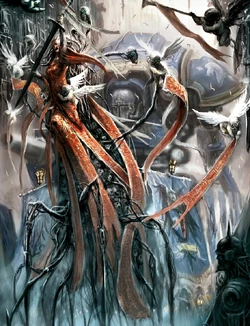
A Knight Paladin of House Terryn being attended upon within their House's Sanctuary.
Suits of Knight armour are similar to Titans, in that they are controlled through neural interface sockets surgically inserted into the Noble pilot's cerebrum and cerebellum.
The pilot sits in a control platform called a Throne Mechanicum, where umbilical interface cords are attached to their neural sockets. The Throne Mechanicum is then, in turn, plugged into the suit of Knight armour, allowing the Noble to control its movements as if it were part of their own body and to receive sensory feedback from the suit so that they can see what it sees, and feel what it feels. This interface allows an Imperial Knight to move with a fluid grace that can only be matched by the war machines of the Craftworld Aeldari.
Additionally, every Knight possesses manual controls, which include dials and switches, a throttle lever for the right hand, and a fire-control stick for the left. If the Knight makes use of a melee weapon, its control stick lies just ahead and to the right of the throttle. These controls exist mostly for the use of the Knights' Sacristans and are intended to allow these technicians to position the suit in maintenance bays, run simulations or to move it over short distances. The reality is that these manual controls allow for only rudimentary and clumsy movements and as such are far inferior to the use of the Throne Mechanicum.
However, if a Noble was ever rendered "thought-dead" -- a term for the termination of the mental connection between the Noble and their Knight's Throne Mechanicum -- they could rely in such an emergency on their manual controls. While their Knight would become slow and stilted, more like an Astra Militarum Sentinel walker than a true fusion of Human consciousness and archeotech, manual control might be enough to save the pilot's life.
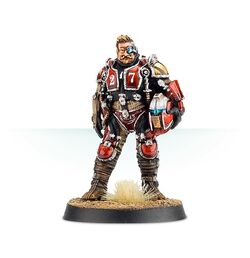
The Noble pilot of an Imperial Knight
At the heart of every knightly stronghold is a single massive building known simply as "the Sanctuary." It is here that the suits of Knight armour are stored when not in use and where the Nobles undergo the ancient rituals and procedures that allow them to bond with their Thrones Mechanicum.
These Sanctuaries are incredibly ancient structures, built when the original sublight Human colony ships first landed on the Knight Worlds during the Age of Technology. The essential functions of the Sanctuaries also originate from that time, though the changes and modifications made to the equipment over the millennia mean it would be unrecognizable to those that first installed it.
It is in the Sanctuary that young Nobles undergo the bonding process that imprints their personality into a Throne Mechanicum, in a procedure known as the Ritual of Becoming. This process takes place in a special room known as the Chamber of Echoes. The imprinting process is a lengthy, sometimes dangerous, business. It has become a rite of passage for young Nobles -- the process of leaving behind their childhood once and for all.
When he is old enough, a son of the household who is designated to become a Noble is fitted with the sacred neural sockets and then undertakes a vigil, remaining seated in the Throne Mechanicum that has been assigned to him throughout a long night in the Chamber of Echoes. The nature of this ordeal, and the inherent dangers associated with the neural interfacing process, mean that more than a tenth of all supplicants are either driven mad by the process or suffer fatal aneurysms brought about by neurological feedback.
Assuming it is successful, the imprinting process has two important side-effects. Firstly, the imprint tends to exaggerate dominant aspects of the young Noble's personality, especially with regard to the emotions he is feeling during his vigil. If he is scared, the imprint on the Throne Mechanicum will always be of a nervous tendency, making the suit difficult to control in combat. If the Noble is angry with someone, the imprint will always loathe that person, even if the Noble himself has long since forgiven or forgotten them.
When a Noble dies, his Throne Mechanicum retains some of his character and personality, and these ghosts whisper to each supplicant through the long vigil in the Chamber of Echoes.
However, in addition to imprinting the Noble's personality upon the Throne Mechanicum, the mind-link technology directly affects the personality of the Noble himself. It does this by implanting strong positive associations to notions of fealty, obligation and hierarchy, as well as a deep respect for the Noble's ancestors.
Exactly why and how these things are made to happen is something of a mystery, but it seems most likely that the mind-altering feedback routines were intentionally included by the device's original designers to limit the potential of a Noble to go rogue and turn on the people he was meant to protect.
Once a Throne Mechanicum has been imprinted, it is stored in the Communion Dome, which lies atop each Sanctuary. This chamber is large and circular, with walls that are lined with all the Thrones Mechanicum of the household's Nobles.
When a Noble wishes to interface with his suit of Knight armour, he sits upon his Throne and instigates the Protocols of Joining. Umbilical cords attach themselves to the Noble's neural sockets, and then a section of wall behind the Throne yawns open.
The Throne Mechanicum slides backwards, and descends from the Communion Dome through a series of transport tunnels, before finally sliding into the waiting cockpit of the Noble's suit of Knight armour. This final step in the process takes place in a massive hangar known as the Vault Transcendent, which forms the ground floor of the Sanctuary. This huge hall is large enough to hold all of the stronghold's Knights.
As soon as Noble, Throne and Knight armour are united, the three become as one, and the Imperial Knight powers up into life. Vast doors open in the outer walls of the Sanctuary, and the Knight strides forth to battle.
Knights At War
"Into them, lords and ladies! Into them! Let us purge these honourless vermin in the Emperor's name!"
- — Sir Massimo of House Hawkshroud
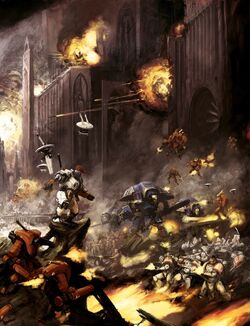
House Terryn Knight Paladins supporting White Scars Space Marines against Tau forces
When the Titan Legions of the Adeptus Mechanicus march to war, contingents from the Knight Worlds march beside them, and knightly houses will also send detachments of Knights to fight alongside other allies when they feel it is their duty or obligation to do so.
Traditionally, each knightly house sends one or more detachments of household Knights to fight when a Titan Legion musters for war.
The exact number of Knights in a household detachment varies considerably; when the call to arms is made, the representatives of the Forge World where the Titan Legion is based will request that each house provide a certain number of Knights. Knightly houses are honour-bound to obey such summons, and will only fail to comply in the most dire of circumstances.
Forfeiting such a commitment is a source of great shame and unlikely ever to be forgotten, either by the house itself, or their peers and rivals.
Because of this, it is almost always the case that the full quota of Imperial Knights appear at the rallying point designated by the tech-priests, ready to be transported away to join the Titan Legion. Arriving at the war zone, the eager Knights will quickly be hurled into battle.
Usually, they are either tasked with fighting directly in support of the Legio's larger Battle Titans, or operating independently as fast-moving scouts and protecting the flanks of the Legio's slower-moving war machines.
For almost all Imperial Knights, the call to fight as part of a Titan Legion is met with a burning enthusiasm. Knights from different household detachments vie with one another in acts of valour and heroism on the battlefield as well as through the spectacle of the banners and individual heraldry emblazoned on their suits.
The chance to earn glory while at the same time escaping courtly life not just for solar days, but for standard years or even solar decades, is considered the greatest reward they are ever likely to receive.
Occasionally, the Adeptus Mechanicus will decree that a household detachment must remain with the Titan Legion permanently.
When this is the case, the Nobles will change their vows of allegiance and heraldry from their house to the Titan Legion they now serve, and will be given an honorific title by the master of the Legio to better reflect their new status.
Knightly houses will also fight alongside Astra Militarum, Space Marine and other Imperial forces whenever they feel it is their duty to do so.
Sometimes this will be in return for help they received when defending their homeworld against alien invasion, as in the example seen in 456.M38. The 832nd lord of House Hawkshroud received aid against Drukhari raiding parties from the Mordian Iron Guard. The Mordian troops, under the command of Colonel Vargrif, helped defend the Hawkshrouds' stronghold against the Drukhari, foiling an attempt to kidnap Lord Hawkshroud's consort in the process.
Since that day, the Hawkshrouds feel honour-bound to provide aid to any descendants of the Vargrif line, should they be called upon to do so.
Knightly houses also send household detachments to take part in off-world campaigns if they feel that their honour has been impinged in some way. Knights are proud warriors, and cannot stand to let any slight be ignored, as many an aggressor has found to their cost.
It is not unheard of for a knightly house to hunt down and destroy an enemy that has invaded their homeworld, or for a house to send household detachments to help their allies defeat a hated enemy.
This was something that the T'au Commander Shadowsun discovered when her emissaries so infuriated the ruler of House Terryn with their veiled threats and over-bearing attitude, that he led several household detachments of his Knights to help the Imperial defenders of Agrellan.
Although Agrellan was eventually overrun, the Imperial Knights proved a formidable opponent for the T'au Empire, forcing Commander Shadowsun to deploy the newly designed XV104 Riptide Battlesuit to help counter them.
Unfortunately for Shadowsun, the defeat on Agrellan has only deepened High King Tybalt's loathing for the T'au, and he has decreed that the honour of his house will not be satisfied until the upstart xenos invaders have been driven back across the Damocles Gulf.
Wargear
- Acheron-Pattern Flame Cannon - The Archeron-Pattern Flame Cannon is a large arm-mounted, Knight-sized Heavy Flamer utilised by Cerastus Knight-Acheron pattern suits. This deadly weapon is ideal for immolating entire swathes of the enemy with each shot, and serve as an effective terror weapon.
- Autocannon - An Autocannon is a fully automatic heavy ballistic weapon capable of firing a hail of high-velocity shells. The Autocannons used by the Knights are almost exclusively in the possession of Knight Castellans, and they are heavyweight, multi-barreled, high-caliber weapons, fitting armament for a fire support Titan. A Knight Castellan's Autocannon is capable of stripping even a Titan of its void shields in a matter of seconds.
- Avenger Gatling Cannon - With six cyclic barrels, the Avenger Gatling Cannon can fire large calibre shells at a prodigious rate. These high velocity shots mow down enemy infantry or rip easily through light armour. Well-placed shots can tear through even thicker plating, blasting apart the heaviest armoured infantry or battle tanks. When firing at maximum rate, the Avenger stitches deadly patterns of death across the enemy's front lines while making a whirring hiss as the barrels spin faster than the eye can follow.
- Bolter - Knights utilise small bolters, relative to their own size, for protection against infantry boarding actions and to help mow down lightly armoured targets. Knight Bolters have a short range, and essentially are weapons only used in melee fights or when running down infantry formations.
- Castigator Bolt Cannon - The Castigator Pattern Bolt Cannon is a large, arm-mounted, twin-linked rotary weapon utilised by the Cerastus Knight-Castigator. This weapon is highly capable of obliterating infantry formations in a thunderous rain of mass reactive explosions.
- Energy Whip - A rarely used close combat weapon, the single whip lashes against the target causing light damage but also acts as a conductor for a massive electrical jolt intended to burn out circuitry and control systems in an opposing Knight. A successful hit with an Energy Whip automatically inflicts psychic shock in addition to any other damage done. The Energy Whip is also effective against buildings. The notable House Devine Knight Errant, Banelash, piloted by Albard Devine, utilised this weapon.
- Graviton Gun - A Grav-Gun is a devastating weapon usually employed by the malevolent Questoris Knight Styrix pattern suits, and is based on ancient and forgotten technology dating back to the time of the Age of Technology. Manipulating the very nature of gravity itself, a Grav-Gun turns a target's mass against it, crushing it to pulp under its own weight. Blasts from the Styrix's integral grav-gun pin hapless targets in place while scything vokite beams and flesh-boiling rad-cleanser discharges reap a heavy toll of lives.
- Heavy Flamer - Flamers are short-ranged weapons that spew out highly volatile clouds of liquid chemicals that ignite on contact with air. They are primarily used to scour the enemy from defended positions, as walls are of no defence against blasts of superheated vapour.
- Heavy Stubber - The Heavy Stubber belongs to a category of weapons that are, without exception, cumbersome, noisy and fairly primitive. These firearms make a formidable din when fired, and are easy to maintain.
- Hekaton Siege Claw - This large, tri-pronged claw is a deadly and effective close-combat weapon, most often employed by the malevolent Questoris Knight Styrix and sometimes the rare Questoris Knight Magaera patterns. When in close combat, the immensely powerful Hekaton Siege Claw can smash vehicles and tear buildings asunder.
- Ion Shield - All Knights carry potent defensive field generators called Ion Shields. The protective shields utilised by Knights are different from the void shields employed by true Titans. This ancient technology works by projecting an energy field across a narrow arc to the front of the Knight. By quickly moving the position of the shield so that it intercepts enemy attacks, a Knight is able to survive even the heaviest fire, whilst still being able to fire its own weapons in return. The exact setting and positioning of the shield is essential, as the Ion Shield is only designed to deflect and slow shots, rather than absorb them in the manner of the void shields used on Imperial Titans. This means the effectiveness of the shield is partially dependent on the skill and experience of its operator. Although giving ample protection to the front, this shielding fails at protecting the flanks of the war machine and even more so its back, which is completely vulnerable. In addition, unlike Titan void shields, Knight Ion Shields are unrechargable during combat once they have been breached or collapsed under enemy fire.
- Ironstorm Missile Pod - The Ironstorm Missile Pod is a carapace-mounted delivery system for explosive warheads. It can engage targets at long range and fires missiles that explode and saturate a sizable blast radius. The Ironstorm Missile Pod is ideal for blowing bloody holes in massed infantry assaults and is most effective against light-to medium-armoured foes.
- Lascannon - A Lascannon is a potent las weapon that fires high-energy laser beams capable of penetrating heavy armour at long range. Twin-linked Lascannons are used by Knight Crusaders for fire support purposes, and these Knights prefer those weapons over the Autocannons used by Knight Castellans for the same purpose due to their longer range.
- Lightning Cannon - A massive and deadlier version of the standard Lightning Gun utilised by the Thallax of the Ordo Reductor, the baroquely designed Knight-sized Lightning Cannon fires an ionizing las-beam down which a powerful phased discharge of electro-magnetic force is unleashed, vaporising infantry and blasting apart armour. This weapon is often employed by Questoris Knight Magaera patterns, to aid it in their shock assault role.
- Meltagun - Melta weapons are lethal anti-armour guns, most effective at very short range. When fired, the super-heating of the air produces a distinctive and sinister hiss. Solid rock is reduced to molten slag, and living creatures are vaporised in an instant!
- Phased Plasma-fusil - A marvel of lost technology, the Phased Plasma-fusil is a powerful and deadly plasma weapon used to breach the most heavily defended enemy positions. Plasma technology was far better understood during the dawning age of the Imperium, if still somewhat unsafe. As a result, this weapon was often utilised by the rare Questoris Knight Magaera pattern.
- Quake Cannon - A Quake Cannon is a massive artillery piece capable of shattering the armour of Titans or demolishing entire buildings. Quake Cannons are most usually placed on the arm hardpoints of Warlord-class Titans or on the carapace hardpoints of Imperator-class Titans. This is also a weapon employed by Knight Crusaders and Castellans. The Quake Cannon's great weight and these Knights' heavier armour prevents them from achieving the speeds necessary to make use of the Shock Lance.
- Rad Cleanser - Commonly known as Irradiation Projectors or Irad-cleansers, Rad Cleansers (nicknamed "Irad" or "Rad" projectors) are potent anti-personnel weapons and relics of the Age of Technology used exclusively by the militant forces of the ancient Mechanicum. This weapon can commonly be found upon the rare Questoris Knight Styrix pattern. Rad Cleansers comprise a bulky generator unit terminating in a dish-like projector that unleashes a powerful blast of deadly cross-spectrum radiations. Victims caught in the blast suffer an appalling death as they are boiled alive from within -- their tissues blasted apart on a cellular level, and even metals may combust in the powerful radiation blast. Thick barriers of solid matter (such as a vehicle's armour plating) between the beam and the target provide some protection from this effect, though victims that survive the initial blast will often die later of extreme radioactive contamination.
- Rapid-Fire Battle Cannon - This long range cannon is the equivalent of a large calibre artillery piece affixed to the arm of an Imperial Knight. Its rapid self-loading allows for accurate fire to be poured out at a tremendous rate and the blast of its explosive shot can rack up horrific casualties. It is often employed against infantry hordes, medium tanks and squadrons of light vehicles.
- Reaper Chainfist - A large Knight-sized, arm-mounted weapon that contains a pair of massive chainswords mounted side-by-side. This close combat weapon is most commonly employed by the Cerastus Knight-Acheron, with its built-in, twin-linked Heavy Bolter, this deadly weapon can cut down large swathes of enemy infantry and armoured vehicles with its thunderous barrage of mass reactive shells and the whirling teeth of its deadly blade.
- Reaper Chainsword - Three times the height of a man, this adamantium-toothed chainsword is powered by mighty servo-motors and backed by the strong swing of an Imperial Knight. Many have fled from the sound of its revving roar alone. Nothing can stop the grinding cut of its enormous blades -- not armour or the thickest ferrocrete. This is the signature weapon of Knight Paladins, though it is not exclusive to this particular pattern.
- Shock Lance - The Shock Lance traces its beginning to a humble electrical device used to herd great beasts that roamed the Knight Worlds. It delivered a fairly powerful shock that was necessary to inflict any pain on the thick-hided animals and its potential as a tool of war has been quickly recongnised. It has since been weaponised and the Knight Paladins and Errants that form the bulk of a standard Knight force are equipped with Shock Lances. The lances are mounted in the suits' visors, leading to a superstition rising amongst some that the Knights can kill with a glance. These weapons are used to release high voltage electromagnetic shocks on any targets that are in range. The engines of the Knight suits are fitted with huge dynamos that revolve as the Knight moves and charges into combat, storing an electric charge in capacitors located in the Knight suit's visor. When the Knight enters close combat, the charge is so great it can do nothing but ground itself -- usually via the enemy, delivering a devastating electric shock which can burn infantry to the bone and short out weapon and control systems. This weapon, although potent, prevents a Knight from charging a single target unless it is the size of a super-heavy vehicle or a Titan, lest they risk arcing the electric shock from their lances onto each other.
- Stormspear Rocket Pod - The Stormspear Rocket Pod is a carapace mounted weapon that fires self-propelled projectiles tipped with armour penetrating warheads. Only accurate to medium range, Stormspear rockets streak out in a series of sharp flashes to destroy their target. They are best employed versus heavily armoured infantry or moderately armoured vehicles. The Stormspear Rocket Pod can launch up to three of these rockets in rapid succession, emitting a high pitched whooshing shortly followed by the crack of explosions in the distance.
- Tempest Warblade - A large, Knight-sized power weapon utilised most often by the Cerastus Knight-Castigator, the Tempest Warblade is capable of obliterating infantry formations or carving apart light vehicles with ease.
- Thermal Cannon - Even the mightiest foes must fear such as weapon as the Thermal Cannon, for it is an incredibly large and powerful melta device. Its hissing blast can immolate everything in a wide radius, melting through a fortress wall or turning a battle tank into nothing more than a pile of bubbling slag. There is no armour that offers any proof against its super-heated shot, and the Thermal Cannon only becomes even more effective at closer ranges. It is a weapon often employed by Knight Errants, and is, along with the Thunderstrike Gauntlet, that pattern of Knight's signature weapon. This is only a tradition, however, and the Thermal Cannon is not tied solely to the Knight Errant and could be used by other patterns of Knight armour, if necessary.
- Throne Mechanicum - Suits of Knight armour are similar to Titans, in that they are controlled through neural interface sockets surgically inserted into the Noble pilot's cerebrum and cerebellum much like those of a Titan's Mind Impulse Unit. The pilot sits in a control platform called a Throne Mechanicum, where umbilical interface cords are attached to his neural sockets. The Throne Mechanicum is then, in turn, plugged into the suit of Knight armour, allowing the Noble to control its movements as if it were part of his own body and to receive sensory feedback from the suit so that he can see what it sees, and feel what it feels. This interface allows an Imperial Knight to move with a fluid grace that can only be matched by the war machines of the Eldar.
- Thunderstrike Gauntlet - Crackling with a barely contained nimbus of energy, the Thunderstrike Gauntlet is a supercharged power weapon. Merely clenching the fist causes shockwaves to emanate outwards while sparks of incandescent fury fall in sizzling arcs. When the gauntlet smites a foe it releases a deafening thunderclap that crumples protective armour and pulverises its target. When an Imperial Knight swings its Thunderstrike Gauntlet against an enemy vehicle or towering monster, the sheer force delivered by its powerful blows can even lift and fling the crushed remnants of the Knight's victim onto nearby infantry, their horrified screams drowned by the crash as their own armoured support obliterates them.
- Twin Icaraus Autocannons - The Twin Icarus Autocannon is a ballistic anti-aircraft array that can be mounted to the carapace of an Imperial Knight. It is linked to the Throne Mechanicum and aided by a servo-mind conclave. With the merest thought from the Knight's pilot, the Twin Autocannons pivot, tracking incoming flyers impossibly fast and letting loose a stream of deadly fire. The steady chug-chugging of the guns can scythe off wings or rip enemy aircraft out of the skies, turning them into naught but hurtling fireballs.
- Volkite Chieorovile - "Volkite" is an arcane Martian term for a variety of powerful directed energy weapons whose origins date back to the Age of Strife. Possessed of considerable killing power surpassing most armaments of their size, Volkites were difficult to manufacture, even for the most able of the ancient Mechanicum's forges. The Knight-sized Volkite Chieorovile was often utilised by the malevolent Questoris Knight Styrix pattern, which enabled it to easily eliminate large numbers of infantry at range.
Heirlooms of the Knight Houses
Heirlooms of the knightly houses are unique and incredibly powerful relics of the Imperial Knights, and many have served their greatest champions for over fifteen Terran millennia. Only one of each of the following relics will accompany a force of Knights -- there is only one of each of these items in the entire galaxy!
- Banner of Macharius Triumphant- A gift from Lord Solar Macharius himself to honour the knightly houses that accompanied his Macharian Crusade, this banner was borne to battle by a Knight Seneschal in every engagement in which the Knights fought alongside the Imperial Warmaster. Legend has it that the Banner of Macharius Triumphant has never seen defeat, for every time a Knight has carried it to war, a great victory has been won for the Imperium. To see its majestic form fluttering in the wind instils the Emperor's warriors with great courage, for to fight in its shadow is to all but assure victory.
- Helm of the Nameless Warrior - Though many great heroes through the ages have mounted this fabled faceplate upon their Knight suits, the names of both the suit and the valiant pilot who first bore this helm have been lost to history. Regardless of its origins, the Helm of the Nameless Warrior has become synonymous with murderous ferocity in battle. Whether this reputation stems from some mysterious essence intrinsically bound within the helm, or because those who bore the helm were merely roused to terrible fury by the weight of bearing such an infamous relic remains unclear.
- Mark of the Omnissiah - An unassuming device that takes the shape of the Cog Mechanicum, the Mark of the Omnissiah is actually an incredibly potent self-repair hub. If the Knight suit upon which it is affixed takes battle damage, reconstruction protocols automatically engage to heal rents and restore lost power.
- The Paragon Gauntlet - It is believed that this masterwork weapon was the prototype for the Thunderstrike Gauntlet -- the first, perfect copy fabricated by a long-lost STC system that was developed on Mars during the Age of Technology. It was that same STC that was integral to the founding of the Knight Worlds themselves, by equipping Mankind's first exploration fleets with the knowledge to build the mighty armoured suits. If true, it would certainly explain the incredible level of artifice that went into the gauntlet's creation.
- Ravager - This storied Reaper Chainsword has claimed millions of lives during its long service to the knightly houses. The chainblade's razor-sharp teeth were harvested from the canines of a long-extinct species of bio-horror called Balethrox. What makes this fact so startling is that dozens of the fell creatures must have been hunted down and slain by brave Knights in order to secure enough fangs to line Ravager’s cutting blade. However, witnessing the murderous wrath of this chainblade's touch in battle more than justifies the dedication of those long-dead Knights who fought to secure the rare components for its forging, and its bearer will fight all the harder to honour their sacrifice.
- Sanctuary - This potent Ion Shield was created by a Jokaero weaponsmith that accompanied his Inquisitor master on a routine inspection to the Knight World of Silverdawn. After tinkering with a burned-out Ion Shield generator, the techno-savant was able to repair and upgrade the device so that it emitted a stronger and more stable power field that could shelter a Knight suit from every angle, though at slightly reduced effectiveness.
Heraldry
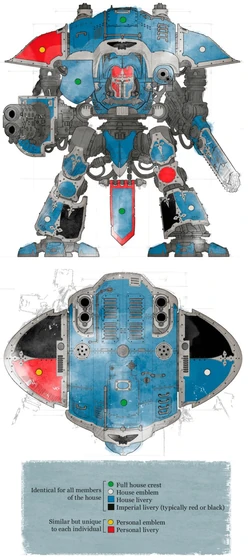
The most common forms of Knight heraldry for Imperium-aligned Knight houses
Every Imperial Knight is a precious and valued war machine, revered by its Noble pilot and painstakingly maintained by the house Sacristans responsible for its upkeep. Each is painted in the glorious heraldry of its house, and decorated with imagery and iconography that tell of its homeworld, oaths and battle honours.
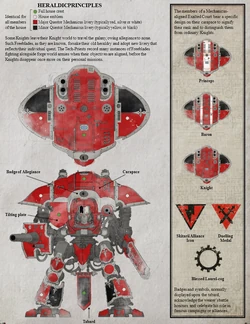
The most common forms of Knight heraldry for Adeptus Mechanicus-aligned Knight houses
The Knight houses use an elaborate system of heraldry signifying their allegiance and the house to which they belong. Knights will use some variation of their house's heraldry as their livery, incorporating its themes and motifs, but no two liveries can be identical. All Knights bear striking, colourful liveries and often adorn their war machines with heraldic pennants. It is customary for the Knights to compete not only in combat feats, but also in the appearance of their war mounts. Each symbol on an Imperial Knight has a powerful resonance for its wearer and a deep inner meaning.
Most Knights carry a variety of pennants and banners proudly proclaiming their heritage and battle honours. These flags are flown from carapaces and weapons but, most commonly, hang from the pinions that drive the war machine's powerful legs. Although the houses remained independent and isolated from the rest of Mankind for millennia after the settlement of their homeworlds, their banners became more standardised when the Nobles bent their knee to the Emperor of Mankind or the Adeptus Mechanicus in His stead.
To this end, the banners of both Questor Imperialis and Questor Mechanicus Knights are broadly similar. The general format of a house banner has the house crest in its full form in the upper half of the pennant. All Knights from a single house will carry this identical sigil. The lower portion of the banner is devoted to kill, honour and campaign markings.
These will differ from individual to individual, depending on where they have served and what honours they have gained. The exact layout and composition of these honours also varies from house to house. Some Knight houses prefer a relatively simple arrangement of these markings with coloured fields behind the icons, while other may favour a more complex array of icons and markings.
The kill campaign and honour badges are a mix of local iconography (perhaps unique to a house) and sigils used by the armies of the Imperium. For example, if a Knight serves in an Imperial campaign, his banners would display the official badge for that action, and this sigil would also be worn by any Space Marines or Imperial Guardsmen involved.
The banners belonging to Freeblade Knights exemplify their individualism. They often echo the livery the pilots choose to apply over the top of their old house colours. Mottoes are not uncommon, or alternative versions of the icons of these outcasts choose to identify themselves by. Such designs often reflect the fatalistic approach of the pilots -- with skulls and other memento mori represented in great number. The pride of the Nobles who pilot the great Knight units is such that they will take any opportunity to proclaim their loyalties and achievements. To this end they often decorate the rear side of their banners. Though less visible, these spaces are used for catechisms, rolls of honour and lists of revered ancestors.
House Heraldry
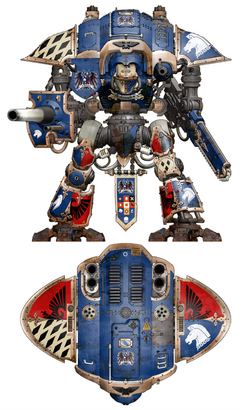
Example of the detailed chivalric livery utilised by House Terryn
The Knight houses trace their origins to a period thousands of standard years before the birth of the Imperium of Man, so their banners present a visual language that appears to have evolved through time. Each began as a simple device, such as the white horse of House Terryn.
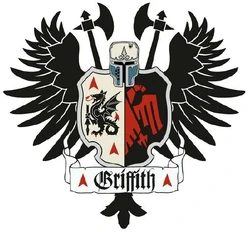
Heraldry of the Imperium-aligned House Griffith
Over the millennia, new alliances and significant events caused it to evolve into something grander, reflecting the complex relationship between the Knight house and the Imperium itself. The white horse is symbolically linked to a vision that the house founder had way back in its distant past. Over the millennia, more heraldry, such as the helm above the crest and the swords behind were added (symbolic of an ancient battle), as was the house name.
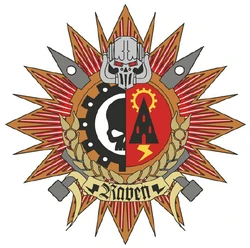
Heraldry of the Adeptus Mechanicus-aligned House Raven
Later, when Seuitonius Terryn swore allegiance to the Imperium, the crest was marshalled, with the half-Aquila falling on the right side, and resplendent eagle wings as supporters. This half-and-half shows the observer the relationship between the knightly house and the Imperium, and the dichotomy of loyalty to their house and the wider Imperium.
Other forms of Knight house heraldry, such as the house banner of House Griffith, possess subtle nods to events in their long, glorious history in the crest and secondary devices they employ. These are often very grand, with a mythological aspect to whatever symbols are chosen. House Griffith has fought wars against dragons during its ancient history, and as such wear dragons as their crest. This desperate struggle served to harden the Nobles into skilled and fierce warriors.
Millennia later, House Griffith is sworn to the Imperium, and has earned a reputation for producing some of the most formidable warriors ever to sit upon the Throne Mechanicum. The heraldry of House Griffith is halved with a dragon motif, connecting to their ancient history, and a red-winged Aquila, professing loyalty to Terra. What truth lies behind the dragon symbol is now the subject of legend as much as historical fact, but to the warriors of House Griffith, it is very important.
Essentially the same is true of the Questor Mechanicus houses. Their imagery tends more towards the industrial, with harder edges to their designs, where tools replace the swords and axes displayed by other houses. In the place of Imperial Aquilas, these Imperial Knights wear the half-cog of the Adeptus Mechanicus. The same dual-split remains here, with loyalty divided between the house and the Machine Cult.
A perfect example is the crest of House Raven, foremost among the knightly houses aligned to the Adeptus Mechanicus. Their ancient alliance was brought about when a lord of House Raven witnessed the Magi of Forge World Metalica rouse to life Knight suits that had lain inoperable for centuries. The seat of House Raven's power is their indomitable fortress known as the Keep Inviolate, a foreboding structure on the Knight World of Kolossi. The full house crest of Raven bears homage to their heritage with the dual image of the Keep Inviolate and the Opus Machina.
Finally, each Imperial Knight has the right to wear his own personal heraldry. Those of Imperial-aligned houses wear this on their front-right shoulder plate of their Knight. The form it takes is a matter of personal choice, although different houses have their own traditions. Adeptus Mechanicus-aligned houses do not typically bother with this at all. The Nobles from houses such as Krast and Raven are willingly subsumed, and do not fear for their independence.
Heraldric Devices
Each suit of Knight armour worn by Nobles of a Questor Imperialis Knight house will always display three things: the major plates display house symbols, most typically the crest and lesser icons. The minor plates show Imperial heraldry. Finally, the Knight's front right shoulder guard is reserved for the personal heraldry of the Noble pilot -- this is a heraldic design which is unique to that specific warrior and none other.
Knight houses of the Questor Mechanicus dedicated to the service of the Machine God are less predisposed to tolerate personal heraldry; this does not, however, preclude individual differences. Also of note is the common practice of painting the Knight's faceplate in a black and white half tone.

A common Knight symbol used to illustrate opposition to the Forces of Chaos
- The Gauntlet - The symbol of an armoured gauntlet crushing a serpent symbolises House Krast's hatred of Chaos. The warriors of House Krast are violent opponents of the Forces of Chaos. Historically they were the first knightly house to join their forces to the Great Crusade, and they took great honour in their part of the Emperor's galactic conquest. But when the Horus Heresy reared its head, they suffered terribly. Chrysis, the home planet of House Krast, was utterly ravaged by the Traitors, and left as little more than a husk, reduced to a poisonous wasteland by the virus weapons unleashed upon it. Even 10,000 standard years later, the Nobles now live in Void-Shielded enclaves, and look out at their ruined world and feel a burning hate. Their icon is now the embodiment of their quest for vengeance, and they proudly tally the many Chaos worshippers they have defeated. Prosecuting this endless battle against the forces of the Dark Gods has become their driving motivation. Such is their venom that there is a secret place on their homeworld, known as the Hammer of Traitors. Here they carve the names of Chaos worshippers they have destroyed -- and, rumour has it, bring prisoners to die terrible, gasping deaths in the poisonous air.

A kill marking specific to House Krast
- Knightly Honours - Glorious kills are celebrated by Imperial Knights with icons to be worn on their personal banner or suit of Knight armour. These take many forms, from targetting symbols or small skulls to rings around weapon barrels. House Krast's greatest hate is for the Traitor Titan Legion of the Legio Mortis, who they hold accountable for the horrors unleashed on Chrysis. The broken death head symbol utilised by the Knights of House Krast is a modified badge of the Legio Mortis, with a crack which denotes a Titan kill of their most hated enemies.
Marks of Fealty
Every Imperial Knight wears an icon upon its carapace that proclaims the loyalty of its house to all that behold it:
- Imperial Eagle - The Imperial Eagle, or Aquila, is the icon worn by Imperium-aligned houses. It is worth noting that, while his icon proclaims a close military alliance, it does not imply any form of subjugation. Indeed, Knight Houses see themselves as equals (if not betters) of the Imperium, alongside whom they fight for mutual benefit and as a sign of friendship.
- Machina Opus - The icon of the Adeptus Mechanicus, also known as the Cog Mechanicum , is worn by Imperial Knights in houses which are aligned with the Priesthood of Mars. Houses that wear this mark not only fight alongside the Adeptus Mechanicus, and will answer a call for aid without hesitation, but can also rely on the industrial might of the Forge Worlds to supply and repair their war machines.
- Laurels Fidelis - Knights who take the mantle of Freeblades cast aside the heraldry of their former houses. Tradition dictates that these Nobles adopt the Laurels Fidelis, a laurel-wreathed skull which indicates their continued loyalty towards the Imperium of Man, despite leaving their houses behind. An Imperial Knight wearing this symbol will fight for Mankind, even until death.
Freeblade Heraldry
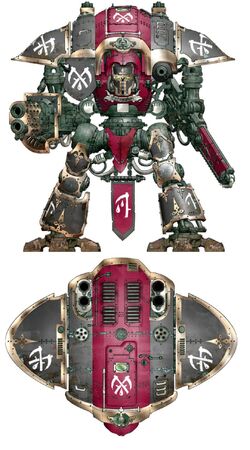
The Freeblade Knight known as the Crimson Reaper is as notorious for his murderous tendencies as he is for his deadly skill in battle
Despite the fact that there have been many cases of Freeblade Knights working in concert -- even as part of a household detachment -- over the Imperium's long history, the vast majority of them choose to fight alone. The reasons behind this solitary existence are many and varied, but it is certain that each Freeblade would have a long story to tell if ever he chose to reveal his past, though it is unlikely that the truth would be a pleasant one.
It is their mysterious history that leads many Freeblades to forsake their origins and take on a whole new identity. Many of these Knights choose to hide behind a cryptic name, though whether or not it is possible to discern a glint of a Freeblade's past from his choice of title is an enigma in itself. It is likely that after many long years of relentless warfare, some Knights may even have forgotten why they took their first step along the path of the Freeblade.
Unlike household Knights, Freeblades commonly choose a single colour as their suit's livery, adopting simple designs or patterns if any at all. Many choose to only show significant iconography on their tabard, though even these are symbolically selective in decoration. A Freeblade Knight's choice of livery and what passes for heraldry is unique, and no two Freeblades will ever look the same.
Chaos Knights (Questor Traitoris)
"These Chaos traitors slink from the shadows like scavengers come to pick a carcass clean. They believe that their cause is already won, arrogant vermin that they are. It will be my great and personal pleasure to disabuse them of this notion. Gather the banners! Sound the clarion call!"
- —High Queen Terenicia Asmosali Vostris, before the Relief of Corphan's Reach
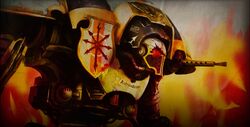
A Chaos Knight stalking into battle
During the Horus Heresy, the galaxy was engulfed in the fiercest civil war Mankind has ever known. Those who remained loyal to the Emperor fought against their erstwhile brothers as the Warmaster Horus made his bid for power. In those days, bonds of brotherhood were shattered and mistrust was common, treachery becoming as much a weapon as Bolters and Battle Cannons.
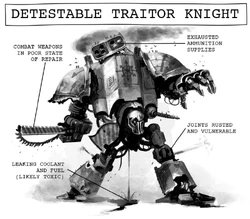
Imperial propaganda poster of a Renegade Knight
The Imperial Knights that did turn to Chaos have long since died but their souls live on as daemons, floating within the shells of their corrupted war machines. The Chaos Knights themselves have also mutated, sprouting claws, tails and other horrendous natural weapons as blessings of the Dark Gods.
When the war machines of a Knight house dedicated to the Ruinous Powers marches onto the battlefield, it spreads havoc, despair and death. When the Heresy finally ended, these Renegade Knight houses, known in High Gothic as the Questor Traitoris, presumably fled into the Eye of Terror alongside the rest of the Forces of Chaos, and remain active to this day, now twisted and changed by the mutating power of the Warp.
When a daemonic legion marches to war it is sometimes preceded by these Chaos Knights, spreading havoc and despair. In general, though, the innate conservatism of the knightly houses has made them resistant to the lures of the Chaos Gods, and Renegade Knights are therefore a rare sight on the battlefields of the late 41st Millennium.
Daemon Knights of Slaanesh
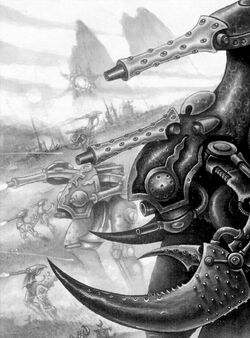
Slaaneshi Daemon Knights and Chaos Titans charging into battle
Imperial records are somewhat lacking in their information referring to the Knights in general, and this is only more true in regard to those Renegade Nobles of the Knight Worlds who have embraced the fickle blessings of the Chaos Gods. Almost all knowledge of these Traitors comes from records concerning those of the Knights that have dedicated themselves to Slaanesh, and virtually nothing is known of those in service to the other Chaos Gods, or of those worshipping Chaos Undivided as a singular entity.
Since the first betrayal during the Battle of Molech by House Devine, many Knight households have been corrupted by Chaos down the millennia. Their crews have long since died but their souls live on as daemons, floating within the shells of their war machines. The Renegade Knights themselves have also mutated, sprouting claws, tails and other horrendous weapons. When a Slaanesh army marches to war it is preceded by these Daemon Knights, spreading havoc and despair.
The Daemon Knights of Slaanesh are the first element of an advancing Slaaneshi army, preceding the bulk of Chaos forces and Chaos Titans. Their task is to seek out the enemy, probe defences and attempt to flush them out of fortified positions. The Knights' chief advantage is their speed and agility, allowing them to easily outflank any enemy and to run down and exterminate any stragglers.
Slaaneshi Daemon Knights do not use Shock Lances or Power Lances, as these weapons do not suit their style of combat. Akin to the Chaos Titans of Slaanesh, and the Eldar Titans that they emulate, the Daemon Knights are exceptionally nimble and agile, and they prefer to ambush their enemies and fight from afar, rather than charge headlong into close-quarters melee.
These Daemon Knights also do not utilise Ion Shields. Instead, they are surrounded by a glittering wall of energy created by the Warp-interface within them which anchors the daemonic spirit inside in the material realm. This shifting, swirling aura is called the Glamour of Slaanesh and makes the Daemon Knight very hard to target accurately.
In effect, it works like an Aeldari Holo-field, and is a yet another emulation of that xenos race's Titans. Like the Holo-field, the Glamour of Slaanesh proves useless against barrages and other attacks spread over a wide area, as such weapons do not rely on pinpoint accuracy. Additionally, since the Glamour of Slaanesh is an interface with the Immaterium, it also provides a measure of protection against attacks drawing upon the Warp, such as Vortex Missiles or psychic powers.
Daemon Knight Patterns
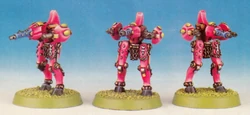
- Hell-Strider - The Hell-Strider is the smallest of the Daemon Knights, but still stands many times the height of a man. They are armed with Lascannons and short-range, Knight-sized Melta Weapons. Hell-Striders are extremely mobile, able to flush the enemy out of woods and ruins with their powerful short ranged weaponry. Given sufficient numbers, Hell-Striders are even capable of toppling a Titan, picking off their prey's Void Shields with their Lascannons before closing in for the kill with their Melta-beams.
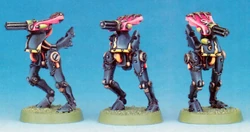
Hell-Scourges
- Hell-Scourge - Hell-Scourges are one of the largest patterns of Slaaneshi Daemon Knights. As living machines in the service of the Prince of Chaos, they have crushed countless opponents in the last ten millennia, screeching deafening cries across the battlefield. They are the perfect predators, hunters who mercilessly run down their quarry with the bounding strides of their elegant, powerful legs. The Hell-Scourges attack without warning. As one appears, the enemy turn their weapons on its blurred form, only to see it disappear. At that moment, others attack from all sides, mowing through armour and flesh with their massive Castigator Cannons. Hell-Scourges possess a certain pack instinct and are in constant telepathic communication with each other. As such, they make exceptionally well co-ordinated assaults, out-flanking their enemies with ease. This telepathic contact seems to encompass all Hell-Scourges present on the battlefield, or perhaps even further. This enables Hell-Scourge detachments exceptional flexibility on the battlefield.
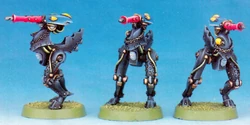
Hell-Knights
- Hell-Knight - Hell-Knights are one of the most specialised types of Daemon Knights. Aside from Bolters, their main weapon is a Thermal Cannon which, albeit short-ranged, has enough power to pierce almost any armour plate with relative ease. Hell-Knights are often used to hunt down enemy Knights and Titans, exploiting their speed to attack from the sides and overwhelm opponents. In addition to this, they are perfectly suited to perform ambushes, and are often used in this respect. A notable exploit of the Hell-Knights took place on the Hive World of Kado as part of a massive daemonic incursion. Imperial forces and the Titans of the Legio Crucius suffered grave losses in the defence of that world's capital hive city. As the Titans fired upon the advancing hordes of Chaos, felling hundreds upon hundreds of daemons and Heretics, a large force of Slaaneshi Daemon Knights infiltrated the hive city's massive subterranean transportation network. As the battle raged above them, the Chaos walkers sped through the dimly lit tunnels and corridors, quickly obliterating any resistance they encountered. On the second day of the hive city's siege, the Daemon Knights emerged from beneath the ground and burst into the main streets and arcades of the city, indiscriminately destroying everything, killing thousands of helpless citizens. The transports of the Adeptus Arbites arrived, but these too were totally crushed and the Hell-Knights fought their way back to the surface. They emerged within firing distance behind the Titans of the Legio Crucius. With a single massed salvo from the Daemon Knights' Thermal Cannons, nearly the entirety of the Loyalist Titan battlegroup was destroyed, the august forms of the Titans turned into molten slag. Amongst the victims of this attack was the colossal Praeco Deictus, an Imperator-class Battle Titan which had survived the grim days of the Horus Heresy and brought victory to the Imperium on over a thousand worlds. As Hell-Knights are super heavy they cannot be pinned in combat except by other super heavy vehicles or Titans. Anything smaller than this is simply pushed aside by the massive war machine. Hell-Knights are excellent at infiltrating enemy positions, setting ambushes for enemy supply columns and attacking enemy support detachments and artillery.
Notable Knight Houses
Loyalist Knight Houses
| Knightly House Name | Homeworld | Allegiance | Summary |
|---|---|---|---|
| House Adamant | Unknown | Questor Mechanicus | House Adamant is an Imperial Knight house that is known to control an entire world by itself, thus making it one of the so-called "Great Houses." House Adamant gives its direct fealty to the Adeptus Mechanicus. |
| House Agaron | Silverdawn | Questor Imperialis | In 784.M34, after more than a century of self-imposed exile as a Freeblade household detachment, the Agaron brothers return to the Knight world of Silverdawn after the death of their father. The siblings are welcomed back as heroes after the disastrous reign of their sire. Basilio, the eldest of the three, re-establishes trade with the nearby Forge Worlds of Estaban III and VII. |
| House Althalos | Unknown | Questor Imperialis | Along with the Knights of House Mortan and House Thalmus, House Althalos came to the aid of the Hive World Hexis Alpha, when a Warp rift spawned a tide of Daemons across its surface. More than 100 billion lives were saved, due to their successful efforts in defending the Hive World from the Daemons. |
| House Arakon | Unknown | Questor Imperialis | There is very little information in Imperial records about this Knight house, and it is unknown from which Knight World it hails. |
| House Aramos | Rapture | Questor Imperialis | House Aramos hails from the now-Dead World of Rapture, which was a once-verdant Knight World of the Reductus Sector, until it was ravaged by the Tyranids of Hive Fleet Leviathan in 997.M41. The stalwart Knights of House Aramos refused to abandon their lifeless world, and strive to hunt down any remaining Tyranid survivors that survived the initial Imperial purge. |
| House Arokon | Unknown | Questor Mechanicus | House Arokon hailed from the Styken System far to the galactic north-west in the Segmentum Obscurus. Along with ten other knightly houses to call upon, House Arokon provides a standing guard -- known as the Order of Iron -- upon the surface of the principal planet, the Forge World of Stryken Primus, to ensure this vital world's protection. |
| House Arundel | Unknown | Questor Mechanicus | There is very little information in Imperial records about this Knight House, and it is unknown from which Knight World it hails |
| House Beaumaris | Unknown | Questor Imperialis | There is very little information in Imperial records about this Knight House, and it is unknown from which Knight World it hails. |
| House Blackskull | Scuptium VII | Questor Imperialis | In 559.M41, the major knightly houses of the planet of Scuptium VII are all but destroyed in the initial stages of a vast Ork invasion. Only the heroics of the world's least favoured house, Blackskull, prevent their entire sub-continent from being overrun. Eventually the last twelve Knights of the ruined house retake their entire planet. |
| House Borgius | Dutonis | Questor Imperialis | House Borgius hails from the acrid, volcanic world of Dutonis, located in the galactic north-east of the Segmentum Obscurus. Despite being bitter rivals, two knightly houses -- Borgius and Navaros -- long protected their homeworld of Dutonis. Following the death of the Arch-Traitor Horus a combined strike force of Knights from Houses Cadmus, Terryn and Borgius annihilates the turncoats of House Devine as Imperial forces reclaimed Molech. |
| House Brahmica | Alaric Prime | Questor Imperialis | In 998.M41, House Brahmica joined the Imperial forces defending against Warlord Grukk of the Red WAAAGH! that ploughed into the densely populated Sanctus Reach, his crusade's juggernaut momentum smashing past the Space Marine homeworld of Obstiria to plunder the planets beyond. |
| House Cadmus | Raisa | Questor Imperialis | In recent times, the fighting strength of House Cadmus has suffered greatly in defence of the Forge World of Gryphonne IV, supporting its Titan Legion, the Legio Gryphonicus, after it was overwhelmed by Hive Fleet Leviathan in 997.M41. The Forge World's destruction has, in turn, freed House Cadmus from their obligations to the Adeptus Mechanicus. |
| House Calestros | Alaric Prime | Questor Imperialis | There is little information in regards to this Imperial Knight House in official Imperial records other than that in 998.M41, Warlord Grukk of the Red WAAAGH! ploughed into the densely populated Sanctus Reach, his crusade's juggernaut momentum smashing past the Space Marine homeworld of Obstiria to plunder the planets beyond. When a flotilla of Ork rust-ships make planetfall, the knightly houses of Alaric lead their Cadian allies in a worldwide counterattack. During this conflict Kyrana Calestros was foully slain when he held back an Ork flotilla for half a cycle. |
| House Col'Khak | Atar-Planitia | Questor Mechanicus | Since its inception, the Col'Khak Collective has followed the strictures of the Sidon Protocols, effectively bonding it to the Atar-Median Forge. The warriors of Col'Khak have long since adapted many of the rites and practices of the Cult Mechanicus for their own use, treating all technological artefacts as precious relics and heirlooms of the Collective. Many even voluntarily accept extensive levels of augmentation, although aesthetically choose to remain human in overall appearance. |
| House Coldshroud | Unknown | Questor Imperialis | There is little information in regards to this Imperial Knight House. The only thing that is known about them, is that they have remained steadfast with their alliance with the Legio Gryphonicus Titan Legion. |
| House Curtana | Karastus | Questor Mechanicus | There is little information on this knightly house in official Imperial records. House Curtana hails from the Knight World of Karastus. |
| House Degallio | Alaric Prime | Questor Imperialis | House Degallio is an old and prominent knightly household that was once led by Neru Degallio, a master of scores of Knights and Nobles. Neru was feared and respected in equal measure. For much of his life, Neru enjoyed only success and glory. That came to end with the arrival of the Red WAAAGH! in 998.M41, and the doom of his house. His losses would drive Neru and his Knight, the White Warden, onto the path of the Freeblade. |
| House Donar | Molech | Questor Imperialis | House Donar was one of several ancient Knight households that hailed from the world of Molech. They formerly served as the wardens of the Western Marches of the continent of Molechari. Like several of their fellow Loyalist Knight households, Donar was utterly annihilated during a last stand at the Battle of Molech in the middle years of the Horus Heresy. |
| House Dorath | Unknown | Questor Mechanicus | House Dortah hails from the Styken System far to the galactic north-west in the Segmentum Obscurus. Along with ten other knightly houses to call upon, House Dorath provides a standing guard -- known as the Order of Iron -- upon the surface of the principal planet, the Forge World of Stryken Primus, to ensure this vital world's protection. |
| House Dunstan | Unknown | Questor Imperialis | There is very little information in Imperial records about this Knight House, and it is unknown from which Knight World it hails. |
| House Durbach | Unknown | Questor Mechanicus | House Durbach is an Imperial Knight house that is known to control an entire world by itself, thus making it one of the so-called "Great Houses." House Durbach gives its direct fealty to the Adeptus Mechanicus. |
| House Feardraken | Unknown | Questor Imperialis | The Knights of House Feardraken come from a water-locked world, where in ancient days they were forced to battle giant sea creatures to protect the lives of their people. In an effort to strike fear into the hearts of their foes, the Knights would later adopt the name of the creatures they battled: thus House Feardraken was born. |
| House Fvaber | Unknown | Questor Imperialis | There is little information in regards to this Imperial Knight House. The only thing that is known about them, is that they have remained steadfast with their alliance with the Legio Gryphonicus Titan Legion. |
| House Griffith | Dragon's End | Questor Imperialis | The Knights of House Griffith are consummate warriors, having earned their bloody reputation across battlefields uncounted. Deadly with blade and cannon, they are amongst the boldest ever to sit the Throne Mechanicum, each striving to maintain their legacy of martial excellence. |
| House Hasburg | Unknown | Questor Imperialis | House Hasburg is a hidebound knightly house, whose days are almost wholly consumed tending to the obscure and esoteric tenets of tradition. At the dawn of every day the entire court must gather to hear the reading of the names and deeds of every ruler of the house; there are hundreds of names, and the process takes up most of the local day. |
| House Hawkshroud | Krastellan | Questor Imperialis | To the Noble Knights of Hawkshroud, honour is the single most important virtue of all. So essential to their way of life is the esteem and reputation of their house that Hawkshroud's Knights will honour any call to arms from those that have earned their loyalty or respect. |
| House Hawkwood | Unknown | Questor Mechanicus | There is very little information in Imperial records about this Knight House, and it is unknown from which Knight World it hails. |
| House Helmast | Alaric Prime | Questor Imperialis | There is little information in regards to this Imperial Knight House in official Imperial records, other than that they hail from the Feudal World of Alaric Prime in the Sanctus Reach. |
| House Hermetika | Kaldeia | Questor Mechanicus | The closeness of their homeworld with the Forge World of Mezoa in the Gothic Sector of the Segmentum Obscurus has naturally led the Knight House to align itself to the Adeptus Mechanicus rather than directly to the Imperium of Man, although House Hermetika's strength and wisdom is such that it has escaped the strict tenures of the Sidon Protocols. For millennia House Hermetika has remained a faithful ally to the Forge World of Mezoa rather than its vassal. |
| House Hyperion | Unknown | Questor Imperialis | There is very little information in Imperial records about this Knight house, and it is unknown from which Knight World it hails. |
| House Illius | Vorinth | Questor Imperialis | In 544.M32, an Ork WAAAGH! of unprecedented scale sweeps into Imperial space. Hundreds of worlds are devastated before the Ork menace is finally defeated. Lying directly in the path of the enormous greenskin armada, the Knight world of Vorinth is one of the first planets to fall. Though they fight bravely, the Knights of Houses Illius and Nero are impossibly outnumbered and die to the last in combat with the all-conquering Orks. |
| House Indra | Molech | Questor Imperialis | House Indra was one of several ancient Knightly Households that hailed from the world of Molech. They formerly served as the wardens of the vast swamplands of the Southern Steppes of the continent of Molechari. Like several of their fellow Loyalist Knight Households, Indra was utterly annihilated by the Traitor Legions and their Traitor Titan Legio allies at the Battle of Molech during the middle years of the Horus Heresy. |
| House Kamidar | Kamidar | Questor Imperialis | During the Noctis Aeterna, House Kamidar lost contact with the Imperium and became autonomous within the Ironhold Protectorate system of the Imperium Nihilus, though a Torchbearers fleet of the Indomitus Crusade eventually arrived to restore contact. Kamidar is ruled by High Queen Orlah Y'Kamida. |
| House Kamata | Alaric Prime | Questor Imperialis | There is little information in regards to this Imperial Knight House in official Imperial records, other than that they hail from the Feudal World of Alaric Prime in the Sanctus Reach. |
| House Kaska | Molech | Questor Imperialis | House Kaska was one of several ancient Knight households that hailed from the world of Molech. They originated from the Kasha Peninsula close to the westernmost point of the continent of Molechari. Living by a different set of codes than their upstart high-born kin, Kaska Scions had to prove their skills and mettle as warriors. They did not care for pomp and circumstance and had little patience with ceremony and the trappings of the Molechian nobility. Like several of their fellow Loyalist Knight Households, Kaska was utterly annihilated by the Traitor Legions and their Traitor Titan Legio allies at the Battle of Molech during the middle years of the Horus Heresy. |
| House Kaushik | Molech | Questor Imperialis | House Kaushik was one of several ancient Knight households that hailed from the world of Molech. They originated from the planet's ancient subterranean arcologies located hundreds of kilometres beneath the towering Untar Mesas, House Kaushik was an insular household. Kaushik was utterly annihilated by the Traitor Legions and their Traitor Titan Legio allies at the Battle of Molech during the middle years of the Horus Heresy. |
| House Kestren | Alaric Prime | Questor Imperialis | There is little information in regards to this Imperial Knight House in official Imperial records, other than that they hail from the Feudal World of Alaric Prime in the Sanctus Reach. |
| House Khord | Avalane VI | Questor Imperialis | There is very little information in Imperial records about this Knight House, though it is known that it hails from the Knight World of Avalane VI. This planet is heavily forested, and as a result House Khord makes use only of Cerastus Knight-Lancers, as their speed and agility is necessary to traverse the rough terrain of the world efficiently. |
| House Krast | Chrysis | Questor Mechanicus | House Krast hails from the Knight World of Chrysis, and was the first of its kind to be rediscovered by the Imperium at the outset of the Great Crusade in the late 30th Millennium. Chrysis and its Nobles are among the longest-serving allies of the Imperium. In praise of their skills and in honour of Chrysis' ancient alliance with Mars, the Nobles of Krast bow down to the Machine God, revering Him as an aspect of the God-Emperor and as the patron of their world. |
| House Lakar | Unknown | Questor Imperialis | There is very little information in Imperial records about this Knight House, and it is unknown from which Knight World it hails. |
| House Mamaragon | Molech | Questor Imperialis | House Mamaragon was one of several ancient Knightly Households that hailed from the world of Molech. They originated from the northern seas and archipelagos of their home world, this Knight Household are descended from the explorers, seafarers and corsairs of ancient times. Their Knight Scions were adept at commanding the fleets of Mamaragon in battle and are just at home on the rolling deck of a war barge as they are on dry land. In fact, many of the Scions still believed in the piratical ways of their forebears and adhered to their more flexible codes of honour and concept of allies. Unlike several of their fellow Loyalist Knight Households, Mamaragon was one of the few Knight Households to survive the Battle of Molech during the Horus Heresy, and helped play an instrumental role in helping to rebuild their world following the end of the Great Scouring. |
| House Megron | Unknown | Unknown | There is very little information in Imperial records about this Knight House, and it is unknown from which Knight World it hails. During the Horus Heresy, it took part in the Battle of Tallarn and the Battle of Beta-Garmon, where it provided Knight support to the Legio Solaria. |
| House Miranor | Unknown | Unknown | There is little information on this knightly house in official Imperial records. The Freeblade known as the Hour of Reckoning was once a Noble of House Miranor. This Knight bore the Icon Incognitus, the stylised "X" that represents anonymity, upon his faceplate to show his hatred for House Miranor. Rumours say that rivals within his own house had killed the Noble's family. Choosing the path of the Freeblade, he cast off the distinctive golden faceplate of Miranor and replaced it with a sable Icon Incognitus. |
| House Moritain | Unknown | Unknown | House Moritain povided support to the Legio Astraman at the Battle of Beta-Garmon during the Horus Heresy. |
| House Mortan | Kimdaria | Questor Imperialis | The antecedents of House Mortan settled the inhospitable world of Kimdaria, the Black Planet, during the early stages of the Age of Strife. Due to the millennia of constant patrols to keep the forests clear of predatory behemoths, the Knights of House Mortan have come to place great value upon close combat. Recently, House Mortan fought alongside Houses Althalos and Thalmus, saving more than 100 billion lives by defending the Hive World of Hexis Alpha when a Warp rift spawned a tide of Daemons across the planet. |
| House Mortimer | Unknown | Unknown | There is very little information in Imperial records about this Knight House, and it is unknown from which Knight World it hails. |
| House Navaros | Dutonis | Questor Imperialis | House Navros hails from the acrid, volcanic world of Dutonis, located in the galactic north-east of the Segmentum Obscurus. Despite being bitter rivals, two knightly houses -- Navros and Borgius -- have long protected their home world of Dutonis from both alien and traitor alike, who seek to to claim the priceless mineral ore and rich veins of adamantium from their planet's mountains. |
| House Nero | Vorinth | Questor Imperialis | In 544.M32, an Ork WAAAGH! of unprecedented scale sweeps into Imperial space. Hundreds of worlds are devastated before the Ork menace is finally defeated. Lying directly in the path of the enormous greenskin armada, the Knight world of Vorinth is one of the first planets to fall. Though they fight bravely, the Knights of Houses Nero and Illius are impossibly outnumbered and die to the last in combat with the all-conquering Orks. |
| House Octobus | Unknown | Unknown | There is little information on this knightly house in official Imperial records or what Knight World they originally hailed from. The only known survivor of this once great knightly house is the Freeblade Knight Blood Lord, piloted by Sir Marcel. |
| House Orhlacc | Dark Haven | Questor Imperialis | Although not amongst the most powerful Knight Houses, being only a Secundus Grade Imperial Knight House, House Orhlacc nevertheless was heavily involved in many major campaigns of the Horus Heresy. Although of sinister repute both within the forces of the Adeptus Mechanicus and those of the wider Imperium -- albeit for very different reasons -- House Orhlacc has always been famed for the technological skills both of its Sacristans and its Knights. |
| House Procon Vi | Procon | Questor Mechanicus | House Procon Vi served as a Vassal Knight House of the Legio Solaria. It fought alongside that Titan Legion at the Battle of Beta-Garmon during the Horus Heresy. |
| House Raven | Kolossi | Questor Mechanicus | House Raven is the largest of the knightly houses, with many hundreds of Imperial Knights at its disposal. The bond between House Raven and their associated Forge World Metalica is particularly strong and mutually beneficial -- Kolossi's Sacristans are highly trained and the strength of Legio Metalica Titan Legion is greatly bolstered by House Raven's knightly host. |
| House Reinharn | Unknown | Unknown | There is little information on this knightly house or from what Knight World they hail from in official Imperial records. It is rumoured that the Freeblade Retribution Incarnate is the last of House Reinharn's Nobles, though the Knight bears no trace of that house's livery or heraldry. |
| House Skandos | Unknown | Questor Imperialis | There is little information on this knightly house in official Imperial records. Like most Knight Worlds, House Skandos maintains its own distinctive culture and traditions. By long tradition the Nobles of House Skandos are known as Jarls, and their household detachments as Jarlhosts. |
| House Sterlund | Unknown | Questor Imperialis | There is little information on House Sterlund in Imperial records. During the Horus Heresy it provided support to the Legio Defensor at the Battle of Beta-Garmon. |
| House Taranis | Mars | Questor Mechanicus | The first of the knightly houses to be established in the galaxy was that of House Taranis. This truly ancient house predates any other by many hundreds of standard years, for it was first founded on Mars during the Age of Terra. When civil war erupted on Mars during the Horus Heresy, House Taranis suffered near total losses. As the internecine conflict drew to a close, only two Knights remained. Only incredible commitment, and the skill of Mars' Tech-Priests, saw House Taranis survive its darkest hour, and rebuild to be stronger than ever before. |
| House Tazkhar | Molech | Questor Imperialis | House Tazkhar was one of several ancient Knight households that hailed from the world of Molech. They originated from the wastes of the savage and barren Tazkhar Steppe, located in the Southern Steppes of the continent of Molechari. This unforgiving environment naturally bred ferocious Scions, giving this Knight house a well-deserved reputation for savagery. Tazkhar was one of the few Knight households to survive the Battle of Molech during the Horus Heresy, and helped play an instrumental role in helping to rebuild their world following the end of the Great Scouring. |
| House Terryn | Voltaris | Questor Imperialis | The Knights of House Terryn are renowned for their skill at arms and ferocity in battle, each one a master of knightly combat. Ruled over by Patriarch Tybalt on the tropical world of Voltaris, detachments of the house range across the battlefields of the Eastern Fringe, from the cursed edges of the Ghoul Stars to the hellish warzones of the Damocles Gulf. |
| House Thalmus | Unknown | Questor Imperialis | Along with the Knights of House Mortan and House Althalos, House Thalmus came to the aid of the Hive World Hexis Alpha, when a Warp rift spawned a tide of Daemons across its surface. More than 100 billion lives were saved, due to their successful efforts in defending the Hive World from the Daemons. |
| House Th'arkone | Cironis | Unknown | House Th'arkone is a Loyalist Imperial Knight house. Its homeworld is the rad-blasted planet of Cironis. |
| House Trainor | Mancora | Questor Mechanicus | There is very little information in Imperial records about this Knight House, other than long ago, they threw in their lot with the Adeptus Mechanicus, though they remain justifiably suspicious of them. Recently in 894.M41, House Trainor took part in the Imperial campaign to push the Aeldari off the Mining World of Betalis III, fighting alongside a demi-legio from the Legio Gryphonicus Titan Legion, Imperial Guard Regiments from the Cadian Shock Troops and Elysian Drop Troops, and the Space Wolves Great Company of Wolf Lord Bran Redmaw. |
| House Tyrinth | Unknown | Questor Mechanicus | There is very little information on this knightly house in official Imperial records, other than that they are aligned to the Adeptus Mechanicus. |
| House Velemestrin | Unknown | Questor Imperialis | There is little information in regards to this Imperial Knight House in official Imperial records other than that in 998.M41, Warlord Grukk of the Red WAAAGH! ploughed into the densely populated Sanctus Reach, his crusade's juggernaut momentum smashing past the Space Marine homeworld of Obstiria to plunder the planets beyond. When a flotilla of Ork rust-ships make planetfall, the knightly houses of Alaric lead their Cadian allies in a worldwide counterattack. During this conflict, Rolund Velemestrin was murdered in his sleep by foul xenos infiltrators, but even bereft of his Knight, laid low many of the aliens' number before succumbing to his wounds. |
| House Vi | Procon | Questor Mechanicus | House Vi is a Knight House of the Questor Mechanicus that serves as a Vassal House of the Legio Solaria. |
| House Vornherr | Luhnborg IX | Questor Imperialis | Hosue Vornherr is a Loyalist, Imperial-aligned Knightly household that hails from the Feudal World of Luhnborg-IX. They fell victim to the fires of betrayal committed by the Word Bearers Traitor Legion at the Battle of Calth when most of their Knights in attendance were callously and cowardly cut down from orbit by a Word Bearers planetary assault squadron. The remainder of House Vornherr swore a death-oath to hunt down the Traitors until none were left. |
| House Vulker | Aurous IV | Questor Mechanicus | Despite being one of the greater houses amongst those aligned to the Adeptus Mechanicus, House Vulker is reckoned especially reclusive and mysterious. The bonds between Aurous IV and their patron Forge World Bellus Prime remain tight. They place a premium upon firepower and well-coordinated plans for both attack and defence. It was they who first developed the Tripartite Lance, a formation later adopted by all other houses. |
| House Vymar | Unknown | Questor Imperialis | There is very little information in Imperial records about this Knight House, and it is unknown from which world it hails. |
| House Vyridion | Highrock (Destroyed) | Questor Imperialis (Briefly Renegade) | House Vyridion was a household of Imperial Knights that existed at the foundation of the Imperium of Man. Through treachery and to their ever-lasting shame, House Vyridion was led to break its vows of fealty to the Imperium and join the forces of the rebellious Warmaster Horus Lupercal. Yet, House Vyridion recognised the error they had made and asked for the Emperor's Pardon. House Vyridion was later called upon by the Emperor's own bodyguard, the Legio Custodes, to fight alongside them in defence of the Imperial Webway Project in the dungeons of the Imperial Palace. |
| House Vyronii | Damaetus III/II | Questor Imperialis | House Vyronii is a Secundus Grade Imperial Knight Household that has always valiantly stood amongst the defenders of the Imperium of Mankind for millennia. House Vyronii is counted amongst the most venerable knightly Households of the entire Segmentum, its Knights being famed for their tenacity and their uniquely sorrowful demeanour. Almost destroyed in the first hours of the Horus Heresy, House Vyronii was saved by the actions of the legendary Gios Jakh, whose warnings roused the Knights of House Vyronii to war and whose leadership would prove paramount in the dark years to follow. |
| House Warwick | Unknown | Unknown | There is very little information in Imperial records about this Knight House, and it is unknown from which Knight World it hails. |
| House Wentorth | Baroda | N/A | During the harsh years of the Age of Strife, the knightly houses of Baroda fell to brutal internecine fighting amongst each other, to take by force the resources they could no longer claim by labour, extinguishing the bloodlines of many of their number. As each House fell, the victor added its arms and lands to its own, until only one Knight House remained. The assembled might of House Makabius overran the last holdout of House Wentorth in 831.M30, some decades before Imperial contact, ending almost eight hundred years of bloody civil war in a handful of final hours of internecine destruction. |
| House Winterveil | Unknown | Questor Imperialis | There is little information in Imperial records about this knightly house or from what Knight World they hail from. All that is known is that the ebon Knights of House Winterveil have thwarted dozens of Drukhari raids in the systems surrounding their home world, earning bitter enmity from the scions of Commorragh. |
| House Zavora | Unknown | Questor Mechanicus | There is little information in Imperial records about this knightly house, other than that they were created during the Age of Technology. During the earliest days of the Age of Strife, the fallen House Morbidia began as one of the early rivals of the Houses of Zavora and Taranis for power and favour of the Omnissiah's priesthood. During those dark and lost centuries however, House Morbidia erred, and for crimes the truth of which has been long suppressed within the vast and ancient data cores of the Red Planet was pronounced excommunicate by the Fabricator-General and condemned to servitude. |
| House Zhortan | Unknown | Questor Imperialis | There is very little information on this knightly house in official Imperial records. |
Chaos Knight Houses
| Knightly House Name | Homeworld | Allegiance | Summary |
|---|---|---|---|
| House Ærthegn | Unknown (Destroyed) | Chaos Undivided | Accepted amongst the ranks of the Imperial Knight Households by the writ of Horus, and treated by their peers with disdain and wary hostility, the Knights of House Ærthegn were masters of the marauder's bloody trade. Survival alone on the cold, dark fringe of the galaxy had, by necessity, forced the Knight House to become more fearsome than the monsters that surrounded it, and in the wars of the Horus Heresy was to prove a deadly weapon in the Traitors' arsenal. Following the Arch-Traitor's defeat, House Ærthegn was driven along with the rest of the Traitor Legions into the Eye of Terror, where they remain to this day. |
| House Arcanus | Unknown | Tzeentch | House Arcanus is a Renegade Knight House that fell to the service of Tzeentch and was among the forces in service to the Changer of Ways that successfully invaded the Stygius Sector, during the Stygius War. |
| House Atrax | Arrian | Chaos Undivided | Founded sometime during the Age of Strife and rediscovered during the Great Crusade by the dour Mechanicum tech-adepts of the Forge World of Cyclothrathe in the latter 30th Millennium, this unfortunate Knight House was forced into indentured servitude in accordance with the Sidon Protocols. These unfortunate circumstances is what led to House Atrax's tragic fall during the Horus Heresy. At the end of this tragic conflict, House Atrax, along with the rest of the Traitor Legions, were driven into the Eye of Terror. |
| House Caesarean | Unknown | Chaos Undivided | During the Horus Heresy this Knight House threw their lot in with the Traitor forces of Warmaster Horus. Notably, they took part in the Battle of Tallarn as part of the first Traitor reinforcements and supported the Legio Krytos. During the campaign they faced the Loyalist Legio Gryphonicus Titan maniples in Tallarn's southern polar regions. |
| House Chromatic | Unknown | Tzeentch | House Arcanus is a Renegade Knight House that fell to the service of Tzeentch and was among the forces in service to the Changer of Ways that successfully invaded the Stygius Sector, during the Stygius War. |
| House Devine | Molech | Slaanesh | House Devine fell under the sway of Slaanesh, and was the first of the Knight houses to betray the Imperium of Man and the Mechanicum. On the planet of Molech, the sudden defection of House Devine proved to be the pivotal factor in the defeat of the Loyalist forces seeking to halt Horus' relentless advance on Terra. At the end of this tragic conflict, filled with righteous indignation, a combined strike force of Knights from Houses Cadmus, Terryn and Borgius annihilates the turncoats of House Devine as Imperial forces reclaim Molech. |
| House Drakon | Unknown | Unknown | During the dark days of the Occlusiad War, in 550.M37, for the first time in thousands of years, a knightly house betrayed its oaths of loyalty, joining the Apostles of the Blind King to cause ruinous destruction across the northwestern fringe. Though the Blind King's rogue Tech-Priests are eventually defeated, the traitorous Knights of House Drakon remain unaccounted for. In 986.M38, more than a thousand years later, the traitor Knights of House Drakon re-emerge at the head of a twisted host of Daemon Engines created by the Dark Mechanicum. The warp-forged monstrosities are finally defeated amid the desecrated ruins of the forge world, Solemnium, after the Iron Hands Space Marine Chapter brings them to battle. Despite some of House Drakon's Knights escaping Imperial reprisal, their strength is now greatly diminished. |
| House Drear | Unknown | Nurgle | House Drear is a Renegade Knight House that fell to the service of Nurgle and was among the forces in service to the Plague God that successfully invaded the Realm of Ultramar during the Plague Wars. |
| House Felcarn | Unknown | Chaos Undivided | There is little information on this formerly loyal knightly house in Imperial records. It is said that House Felcarn became corrupted from within by Chaos. Rumours state that a single surviving member of that family somehow escaped the subsequent Inquisitorial purges, proving his innocence, and went on to prove himself as the Freeblade known as Penitent Blade, through his tireless efforts to rid his world of the Chaos Cults that plagued it. |
| House Gotrith | Unknown | Chaos Undivided | House Gotrith was a Renegade Knight House that participated in the Battle of Beta-Garmon during the Horus Heresy and provided support for the Legio Mortis. |
| House Herpetrax | Jedathra | Chaos Undivided | The Herpetrax are considered an Iconoclast house, and they have served the powers of Chaos for many centuries. House Herpetrax is one of the few members of the Questor Traitoris to have never served the Imperium of Man in any form, having remained independent since the Age of Technology when their world was first colonised. |
| House Hyboras | Unknown | Chaos Undivided | House Hyboras is a Renegade Knight House that repudiated its oath of loyalty to the Imperium of Man during the Horus Heresy. It provided support to the Legio Vulpa at the Battle of Beta-Garmon. |
| House Hydrax | Unknown | Chaos Undivided | House Hydrax is a Knight House that betrayed the Emperor and joined the Warmaster Horus' forces during the Horus Heresy. Later in that conflict they fought alongside House Medusos against the Loyalist Knights of House Chimaeros and House Draconis of the Knight World of Adrastopol led by their High King Rhoderic Chimaeros. |
| House Ioeden | Unknown | Chaos Undivided | House Ioden is a Renegade Knight House formerly of the Questor Mechanicus that repudiated its oath of loyalty to the Mechanicum and the Imperium of Man during the Horus Heresy. It provided support to the Legio Vulpa at the Battle of Beta-Garmon. |
| House Ju'll | Unknown | Chaos Undivided | There is little information on this formerly loyal knightly house in official Imperial records or from what world they originally hailed from. All that is known is that they were allied to the traitorous Legio Mortis Titan Legion. It is there fore assumed, that at the end of the Horus Heresy, House Ju'll, along with the rest of the Traitor Legions, were driven into the Eye of Terror. |
| House Khomentis | Matarakh | Chaos Undivided | House Khomentis is an Infernal house of Chaos Knights in service to the Dark Mechanicum. Its Fallen Nobles are most famous for actively seeking out daemons in the hope of becoming possessed and further corrupting their Knight to the service of the Dark Gods. |
| House Khymere | Surtr's Wake | Chaos Undivided | House Khymere is an Iconclast house of Chaos Knights that was once staunchly loyal to the Imperium. Assaulted by the forces of the Indomitus Crusade, the house's Knights fled their homeworld only to be caught in a temporal anomaly in the Great Rift that led to its corruption. |
| House Kepsydra | Unknown | Chaos Undivided | House Kepsydra is a Renegade Knight House that repudiated its oath of loyalty to the Imperium of Man during the Horus Heresy. It provided support to the Legio Krytos at the Battle of Beta-Garmon. |
| House Lucaris | Morda Prime | Chaos Undivided | House Lucaris has waged multiple barbaric campaigns against the Imperium, butchering those who fight in the Emperor's name in all corners of the galaxy, and over the course of ten thousand Terran years have reaped a toll of carnage too high for any single scriptorum to record. |
| House Mandrakor | Dharrovar | Unknown | The Tyrant King, Kaligius, rules over this Household of Renegade Knights that had not been seen since the Horus Heresy on the world of Dharrovar in the Nachmund Gauntlet. Claiming Old Night had returned to plague the galaxy once more after the birth of the Great Rift, Kaligius rejected communications from the Imperium, instead making pacts with Renegades and pirate fleets. |
| House Makabius | Baroda | Chaos Undivided | Transformed by the century-long civil war that had engulfed their home world of Baroda in the Grail Abyss, House Makabius was always known for its bellicose temper, and some would even say avarice and recklessness. During the Horus Heresy House Makabius was forced to serve under the command of Mortarion of the Death Guard. |
| House Morbidia | Mars | Chaos Undivided | House Morbidia started its existence as one of the very first Knight Households in service of the Omnissiah's priesthood and was one of the early rivals of the legendary Knights of Taranis and House Zavora. Morbidia was known to be aligned with the treacherous Legio Mortis Traitor Titan Legion. |
| House Mordred | Unknown | Chaos Undivided | House Mordred is a Renegade Knight House formerly of the Questor Mechanicus that repudiated its oath of loyalty to the Mechanicum and the Imperium of Man during the Horus Heresy. It provided support to the Legio Suturvora at the Battle of Beta-Garmon. |
| House Medusos | Unknown | Chaos Undivided | House Medusos is a Knight House that betrayed the Emperor and joined the Warmaster Horus' forces during the Horus Heresy. Later in that conflict they fought alongside House Hydrax against the Loyalist Knights of House Chimaeros and House Draconis of the Knight World of Adrastopol led by their High King Rhoderic Chimaeros. |
| House Mykorphas | Unknown | Nugle | House Mykorphas is a Chaos Knight house that serves the Plague God Nurgle. As a result of this allegiance, the Mykorphas Fallen Nobles have seen their Knights Despoiler become slowly coated in living rust. |
| House Niagma | Unknown | Chaos Undivided | House Niagma is a Renegade Knight House formerly of the Questor Mechanicus that repudiated its oath of loyalty to the Mechanicum and the Imperium of Man during the Horus Heresy. It provided support to the Legio Vulpa at the Battle of Beta-Garmon. |
| House Oroborn | Unknown | Chaos Undivided | House Oroborn was a Knight House of the Questor Mechanicus that betrayed the Imperium and the Mechanicum and fought at the Battle of Beta-Garmon during the Horus Heresy. |
| House Perdaxia | Unknown | Chaos Undivided | There is little information on this formerly loyal knightly house in official Imperial records or from what world they originally hailed from. During the outbreak of the Horus Heresy, they answered the call of the mad Archmagos Inar Satarael, and willfully took part in the Invasion of Paramar V. Following Horus' defeat, it is assumed that House Perdaxia fled with the Traitor Legions into the hellish realm known as the Eye of Terror, where they presumably still exist to this day. |
| House Rajha | Unknown | Chaos Undivided | There is little information on this formerly loyal knightly house in official Imperial records or from what world they originally hailed from. During the outbreak of the Horus Heresy, the ghost-grey Knights of House Rajiha answered the call of the mad Archmagos Inar Satarael, and willfully took part in the Invasion of Paramar V. Following Horus' defeat, it is assumed that House Rajha fled with the Traitor Legions into the hellish realm known as the Eye of Terror, where they presumably still exist to this day. |
| House Senica | Unknown | Chaos Undivided | There is little information on this formerly loyal knightly house in official Imperial records or from what world they originally hailed from. All that is known is that they were allied to the traitorous Legio Mortis Titan Legion. It is therefore assumed, that at the end of the Horus Heresy, House Senica, along with the rest of the Traitor Legions, were driven into the Eye of Terror. |
| House Slughorn | Unknown | Nurgle | House Slughorn is a Renegade Knight House that fell to the service of Nurgle and was among the forces in service to the Plague God that successfully invaded the Realm of Ultramar during the Plague Wars. |
| House Thryn | Unknown | Chaos Undivided | House Thryn is a Chaos Knight house. It hails from a savage world where the only law is that of the blade, and thus every Knight Despoiler in their ranks wields a Reaper Chainsword, as melee combat is a requirement for their Knights. |
| House Turbidos | Unknown | Chaos Undivided | House Turbidos was a Renegade Knight House that participated in the Battle of Beta-Garmon during the Horus Heresy and provided support for the Legio Tempestus. |
| House Vrachul | Unknown | Chaos Undivided | House Vrachul is a Chaos Knight house and an Infernal house in service to the Dark Mechanicum. Sometime after the Great Rift's creation during the Era Indomitus, Vrachul was among the the Chaos forces that invaded the Talledus System, precipitating the Talledus War. |
| House Vextrix | Unknown | Chaos Undivided | House Vextrix was a Renegade Knight House that participated in the Battle of Beta-Garmon during the Horus Heresy and provided support for the Legio Mortis. |
| House Vyridion | Highrock (Destroyed) | Imperium of Man (Restored Loyalist) | House Vyridion was a Household of Imperial Knights that existed at the foundation of the Imperium of Man. Through treachery and to their ever-lasting shame, House Vyridion was led to break its vows of fealty to the Imperium and join the forces of the rebellious Warmaster Horus Lupercal. Imprisoned, but later pardoned, House Vyridion was called upon by the Emperor's own bodyguard, the Legio Custodes, to fight alongside them in defence of the Imperial Webway Project in the dungeons of the Imperial Palace. |
| House Xerathon | Unknown | Chaos Undivided | House Xerathon was a Renegade Knight House that participated in the Battle of Beta-Garmon during the Horus Heresy and provided support for the Legio Mortis. |
Canon Conflict
The history of the Knight war machines as presented above is canon culled from the game Titan Legions and the corresponding Codex Titanicus, as well as in White Dwarf 178 (UK) and the Codex: Imperial Knights for the 7th and 8th Editions of the game.
Knight Titans did not exist in the original release of Adeptus Titanicus, however, they were added in a different incarnation as a supplement found in White Dwarf 126 (UK). This account of the Knights' history differed from that given above and has largely been superseded by newer canon, however for a number of reasons -- chief amongst them being the presence of relevant information pertaining to the Eldar Knights -- it has been included in the article and is presented below.
Please note that this version contains old background information that is no longer considered canon according to the current iteration of the Warhammer 40K universe -- for example the existence of the Imperial Cult as the official doctrine of the Imperium of Man in the pre-Heresy era. For clarity's sake, the original canon has been presented below:
Original Canon
During the Dark Age of Technology Mankind sent forth many scout and explorer parties to seek out worlds viable for mass production of food for the huge Hive Worlds that the majority of the race inhabited. Such agricultural worlds copied farming techniques learned from Aeldari Exodite and Knight Clans already present on some worlds discovered by the humans. The Humans began utilising combat walkers invented by the Eldar and referred to them as "Knights". In a period referred to by the Exodites as The Coming of Men, the xenos and the human colonists clashed in a number of bloody conflicts as the Eldar Knights sought to protect their homes from interlopers.
When these planets were cut off in the Age of Strife, they became Feral Worlds and a warrior aristocracy rose to prominence amongst its human populations, mimicking the lifestyle of the Eldar Clans. On many worlds, the Eldar Knight Clans reconquered the lands they had lost, and settled into a pattern of raiding and battling against the humans, as well as each other.
The wealth and power of the human Knight houses and the Eldar Clans was based on massive herds of Megasaurs -- great beasts created by cloning and genetic engineering by the Eldar prior to the Fall of the Eldar, made to be an efficient source of protein-rich food. These herds diminished over the course of fighting, but as the only readily available food source, they remained vitally important.
While the Eldar shared their duties throughout the clan, the humans enforced a feudal system on their subordinates. A sub-class called the "Drovers" was to look after the herds, as the nobility would not soil their hands with such work. The Drovers used walkers similar to those of their masters, but they were, by law, not armed with any weapons, despite the fact that they faced very serious threats in the form of predators and xenos raids. This forced the Drovers to rely on the Knights for protection, and created a dependency comfortable for the Nobles, as it made revolt virtually impossible.
In addition to the Knight war machines, every house had multiple men-at-arms in its employ, resembling somewhat modern Planetary Defence Forces, although possessing a much smaller amount of heavy equipment. The Knights themselves would retire when they reached old age, passing their Battle Armour down to their heir, and in its stead donning the armour of a Warden. They would then take the task of protecting the household and lending its members their advice.
On the majority of these worlds, artificers and technicians became the most important subjects of the warrior nobility. Initially, they only maintained the Knight walkers, but soon learned to speak with one voice, threatening to withdraw their services from any house that would not heed their words. They styled themselves as a priesthood for the half-forgotten mysteries of technology and were called the Sacristans.
As their power grew, they arbitrated between the Knight houses and ensured that the headstrong Nobles did not wipe out one another in bitter feuds. The perpetual dangers of their worlds meant that the Humans could ill afford wars of mutual attrition and genocide, and this necessitated the use of chivalric values to settle disputes. Eventually the Sacristans ritualised the values of Duty, Honour and Valour and passed these traditions through generations. With the acceptance of these values, the Knights became known as The Chivalry.
In addition to the threat presented by hostile houses, The Chivalry had to conduct frequent battles against their worlds' indigenous predators. Hunting these beasts honed their martial skills into a deadly art, preparing them for periods of Warp instability, when the Immaterium spewed forth horrid, mutated beasts to prey upon the material realm. When such a monstrosity was sighted, all of The Chivalry would take on quests to destroy the beast before it could taint the land.
Thousands of standard years after their colonistation, these planets were rediscovered by Rogue Trader Jeffers and brought into the newborn Imperium of Man. When Jeffers described these agricultural worlds he referred to their inhabitants as "Knights," pointing out their many Knightly virtues as he emphasised their planets' worth to the Imperium both as a food source, and as a source of warriors readied for battle from the cradle.
The Imperial Administratum agreed with Jeffers' findings and quickly set about rediscovering the rest of these long-lost Agri-Worlds. Much to their delight, the Imperial officials found that two thirds of the originally settled worlds still possess human populations, with all of their societies working along similar lines. The remaining worlds were either contested between human Knight houses and Eldar Exodites, or held exclusively by the xenos Knight Clans with strong relations with their allied Craftworlds, trading raw material for technology.
Most often Knight Worlds became affiliated with a particular Titan Forge World, supplying it with food and raw materials, whilst its Sacristans would fall under the control of the Adeptus Mechanicus. Other Knight Worlds were left with a large degree of autonomy, required only to produce food and obey the call to arms when it was given. The Imperial Cult was introduced in such a way that The Chivalry could be called on by the Imperium to join a "Crusade."
Forsaking old rivalries, the Knights would form family units to fight with the Titan Legions or alongside the Imperial Guard. Knights of a given house would be led by a Noble holding the rank of a Lord -- or the corresponding title of a Seneschal if he happened to be a Warden. Young Knights sometimes did not possess their own armour, but trained using that of their father. When fighting in a Crusade they were given their own armour, built upon a Mechanicus Forge World. Once they returned home they were allowed to retain the armour and form their own house.
Original Knight Armours
Three types of Knights were introduced by Games Workshop in the 1990s: the Warden, Paladin and Lancer. The Wardens were defensive; armed with long-range heavy weapons and well-protected with thick armour. The Paladin was fitted with a ranged weapon and a close combat weapon. The Lancer had only a single major ranged weapon but was faster and more mobile than the other types. This range of Knights was later reworked in appearance and rules to "Paladin", "Errant" and "Lancer" types with the "Baron" as a superior command unit.
A number of Knights were included in the Titan Legions box set (Epic 40,000 2nd Edition) and also feature as a hidden extra in the Final Liberation game. With the advent of the Horus Heresy source books released by Forge World, the canon for the Imperial Knights, as well as the various classes that now comprise them, have been thoroughly rewritten and expanded upon.
Forces of the Imperial Knights
| Imperial Knight Forces | |
|---|---|
| Armiger Pattern Knights | Armiger Warglaive • Armiger Helverin • Knight Moirax |
| Questoris Pattern Knights | Knight Paladin • Knight Errant • Knight Crusader • Knight Gallant • Knight Warden • Knight Preceptor • Knight Magaera • Knight Styrix |
| Dominus Pattern Knights | Knight Castellan • Knight Valiant |
| Cerastus Pattern Knights | Cerastus Knight-Lancer • Cerastus Knight-Castigator • Cerastus Knight-Acheron • Cerastus Knight-Atrapos |
| Acastus Pattern Knights | Acastus Knight Porphyrion • Acastus Knight Asterius |
See Also
- Titans
- Titan Weapons
- Titan Legions (List)
- Collegia Titanica
- Chaos Knights
- Chaos Titan
- Traitor Titan Legions
Videos
Sources
- Adeptus Titanicus - The Horus Heresy: Titandeath (Specialty Game), pp. 93, 95
- Adeptus Titanicus - The Horus Heresy: Rulebook (Specialty Game), pg. 16
- Codex: Adeptus Mechanicus (8th Edition), pp. 7, 26-31, 57
- Codex: Chaos Knights (8th Edition), pp. 14-23, 30, 38
- Codex: Imperial Knights (8th Edition), pp. 3-55
- Codex: Imperial Knights (7th Edition) (Digital Edition), "Introduction," "Legacy of Honour," "Foundation of the Knight Worlds," "Disaster and Rediscovery," "A Force in the Imperium," "Knight Worlds," "Imperal Knights at War," "Mechanicus Knights at War," "A Noble Legacy," "Knights Errant", "Knights Warden," "Knights Paladin," "Knights Gallant," "Knights Crusader," "Imperial-Aligned Heraldry," "House Terryn," "House Cadmus," "House Griffith," "House Hawkshroud," "House Mortan," "mechanicus-Aligned Heraldry," "House Raven," "House Vulker," "House Taranis," House Krast," "Freeblades," "Heirlooms of the Knightly Houses"
- Codex: Imperial Knights (6th Edition) (Digital Edition), "The Imperial Knights," "Heraldic Symbolism," "The Knightly Houses," "Heraldry and Livery of the Knightly Houses," "A Legacy of Honour," "Knight Paladin," "Knight Errant," pp. 13-14, 19-21, 23-24, 28-29, 42-44, 47, 52, 60, 64, 70, 82
- The Horus Heresy - Book Three: Extermination (Forge World Series) by Alan Bligh, pp. 230-231
- The Horus Heresy - Book Four: Conquest (Forge World Series) by Alan Bligh, pp. 96-137, 293-308
- The Imperial Knight Companion (6th Edition), pp. 3-18, 102-106
- Index: Chaos (8th Edition), pg. 108
- Kingsblade (Novel) by Andy Clark, Ch. 9
- Titandeath (Novel) by Guy Haley, Chs. 1, 5, 18
- Titan Legions (2nd Edition), pp. 27-30, 54
- The Master of Mankind (Novel) by Aaron Dembski-Bowden, Chs. 3, 8, 12, 15, 17, 20, 22, 24
- Psychic Awkening - Faith & Fury (8th Edition), pg. 17
- Warhammer 40,000: Forgebane (8th Edition) (Boxed Set Book), pp. 8, 11, 30-31
- Warhammer 40,000: Rulebook (8th Edition), pp. 27, 53, 158-159, 164-165
- Warhammer 40,000 - Sanctus Reach: The Red WAAAGH! (7th Edition), pp. 23, 56, 95-96
- Warhammer: Visions 12, "Imperial Knights," pp. 80-83
- Warhammer: Visions 10, "Armies on Parade," pp. 194, 197-199
- Warhammer: Visions 8, "Blanchitsu," by John Blanche, pp. 198-199, 204-205
- Warhammer: Visions 7, "Parade Ground," pp. 174-175, 178-185
- Warhammer: Visions 3, "The Freeblades," "Parade Ground,' pp. 170-179, 188-205
- White Dwarf Weekly 66 (02 May 2015) (UK), "Imperial Knight Warden," "Imperial Knight Gallant," "Imperial Knight Crusader," "Codex: Imperial Knights," "Heraldry of the Houses," "Parade Ground," pp. 4-18, 27-39, 52-63
- White Dwarf Weekly 26 (26 July 2014), "War Diary: Armies on Parade 2014," pp. 37-38
- White Dwarf Weekly 23 (05 July 2014), "Knights of the Household - Sir Torjef the Oathsworn," pp. 46-47
- White Dwarf Weekly 14 (03 May 2014), "Hobby in the White Dwarf Bunker," pp. 61, 69-70
- White Dwarf Weekly 11 (12 April 2014), "Hobby in the White Dwarf Bunker," pp. 85-86
- White Dwarf Weekly 7 (15 March 2014), "Joining the Crusade," by Adam Troke & Matt Hutson, pp. 19-25
- White Dwarf Weekly 5 (01 March 2014) (UK), "Codex: Imperial Knights", pp. 5-51, 62-65, 67-68, 73
- White Dwarf Weekly 4 (22 February 2014) (UK), "Imperial Knight" by Jervis Johnson, pp. 5-15, 28-33, 52-58
- White Dwarf 190 (UK), "Epic: Slaanesh War Machines," pp. 27-31
- White Dwarf 182 (UK), " 'Eavy Metal: Forces of the Imperium," pg. 38; "Titan Legions: Knight Households," pp. 39-40
- White Dwarf 180 (UK), " 'Eavy Metal: Imperial Knights", pg. 26
- White Dwarf 178 (UK), "The Titan Legions," by Rick Priestly, pp. 43-50
- White Dwarf 126 (UK), "Knights: Eldar & Human War Machines" by Andy Chambers, pp. 28-45
- White Dwarf 30 (February 2019), "Vassal Knight Houses," pg. 130
- Mechanicum (Novel) by Graham McNeill
- Tallarn: Ironclad (Novella) by John French, pg. 98
- Assassinorum: Kingmaker (Novel) by Robert Rath, Chs. 15, 17, 33
- Games Workshop Online Catalogue - Imperial Knights
- Games Workshop Online Catalogue - Imperial Knight Household Spearhead
- Games Workshop Online Catalogue - The Iron Brotherhood
- Forge World - Cerastus Knight-Acheron
- Forge World - Cerastus Knight Atrapos
- Forge World - Cerastus Knight Castigator
- Forge World - Cerastus Knight Lancer
- Forge World - Questoris Knight Magaera
- Forge World - Questoris Knight Styrix
- Forge World - Cerastus-Knight Wing
- The Regimental Standard - Don't Fear the Knight
- Warhammer 40,000: Freeblade (iPad Game)
- Forge World Mechanicum Cerastus Knight Atrapos Pilot





